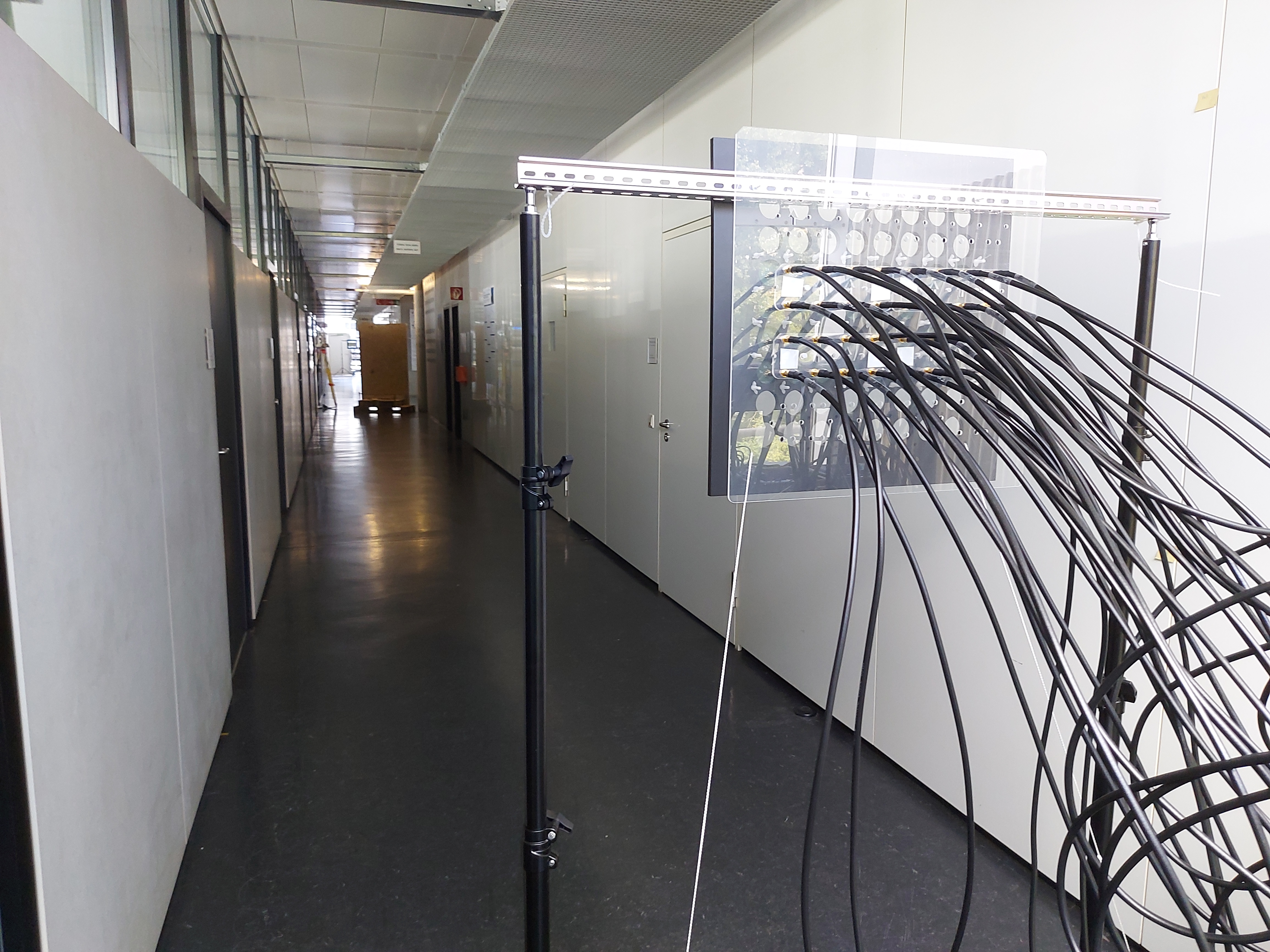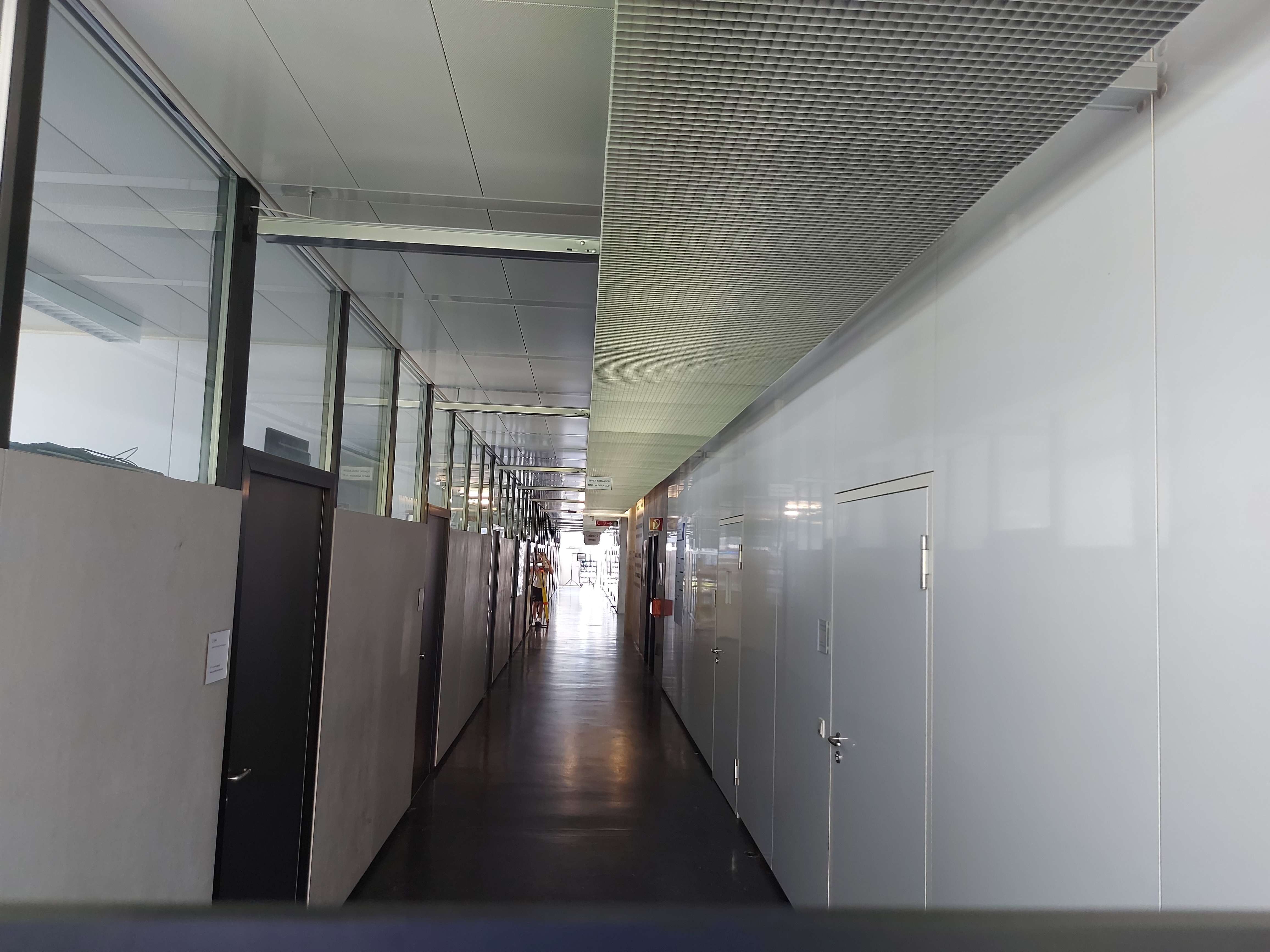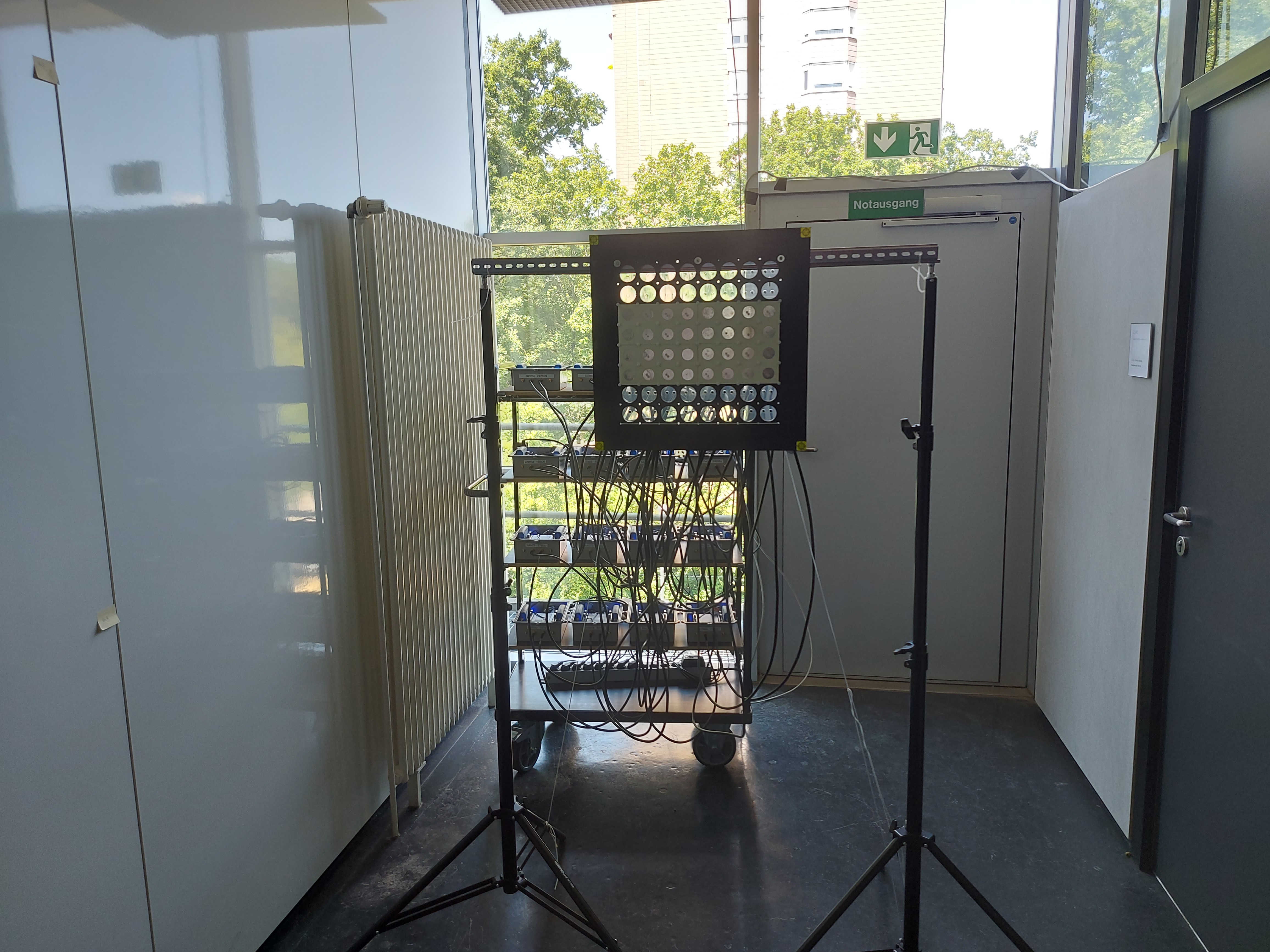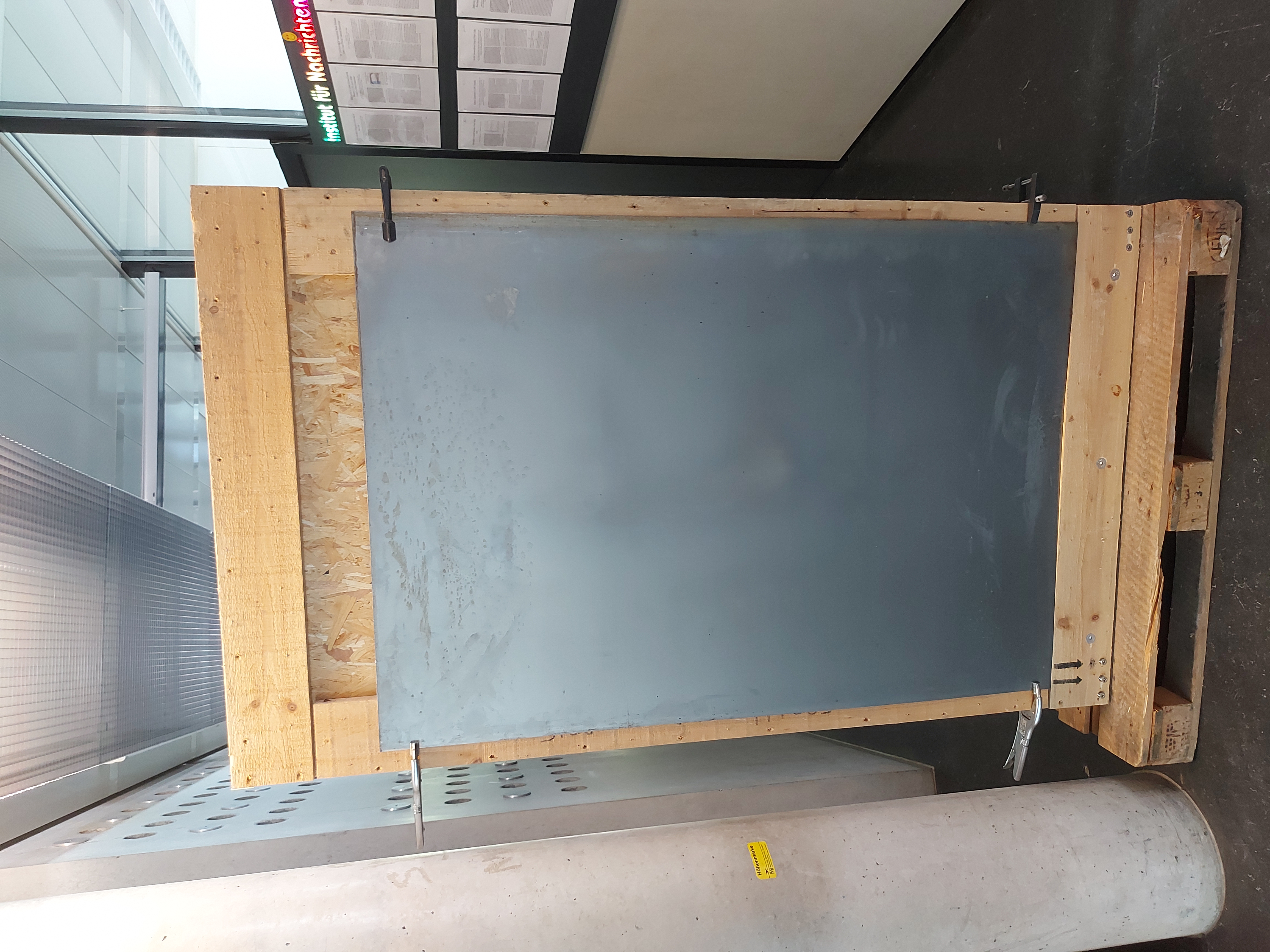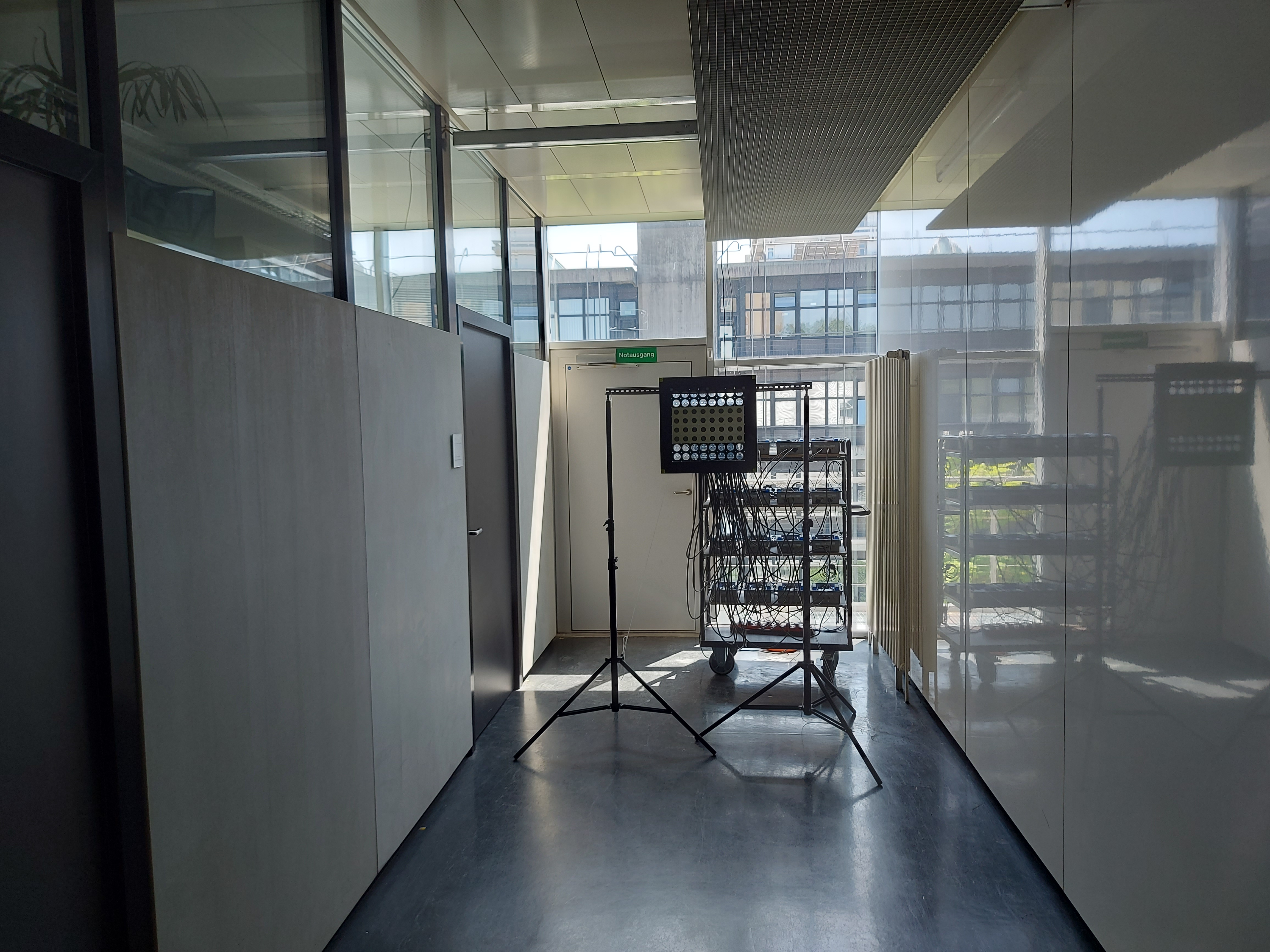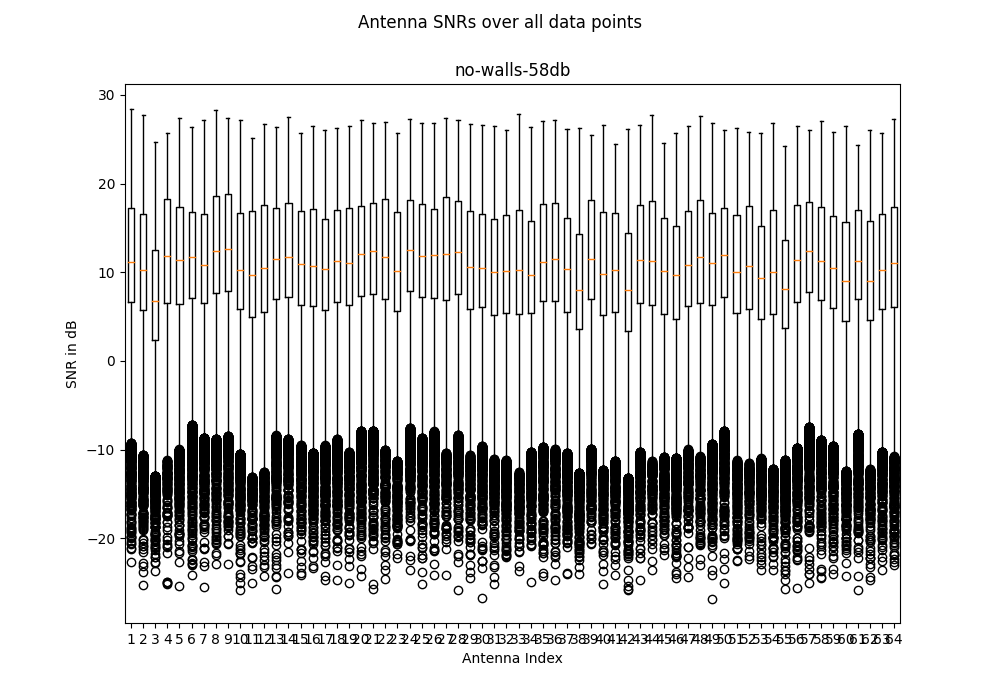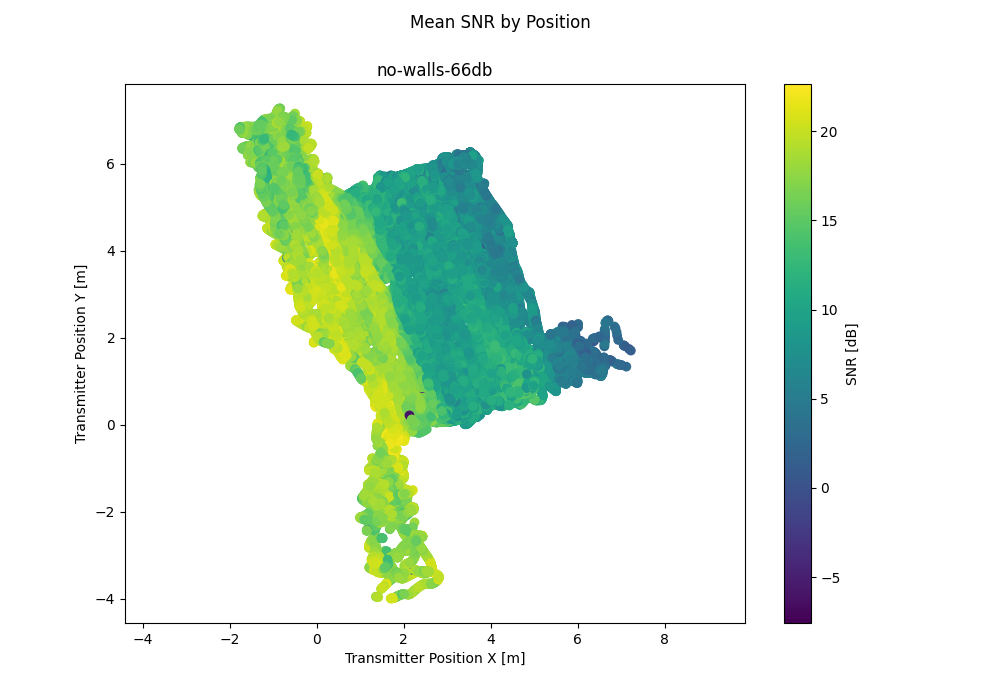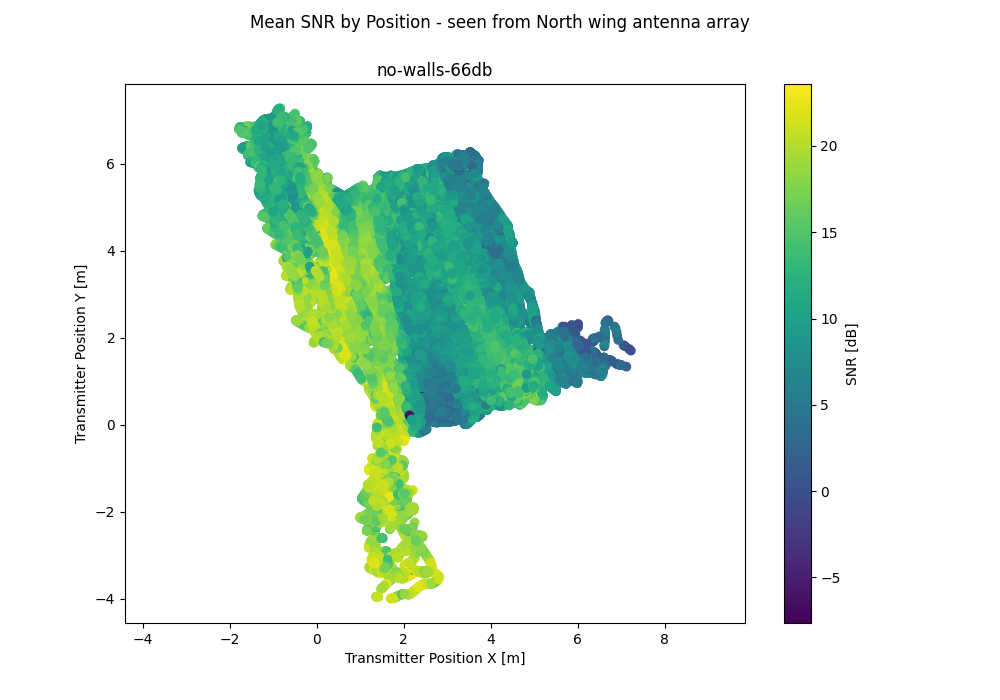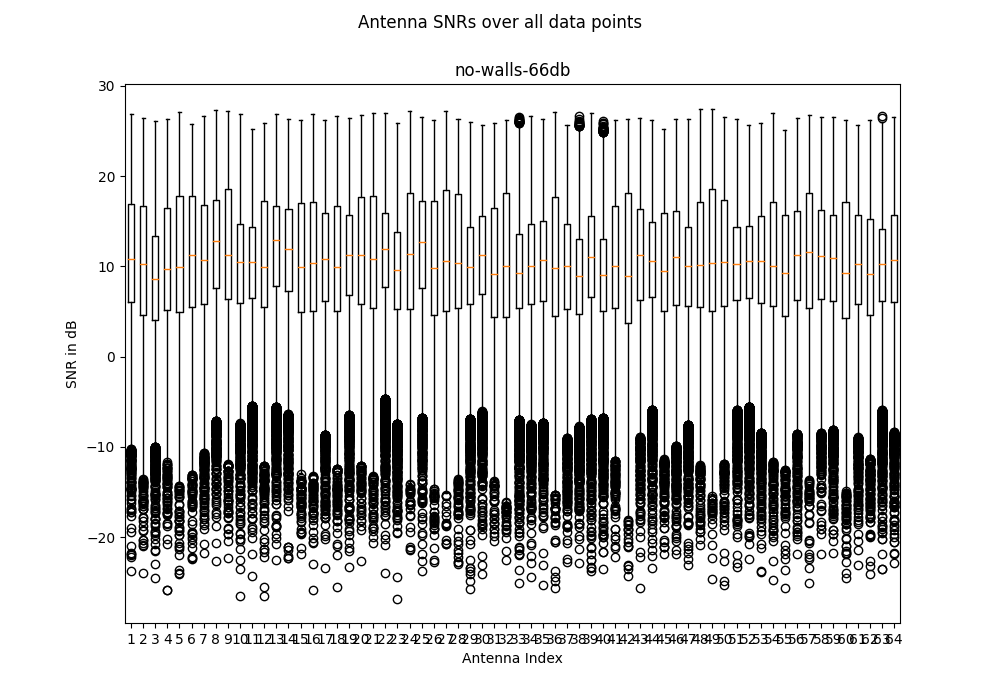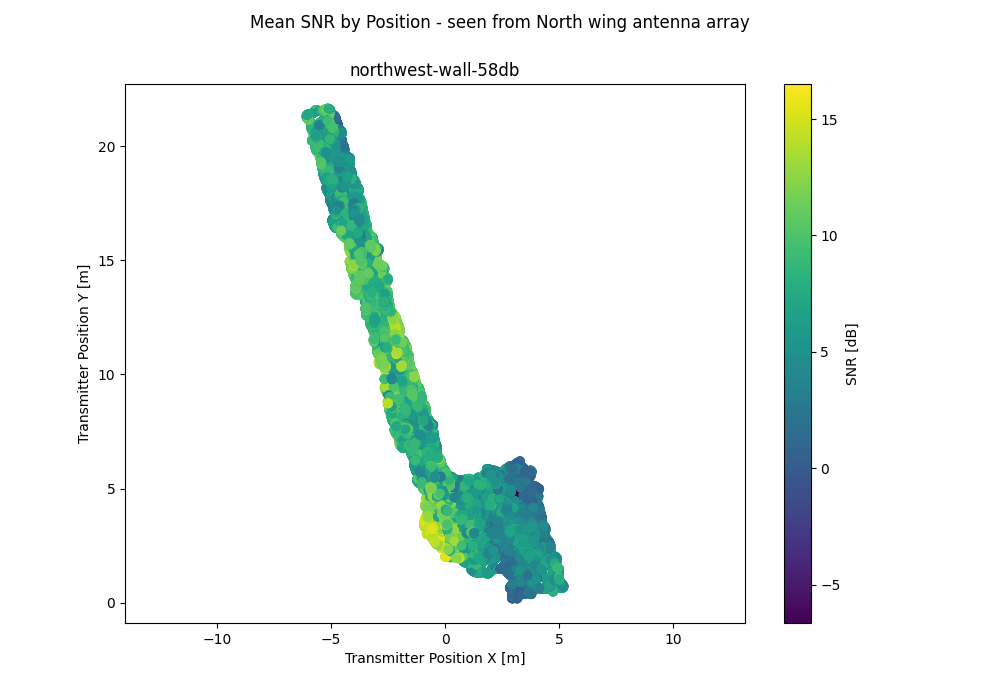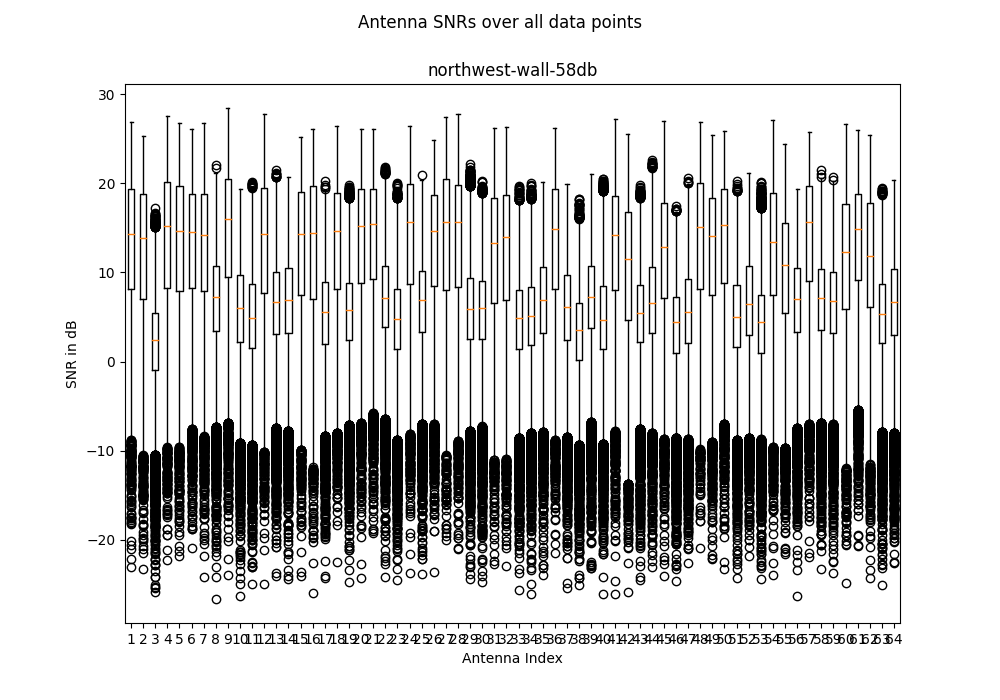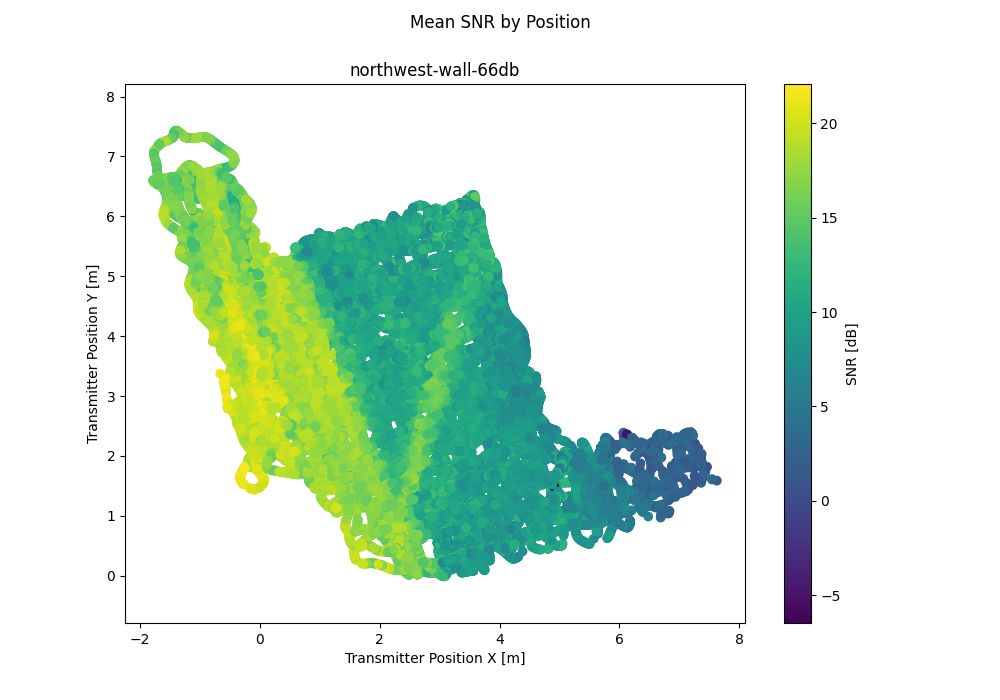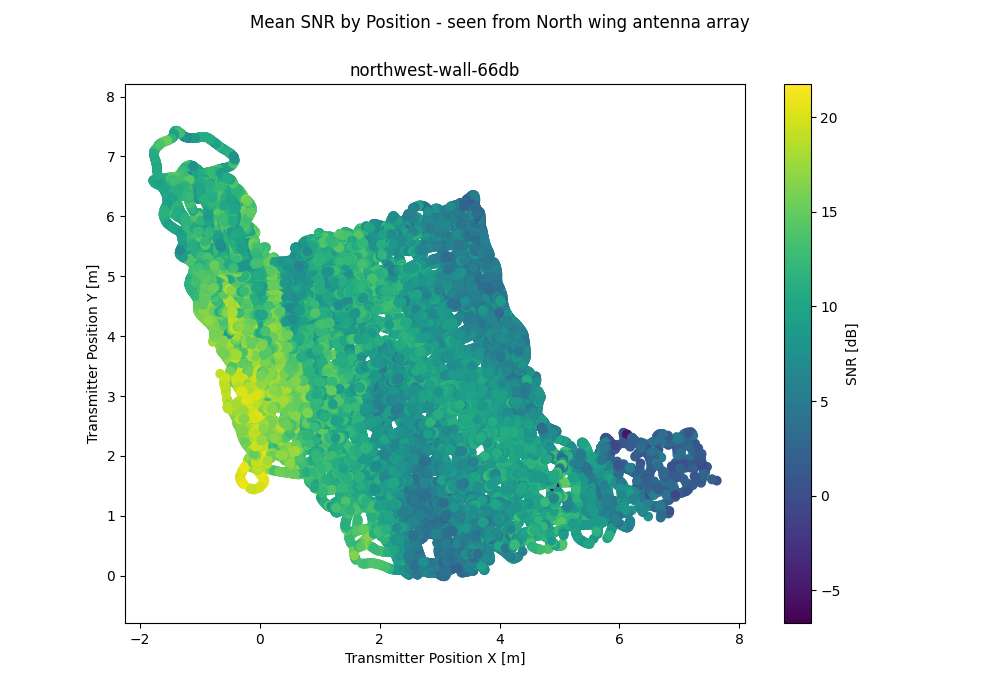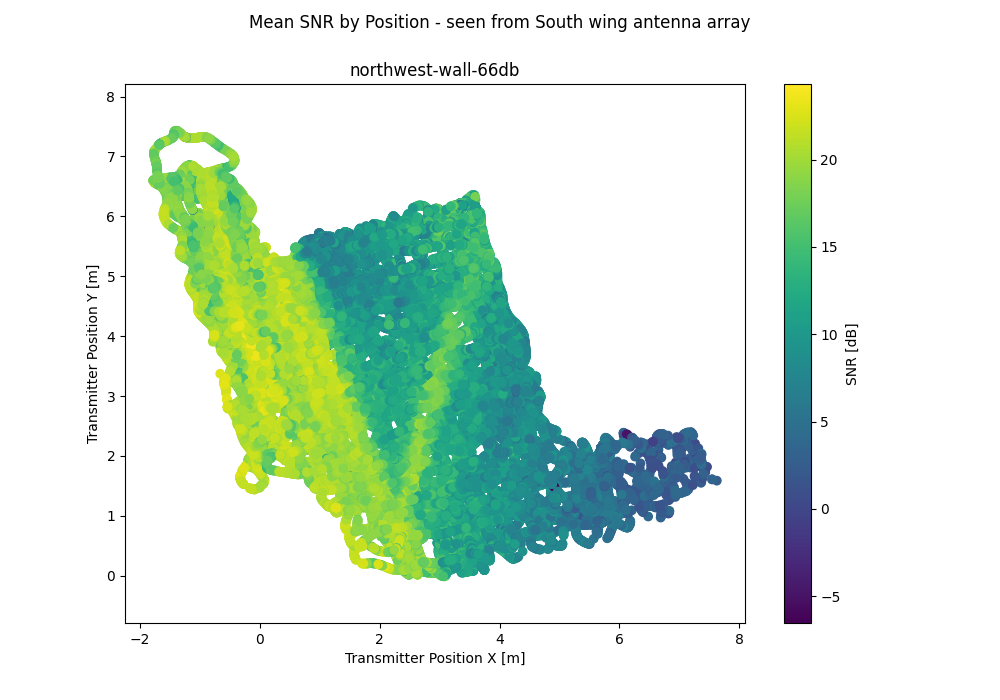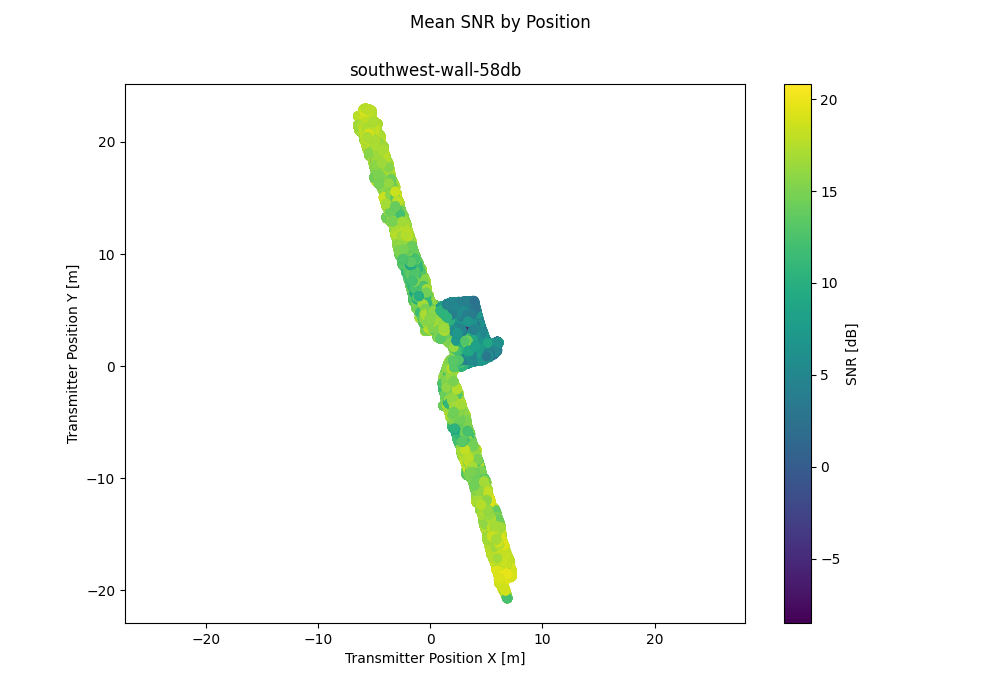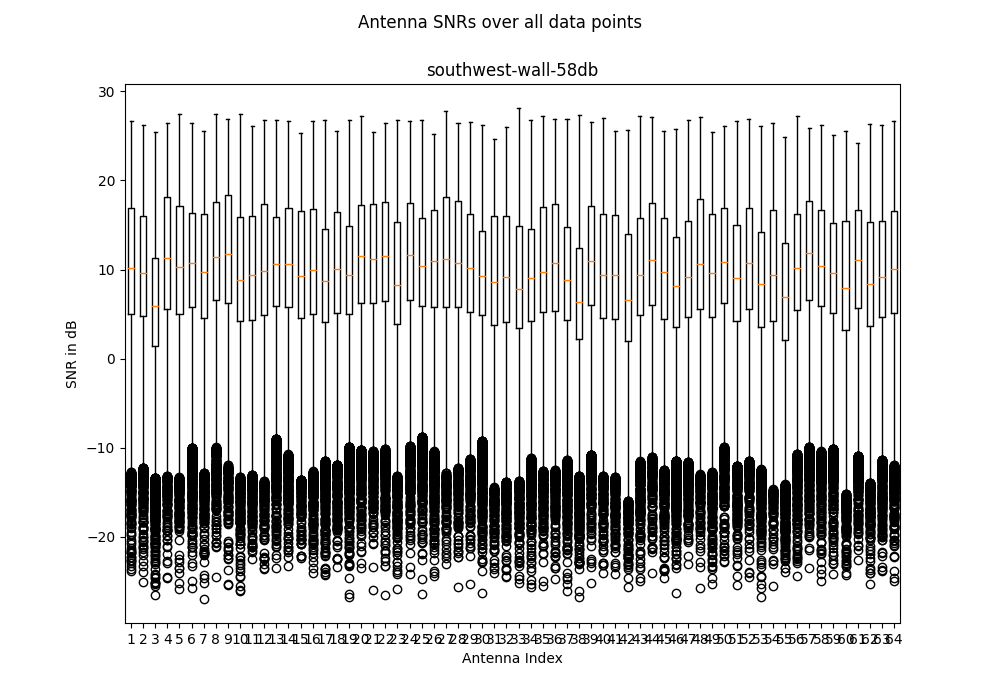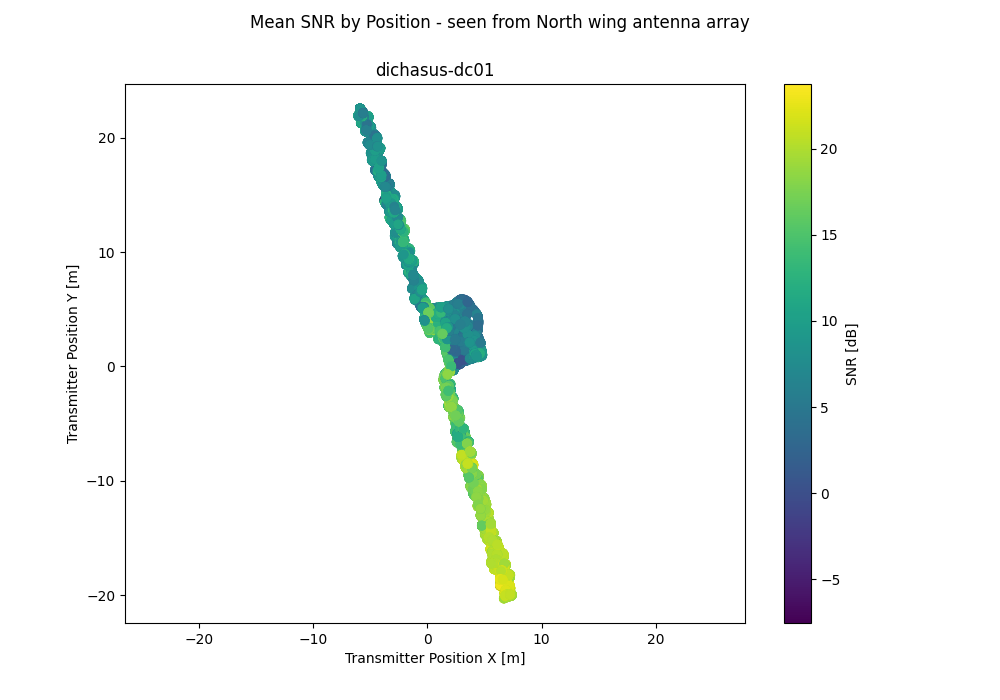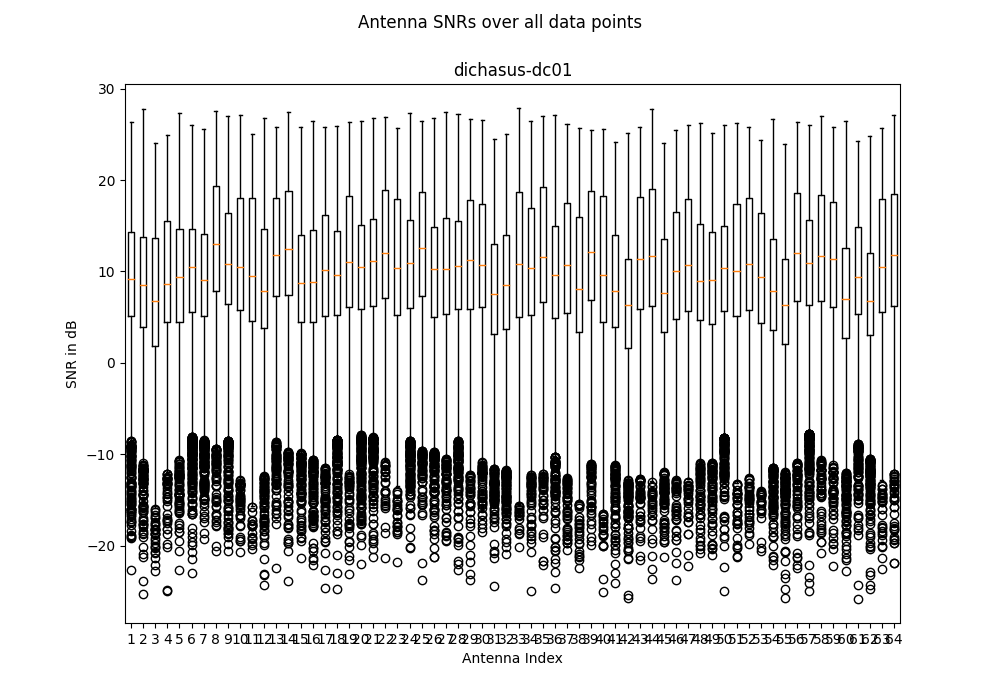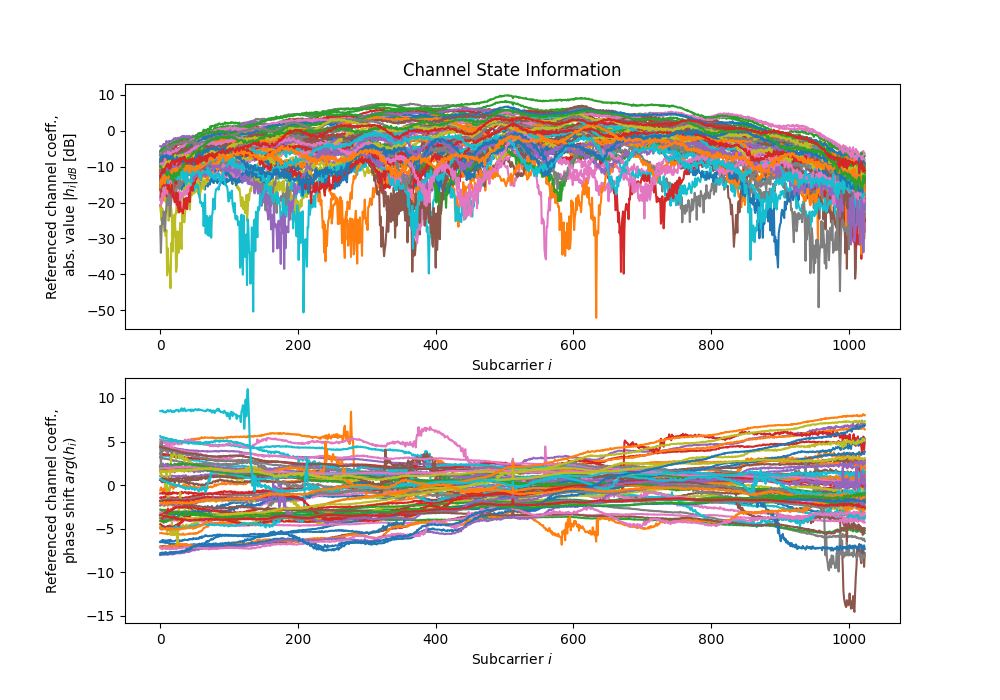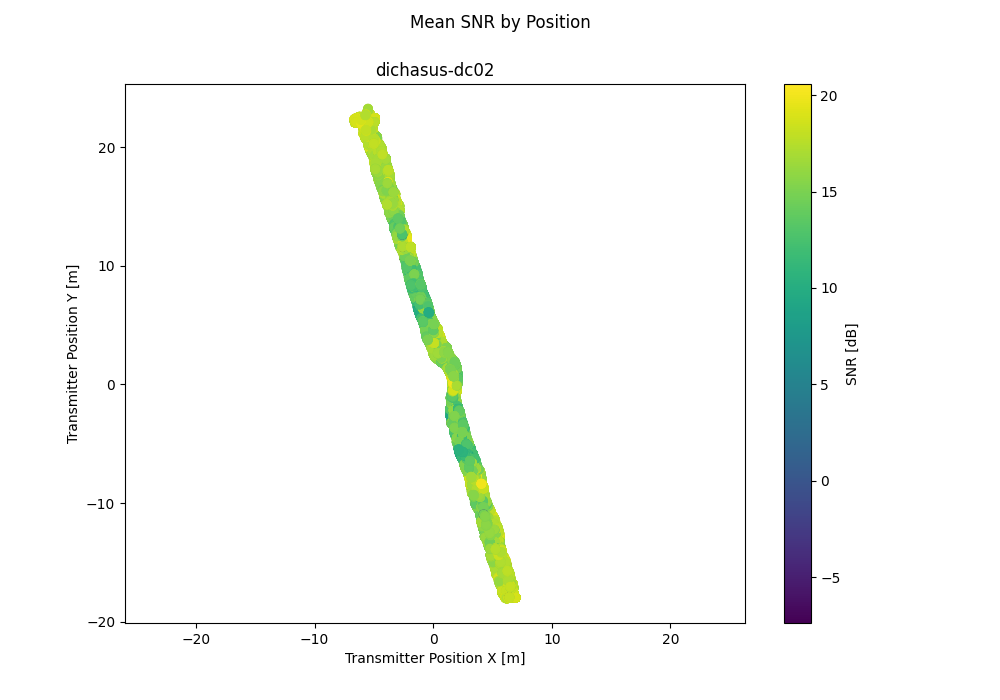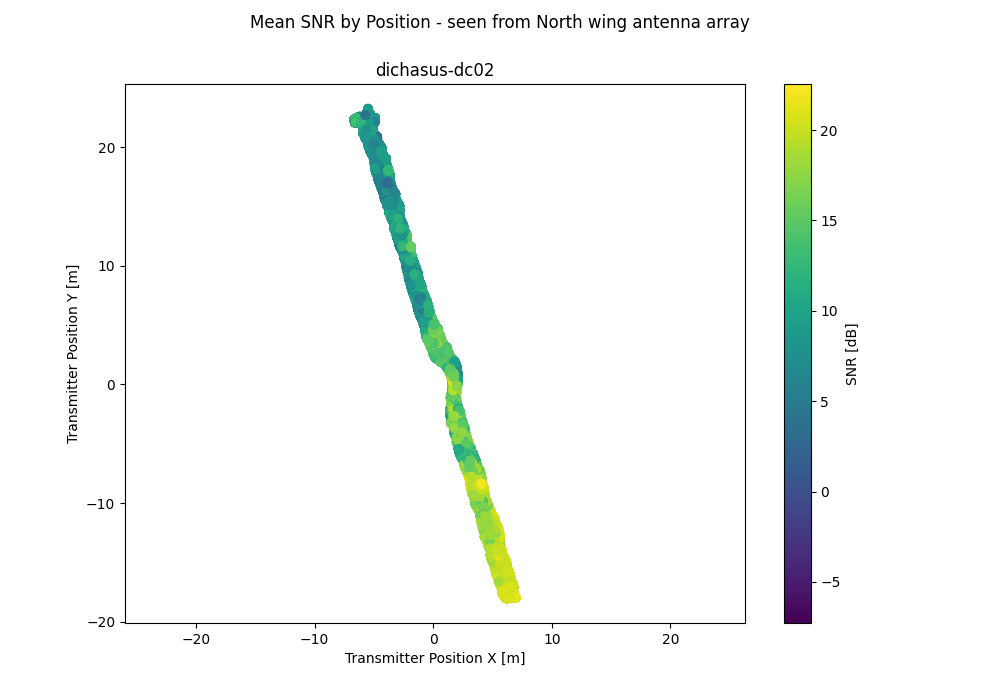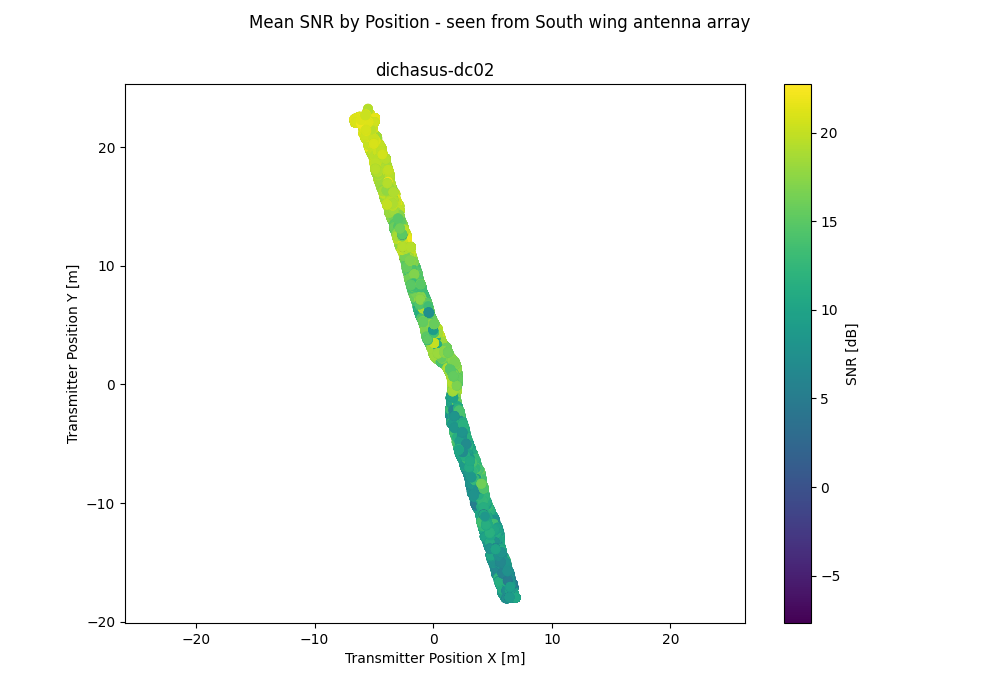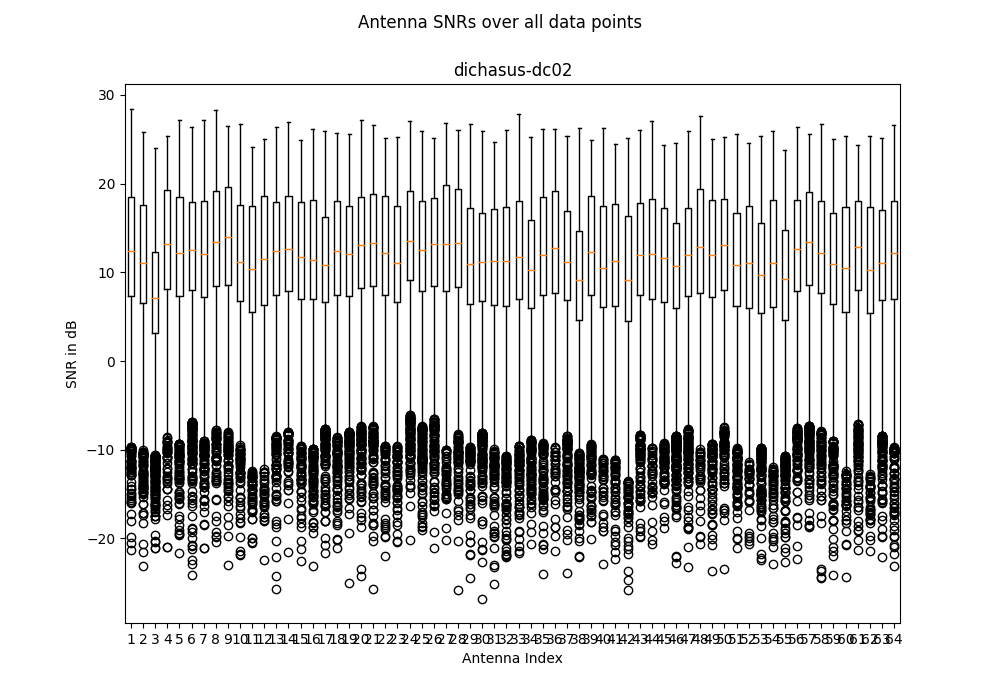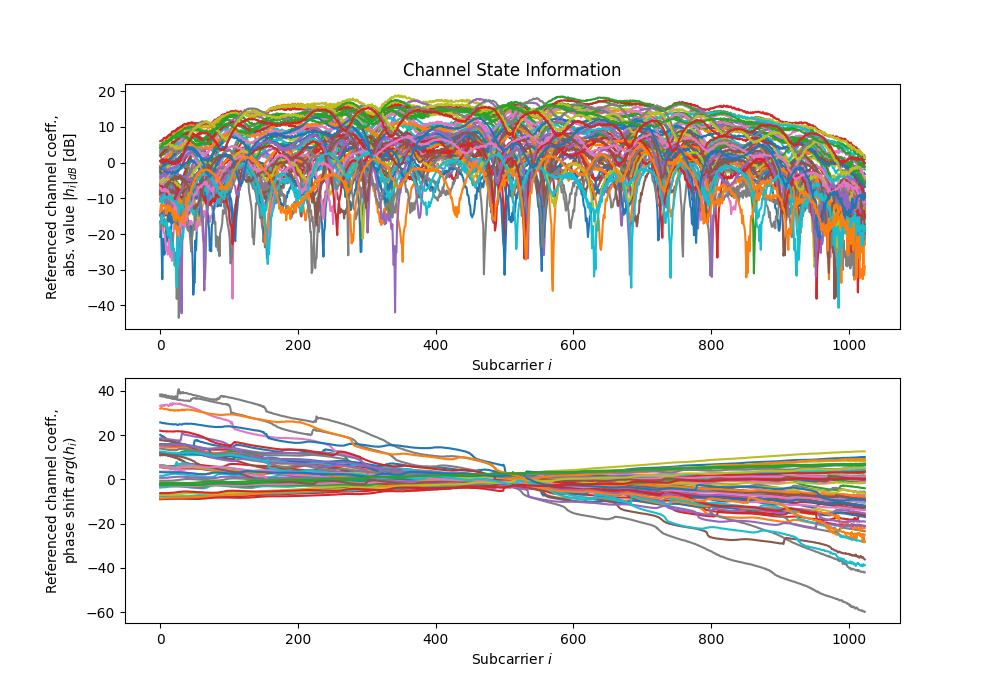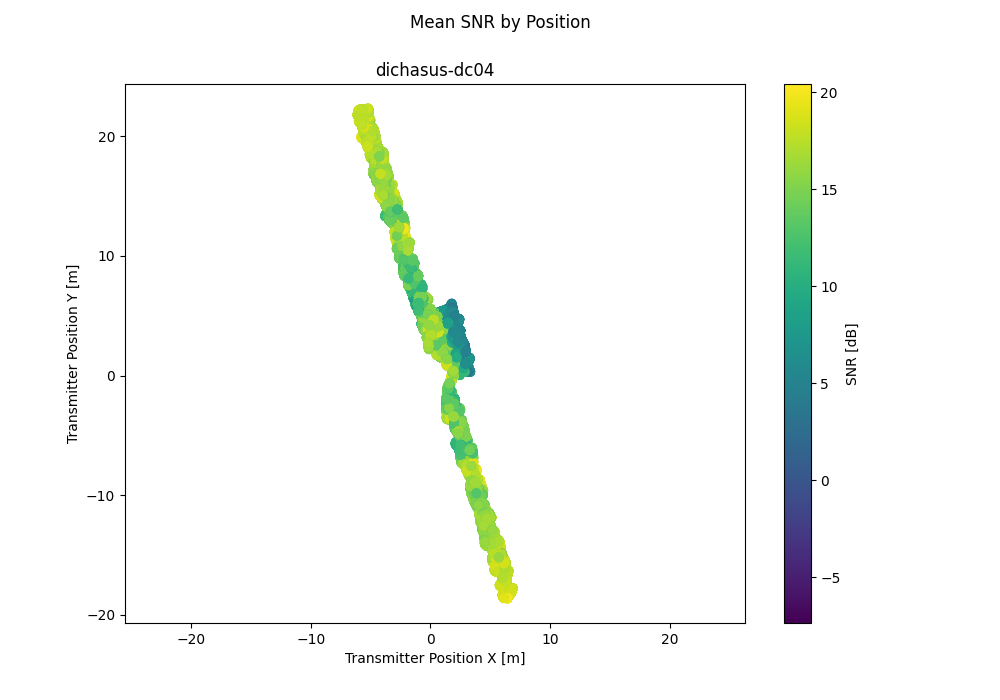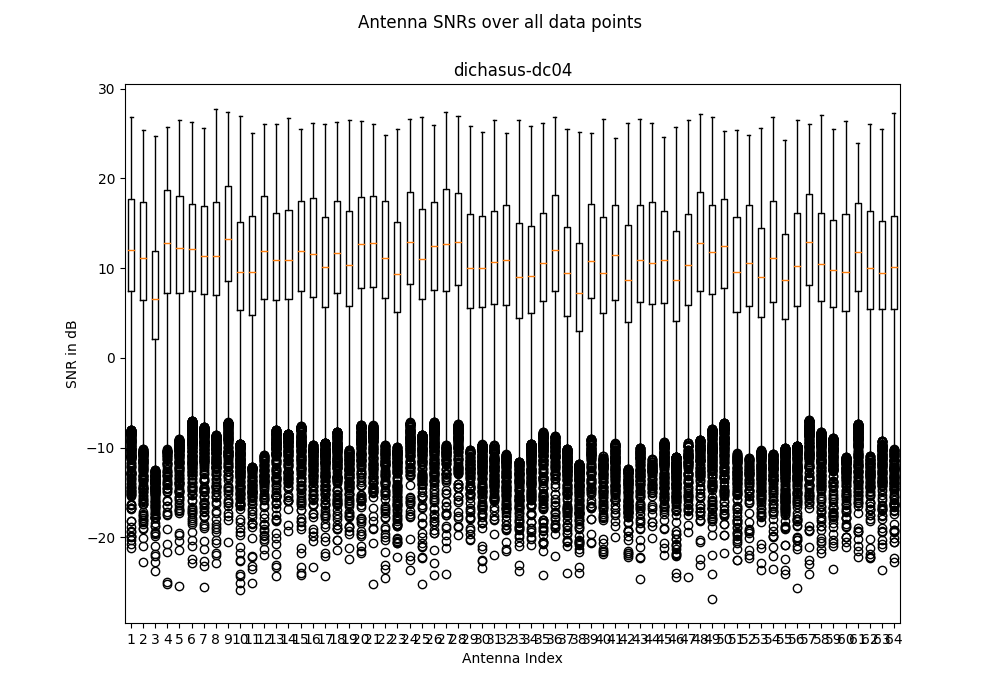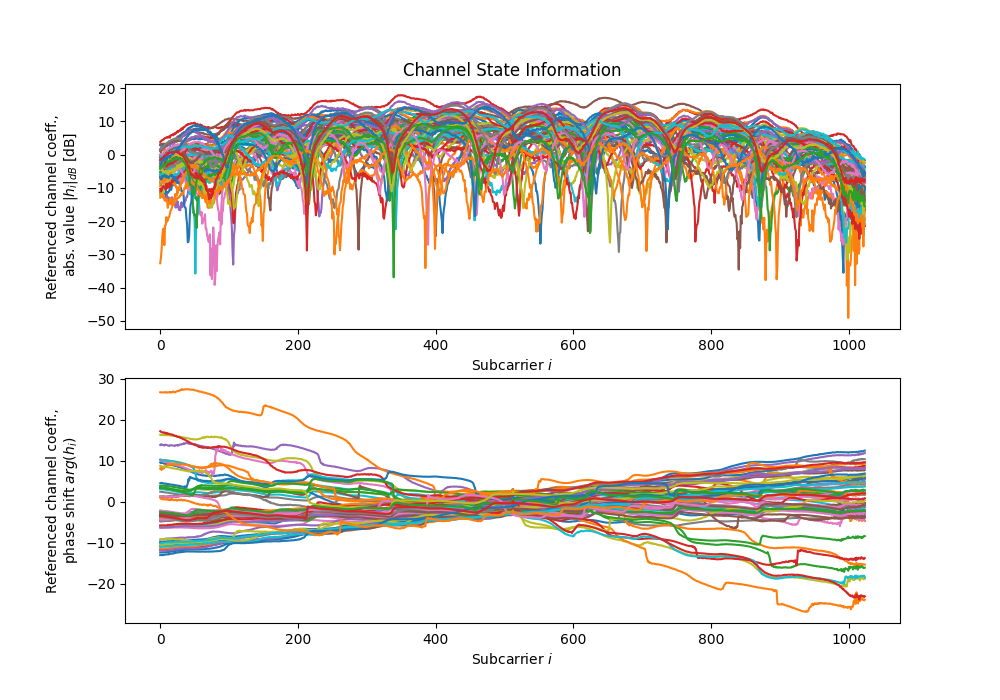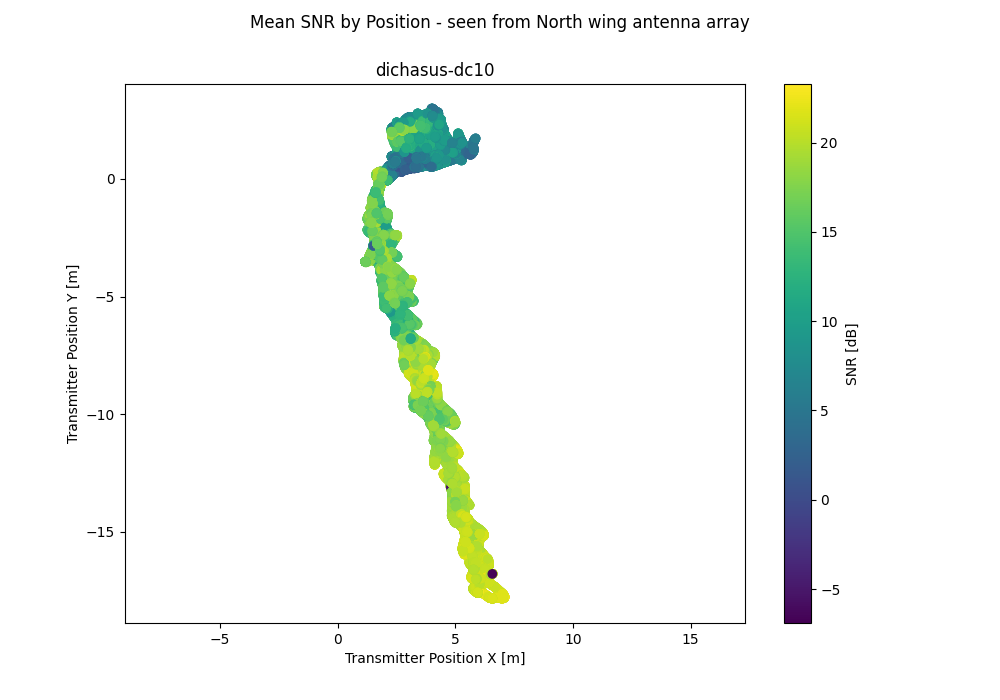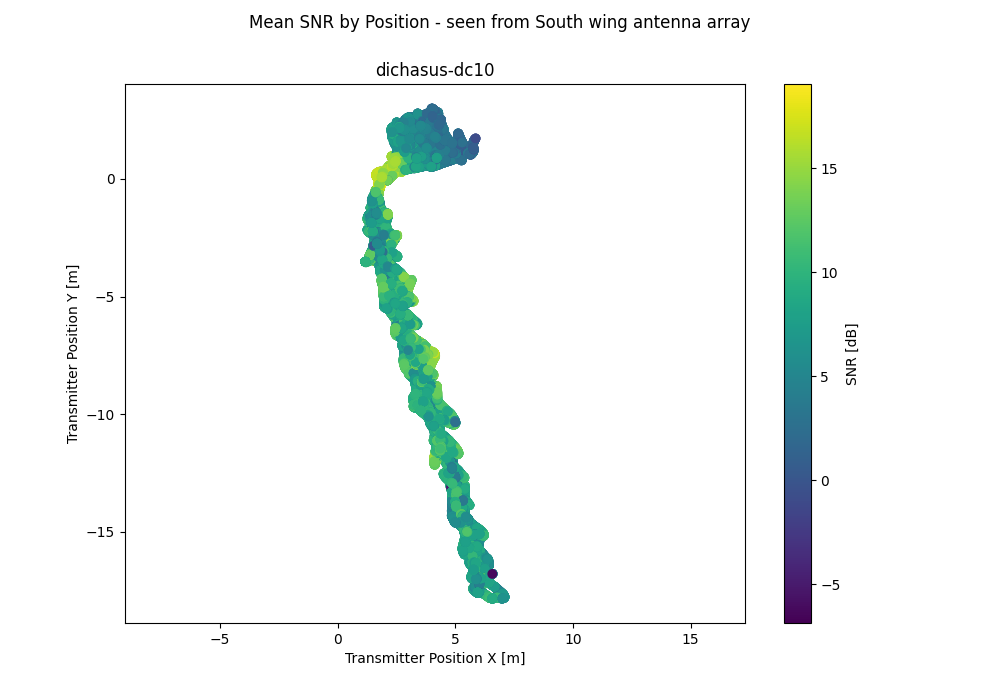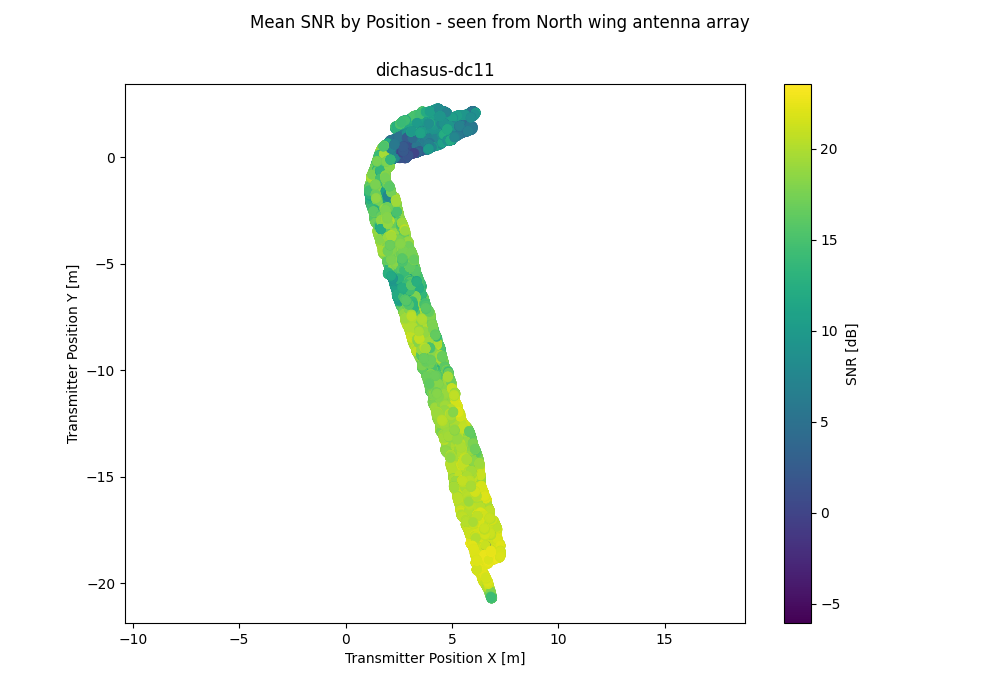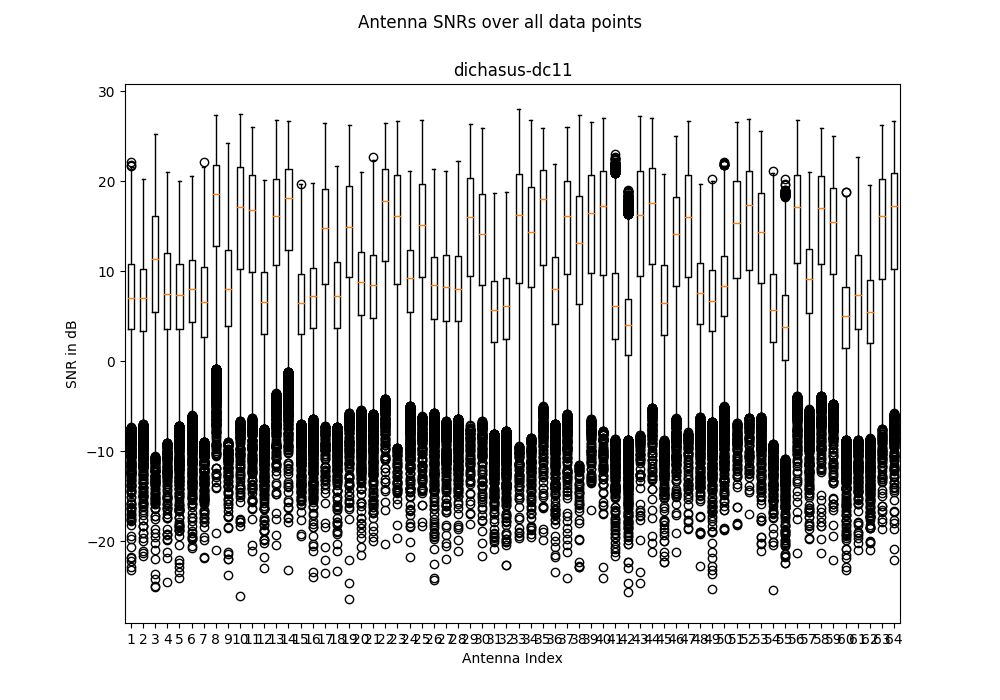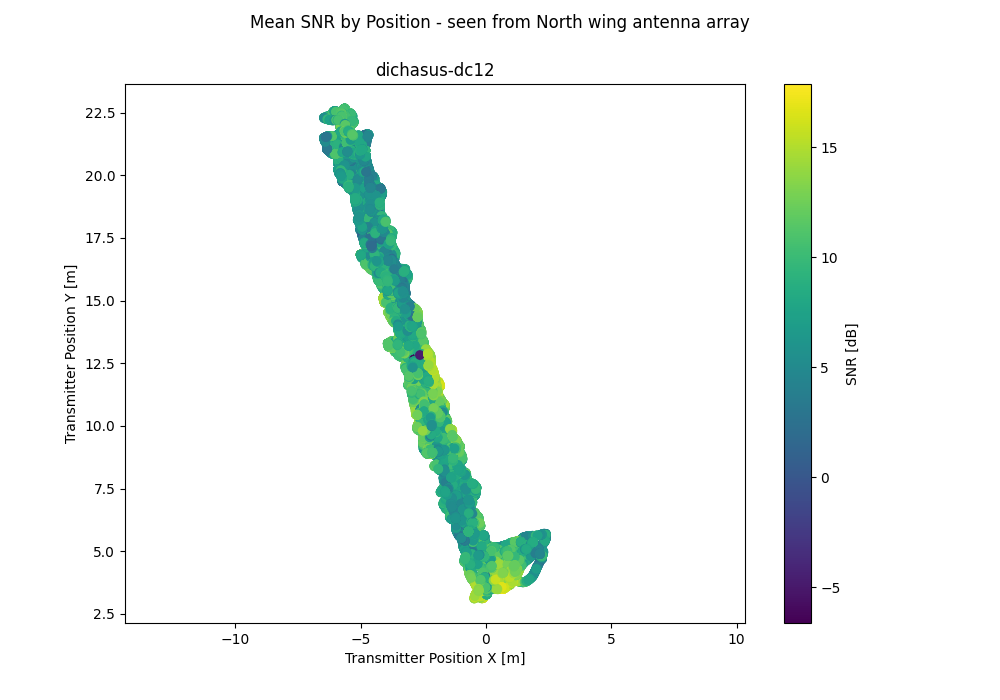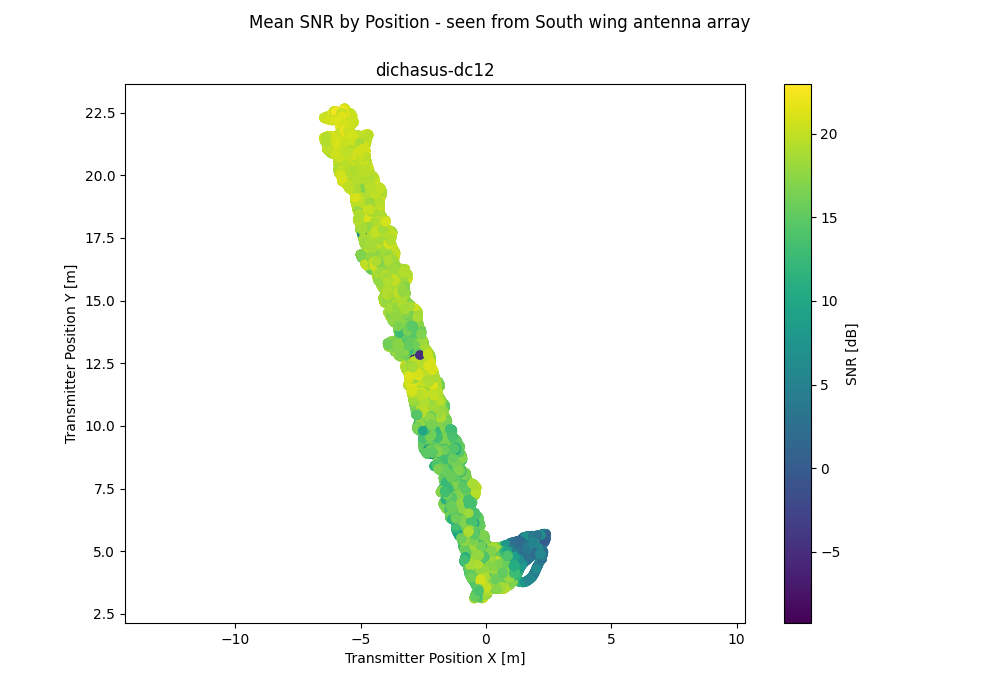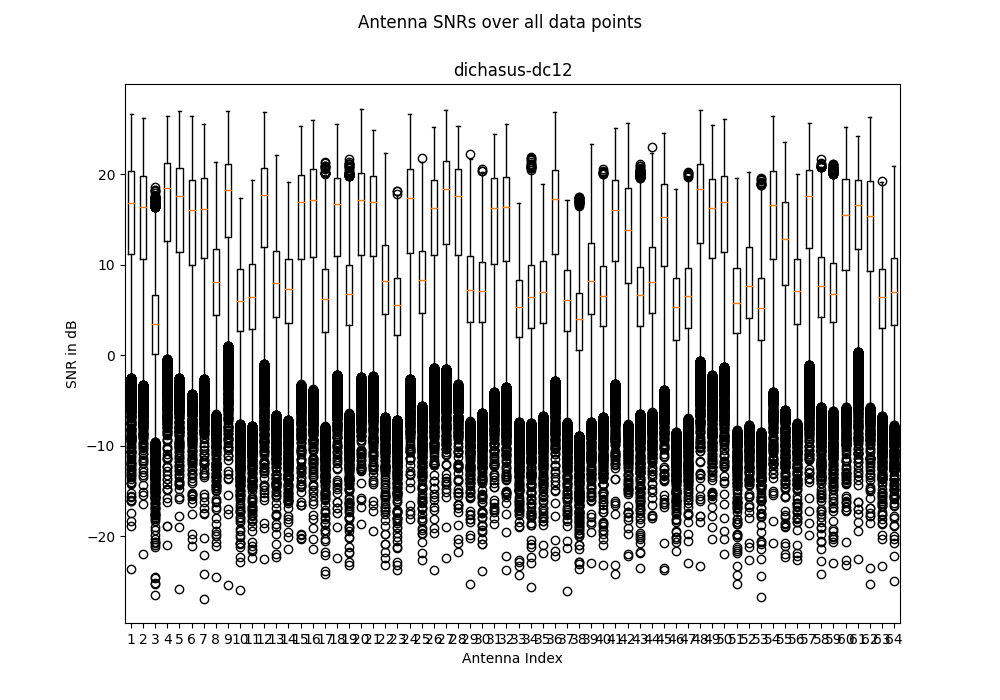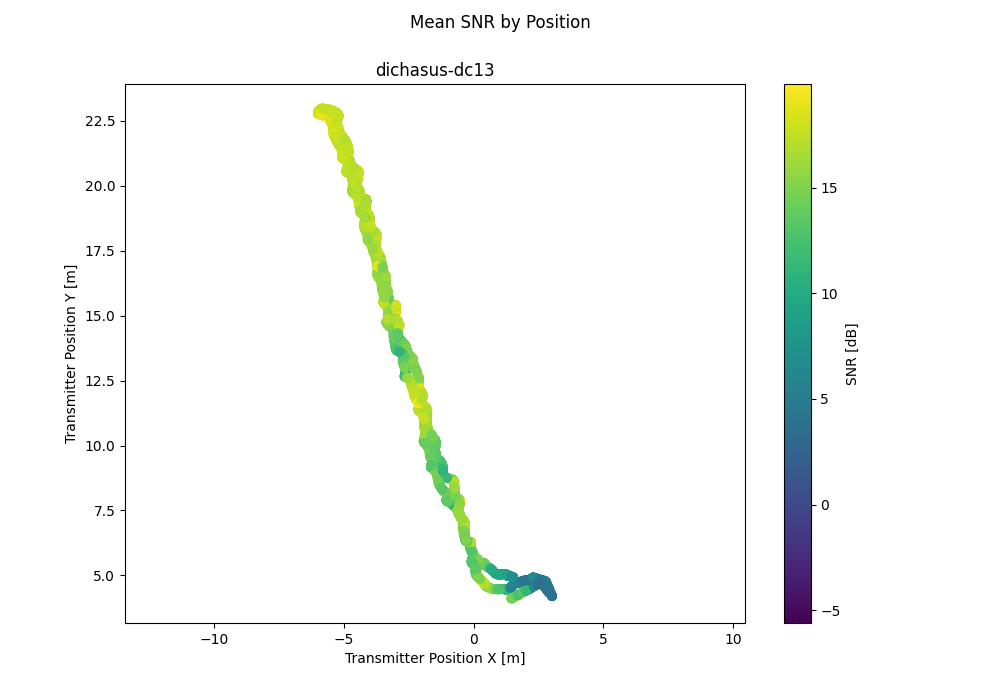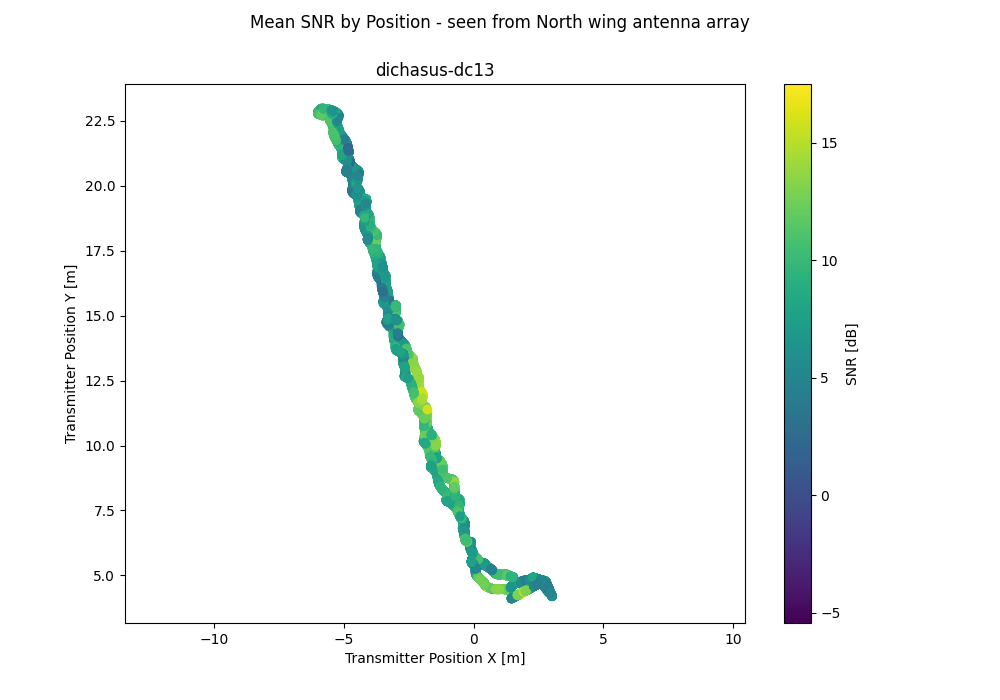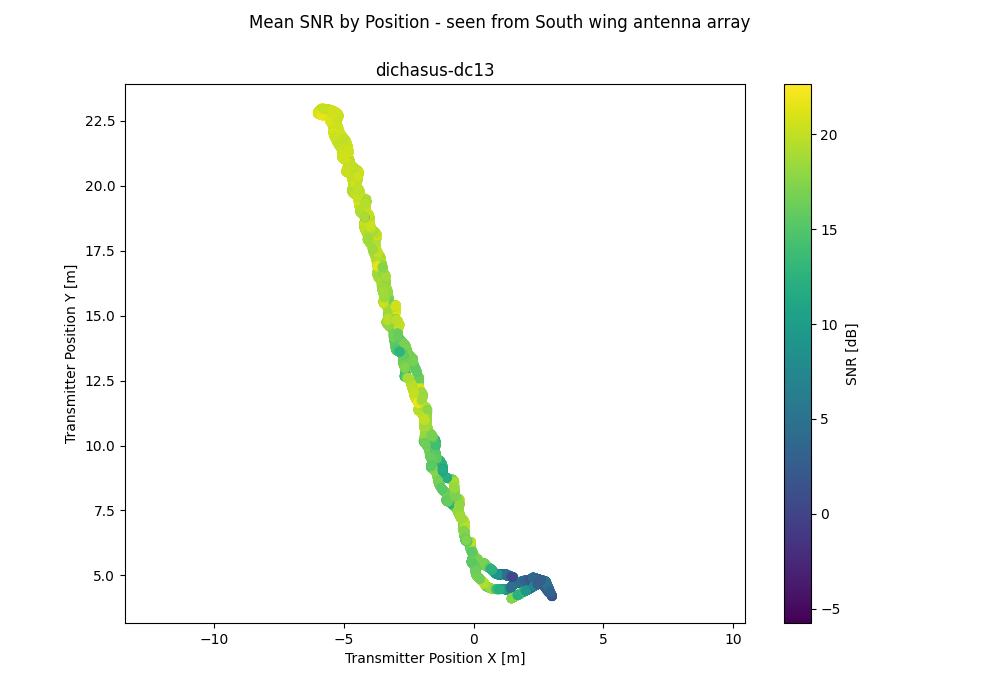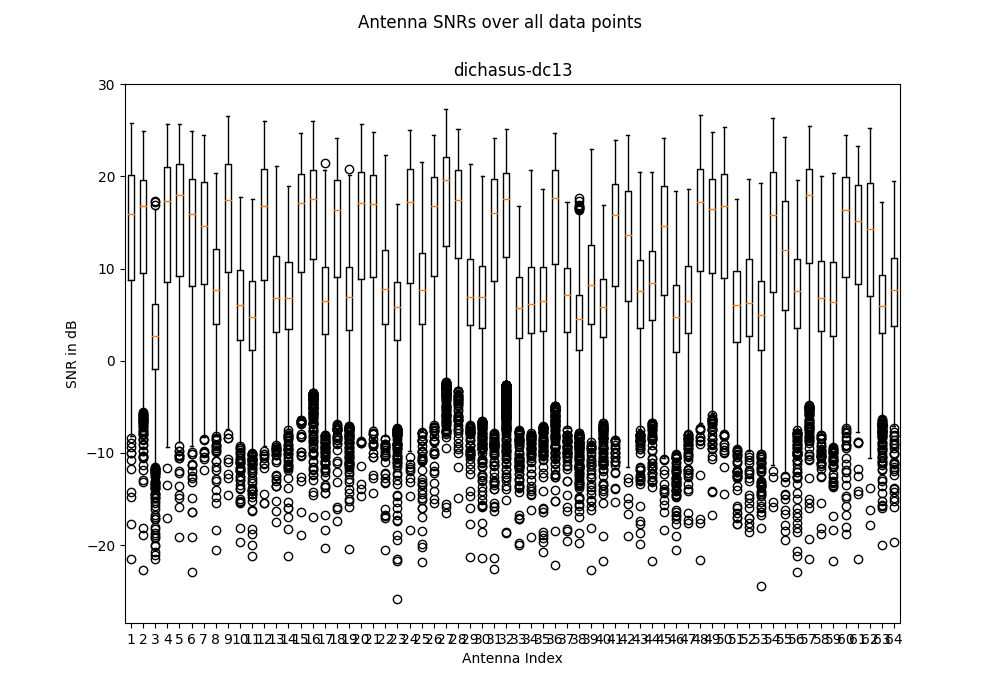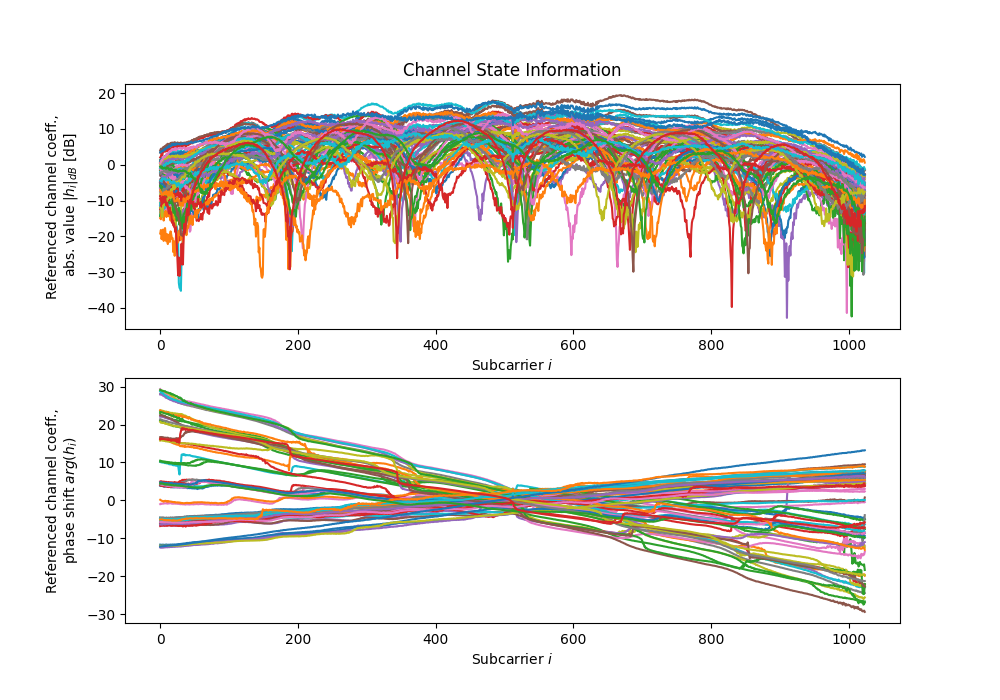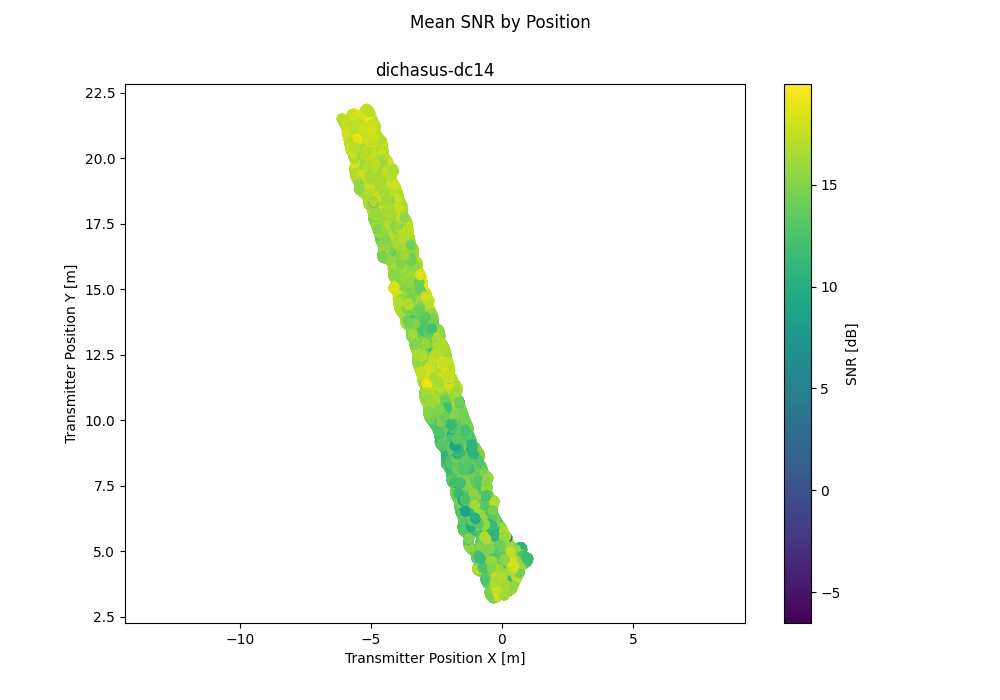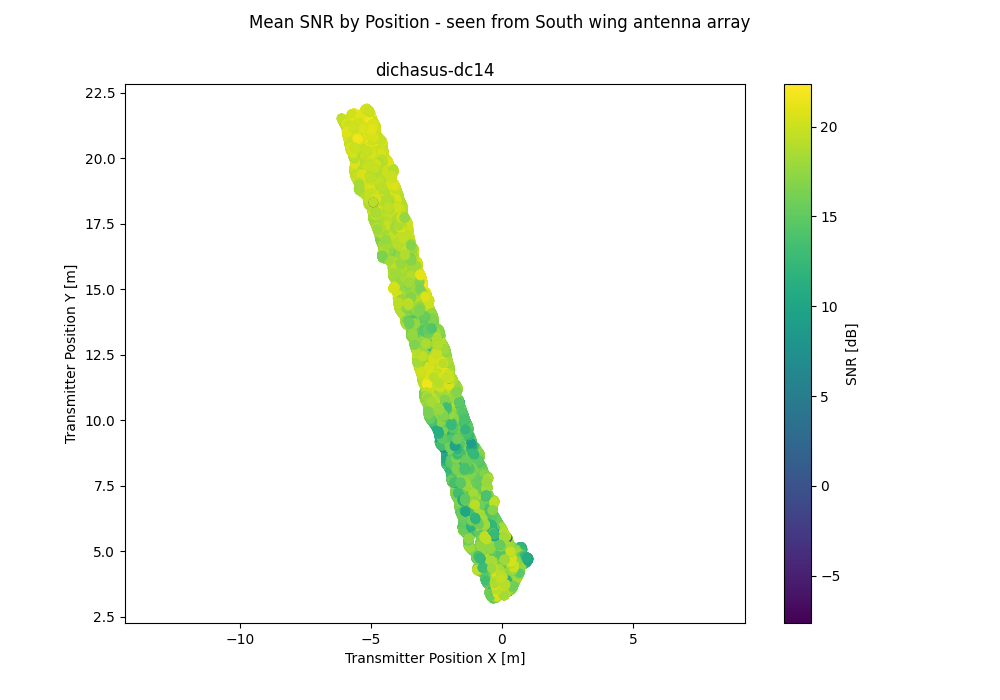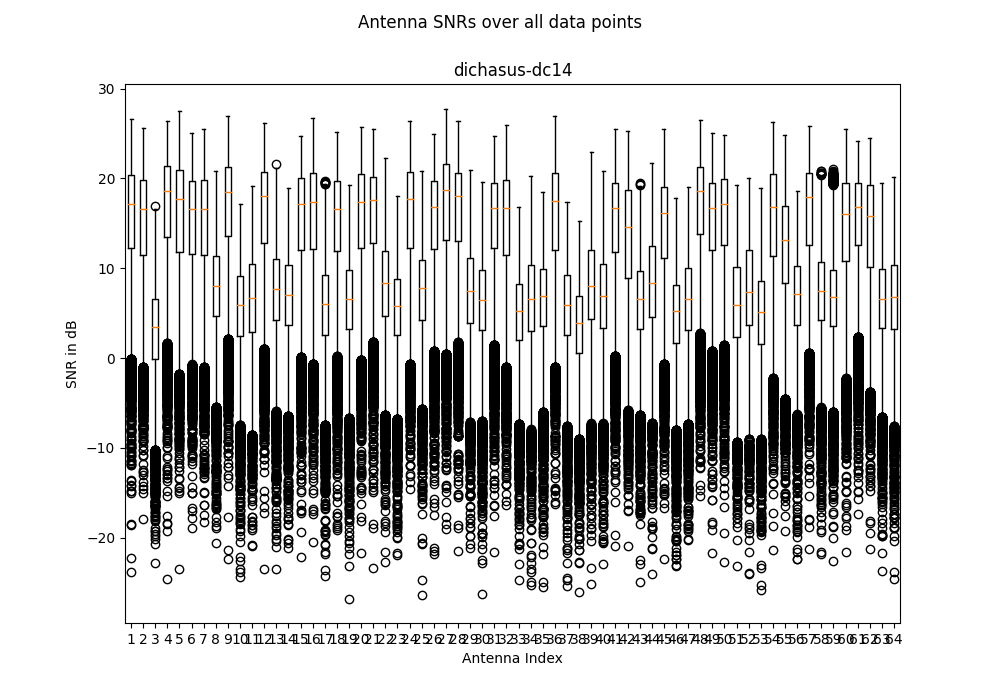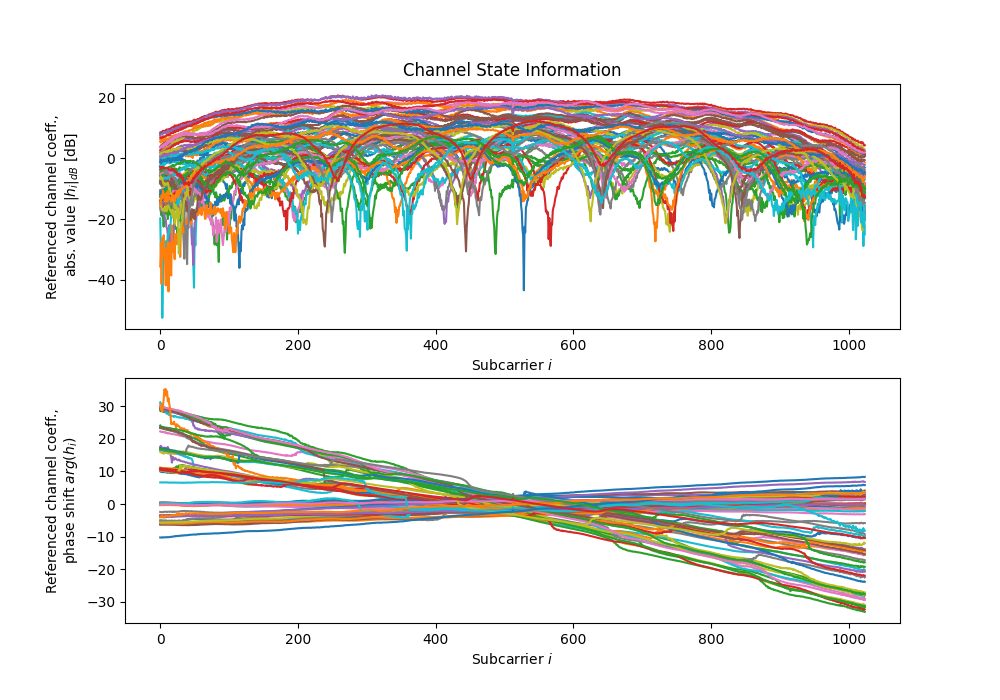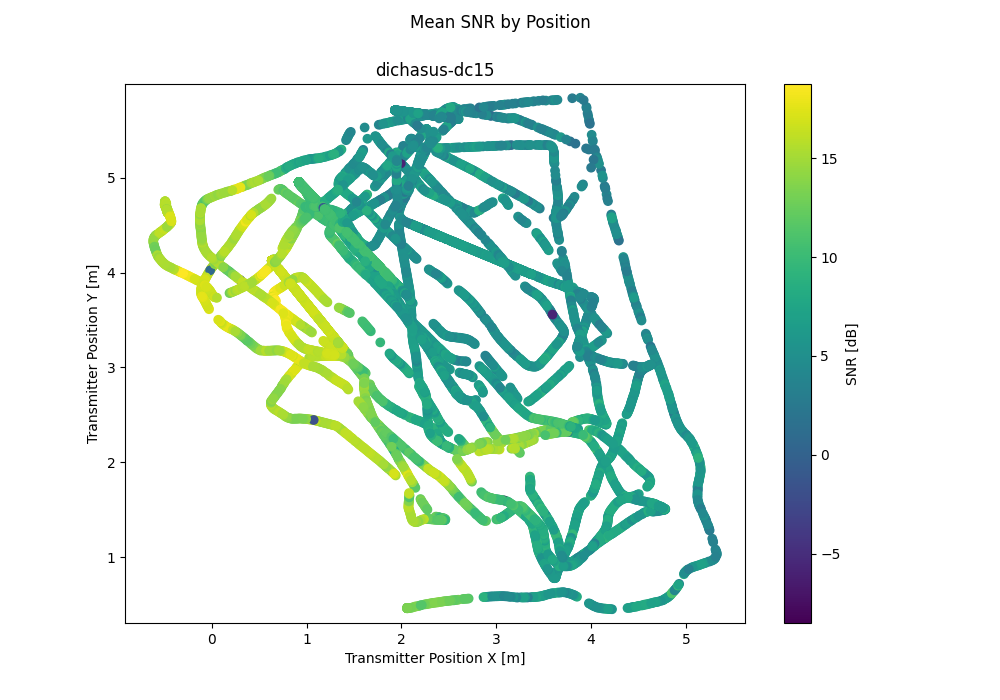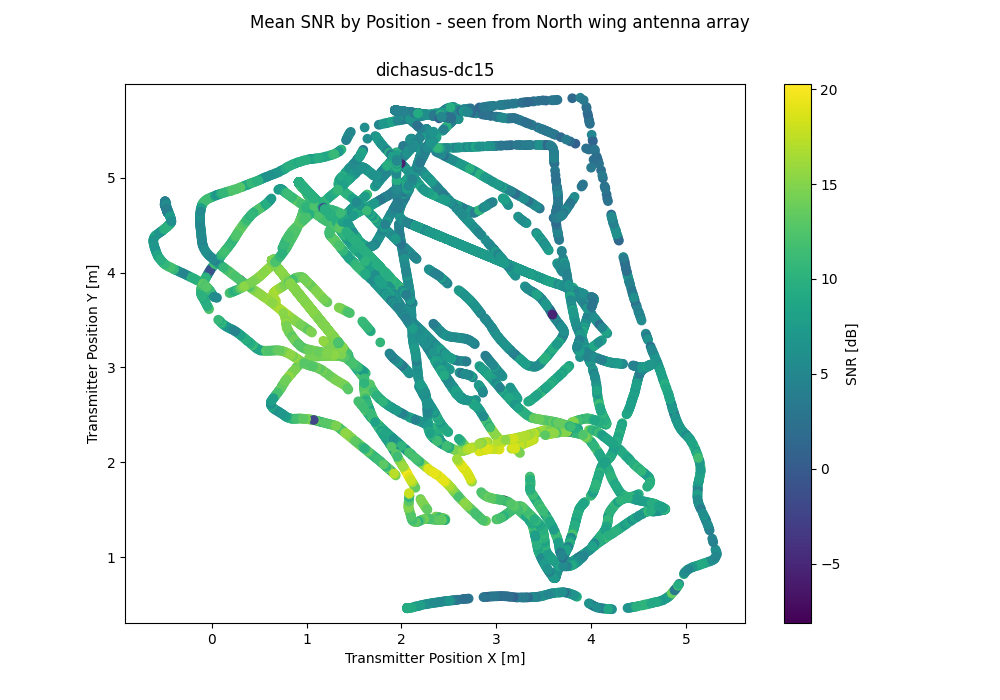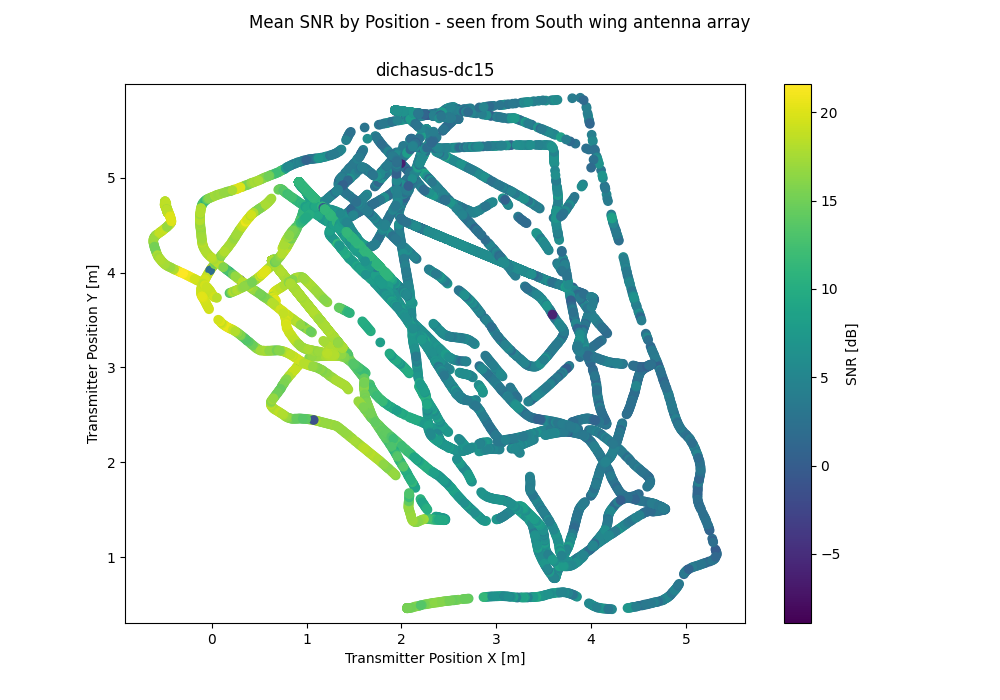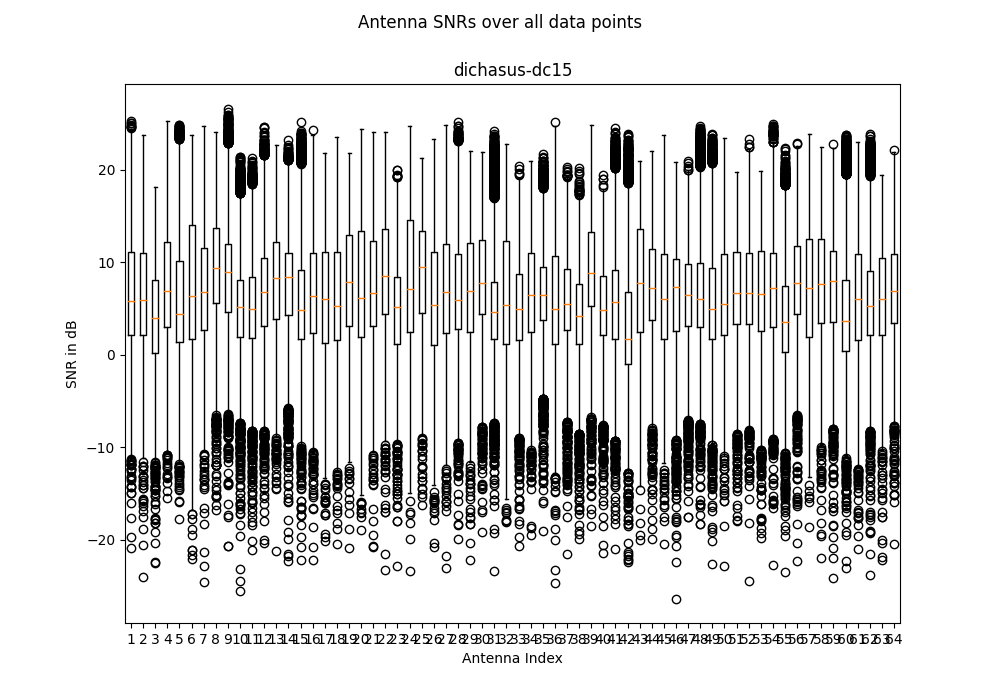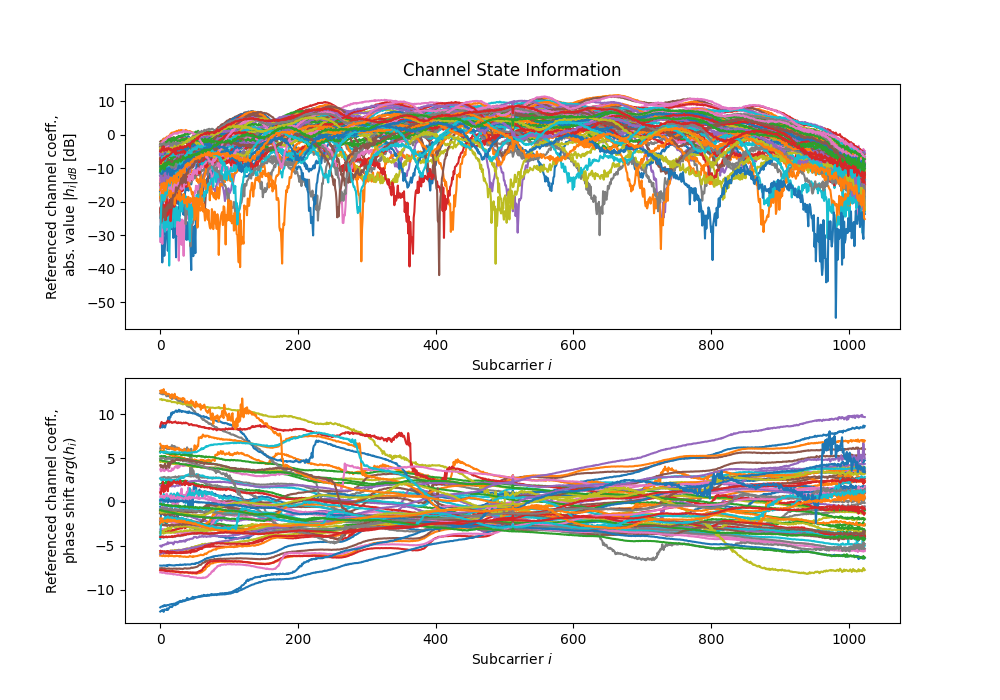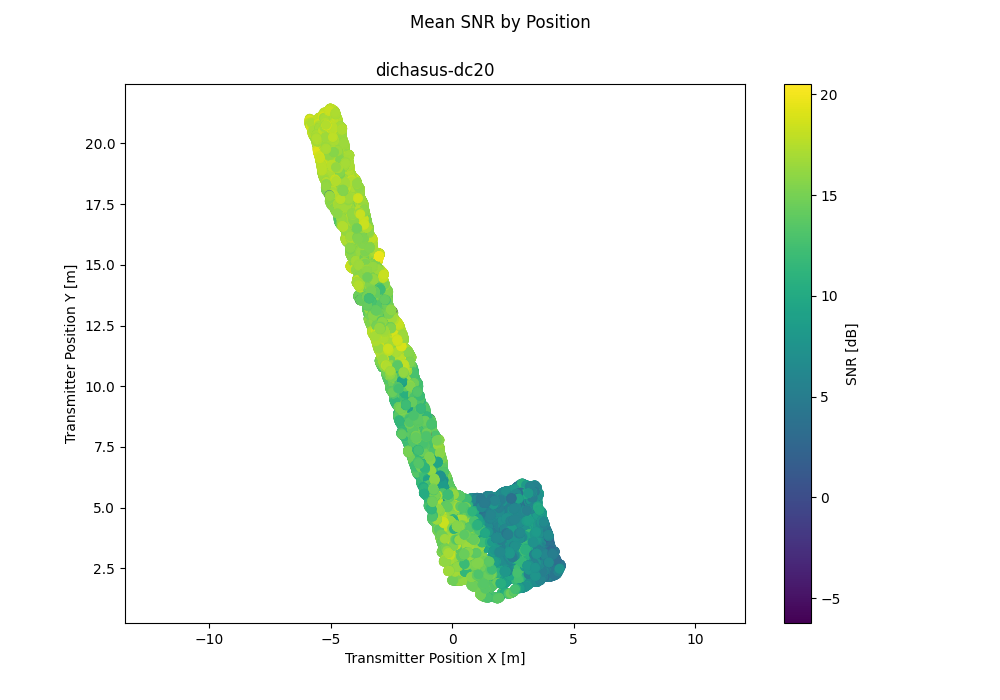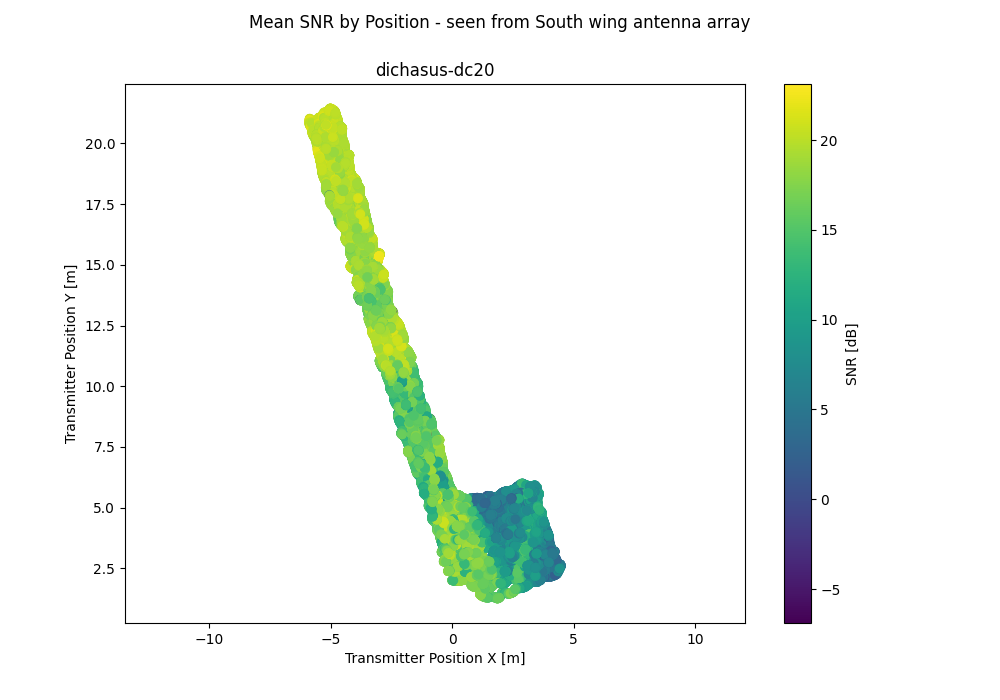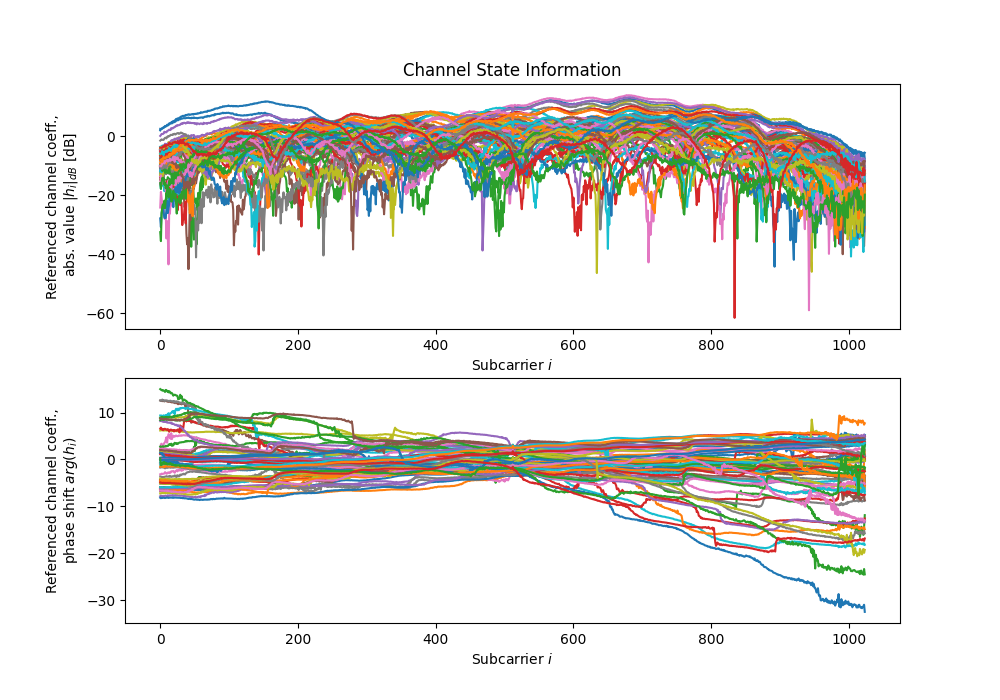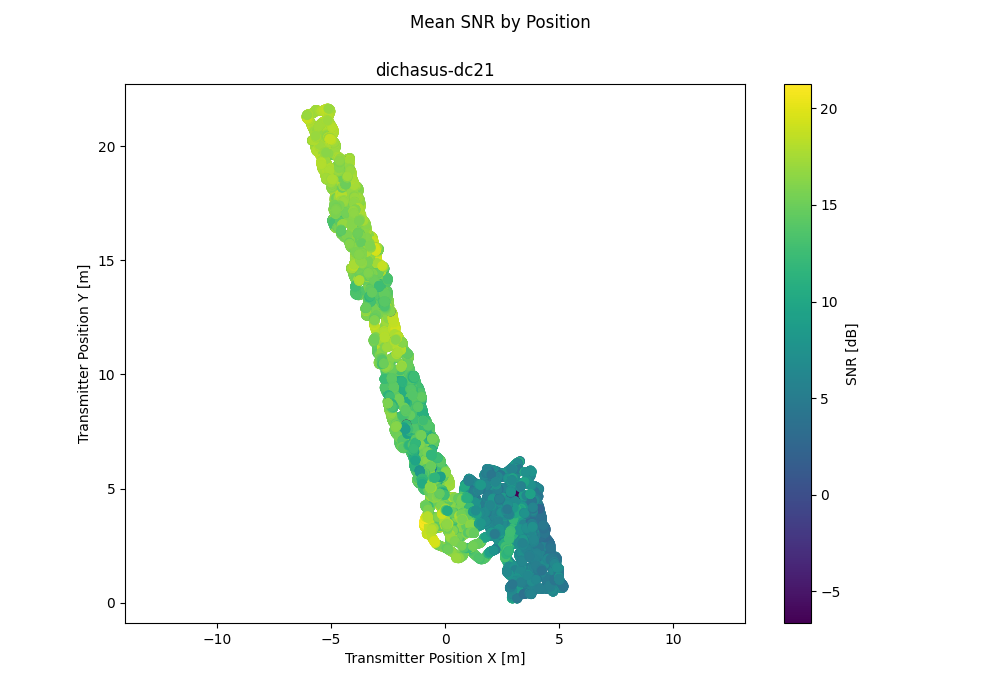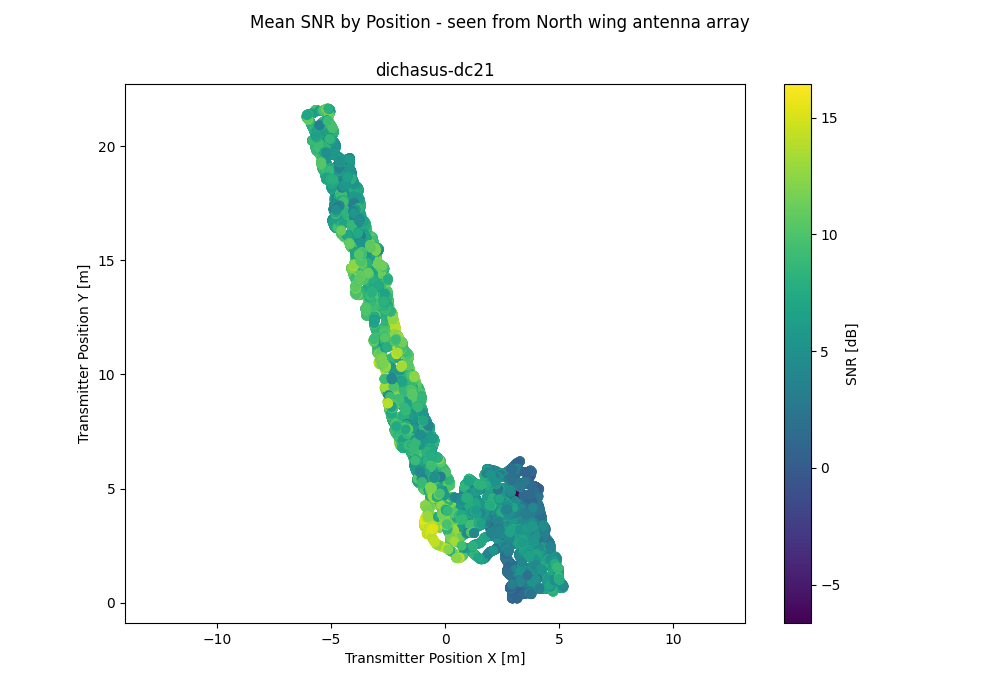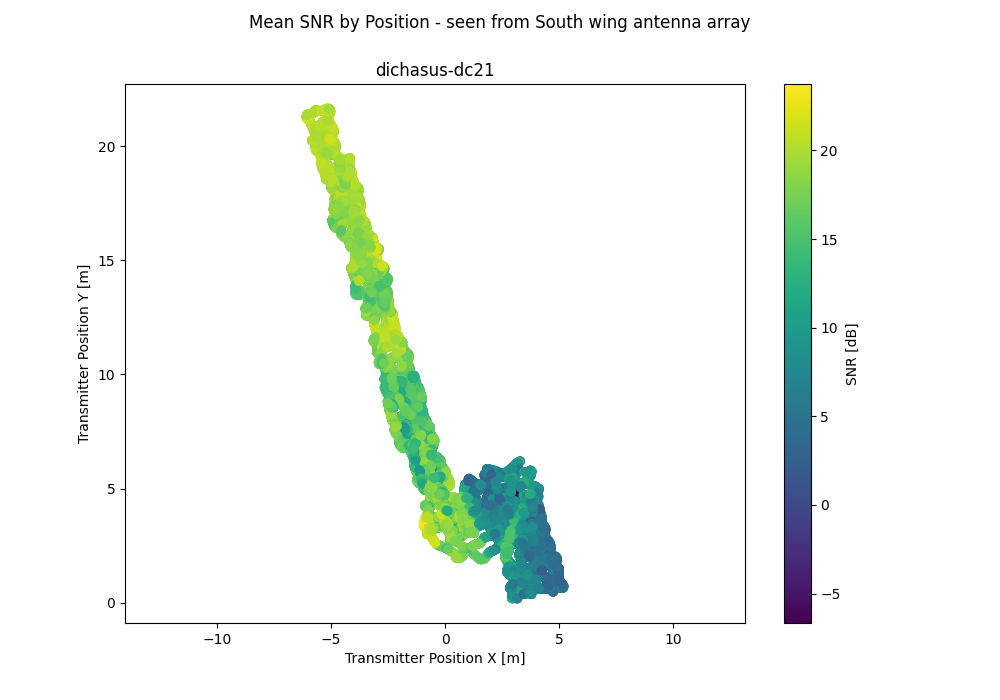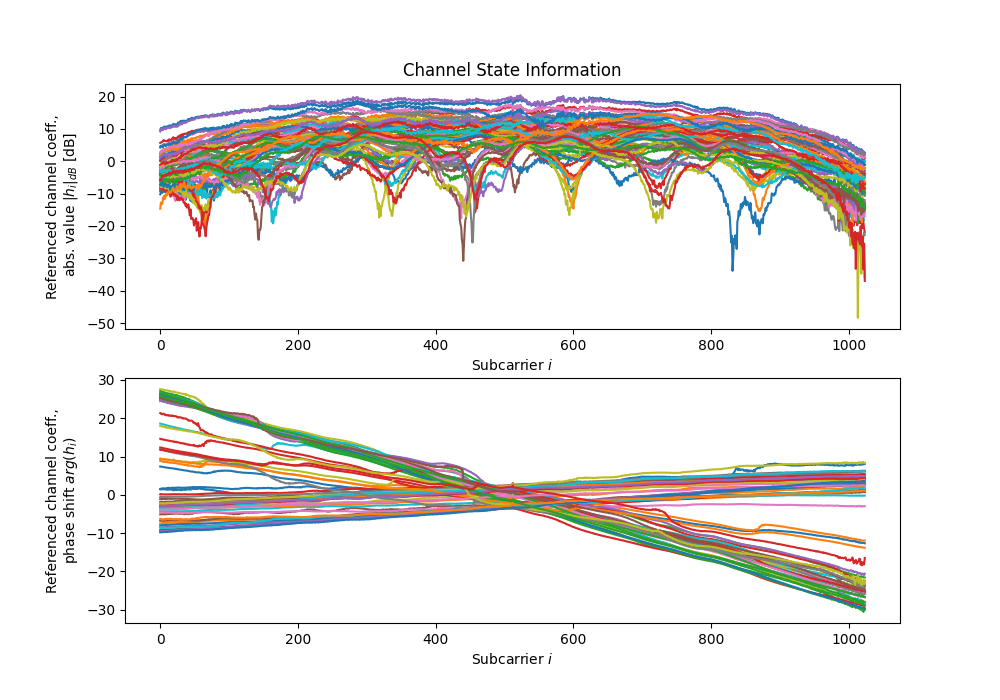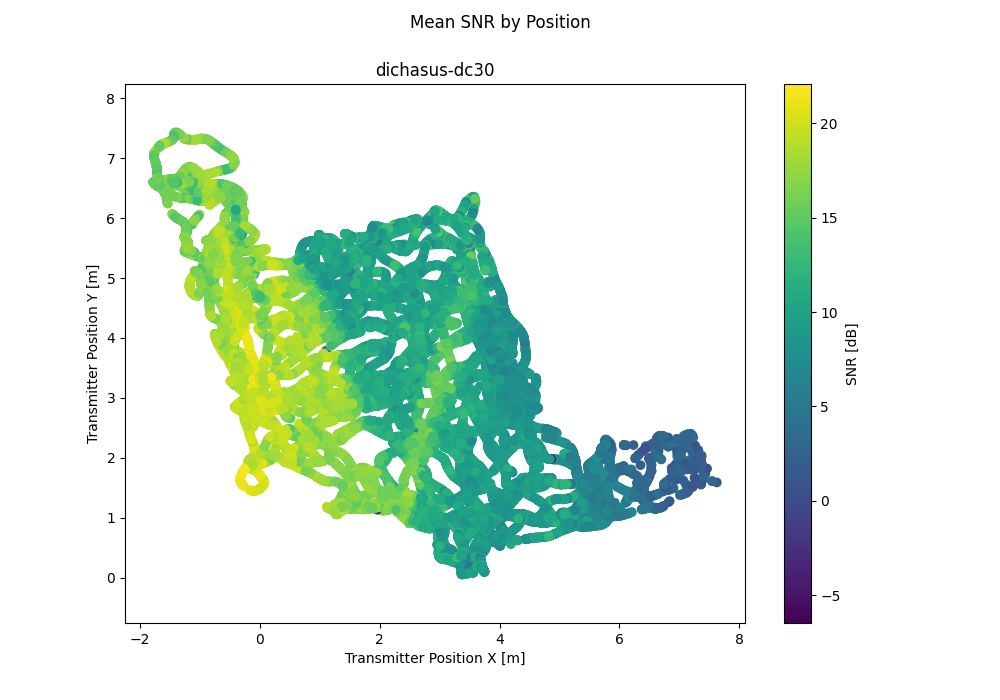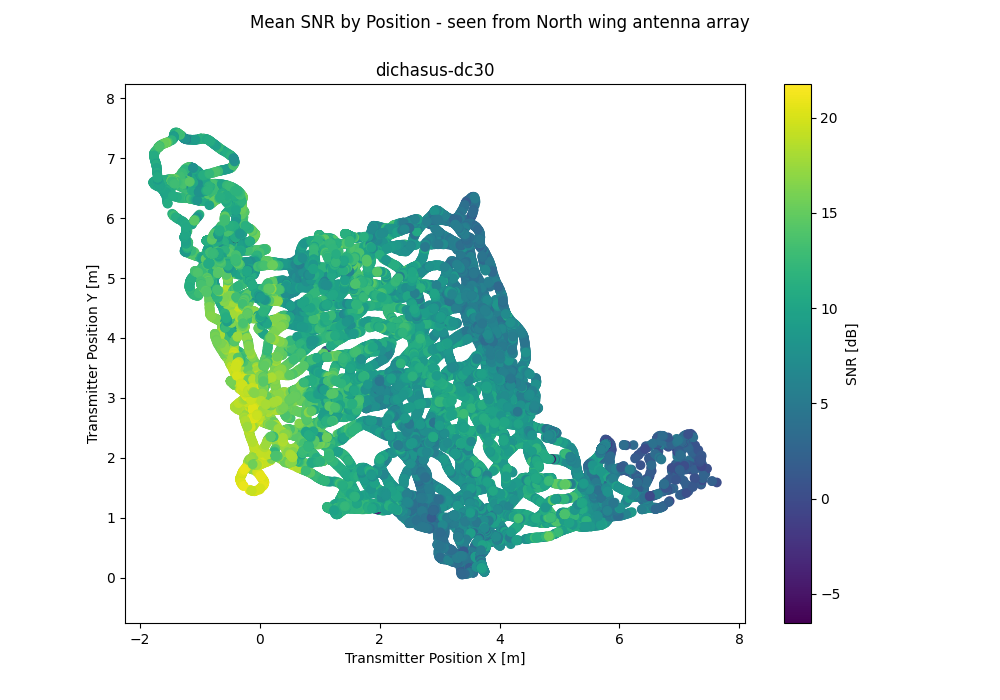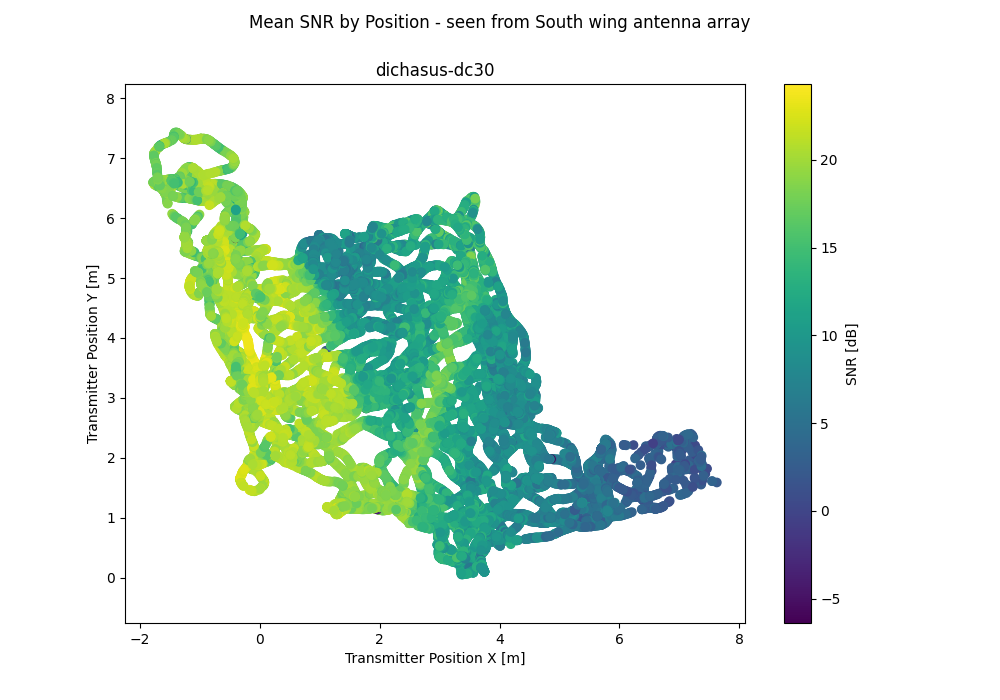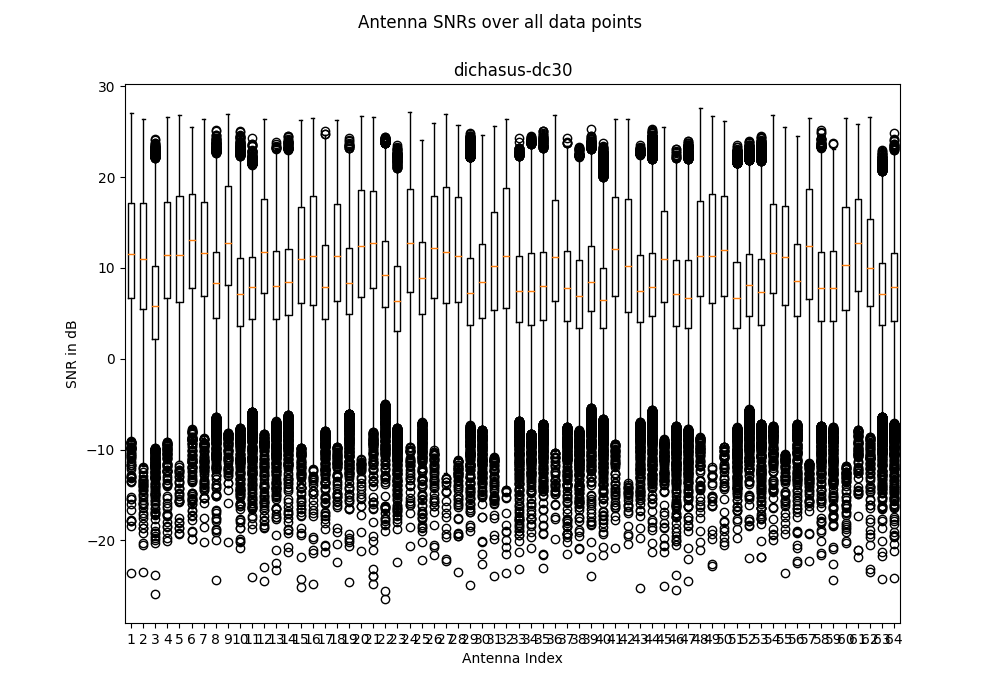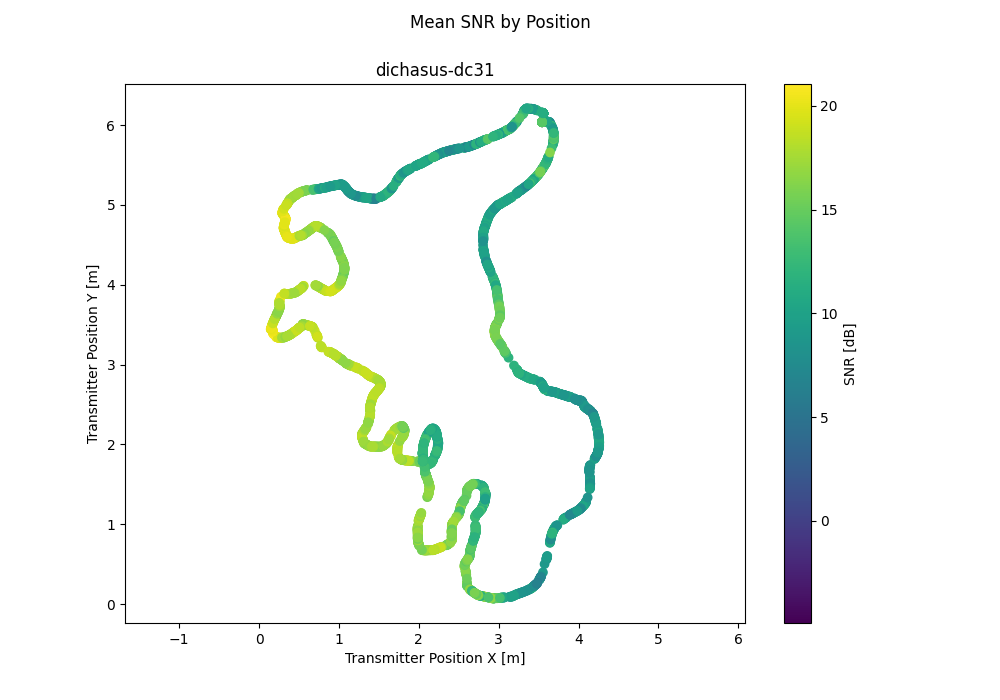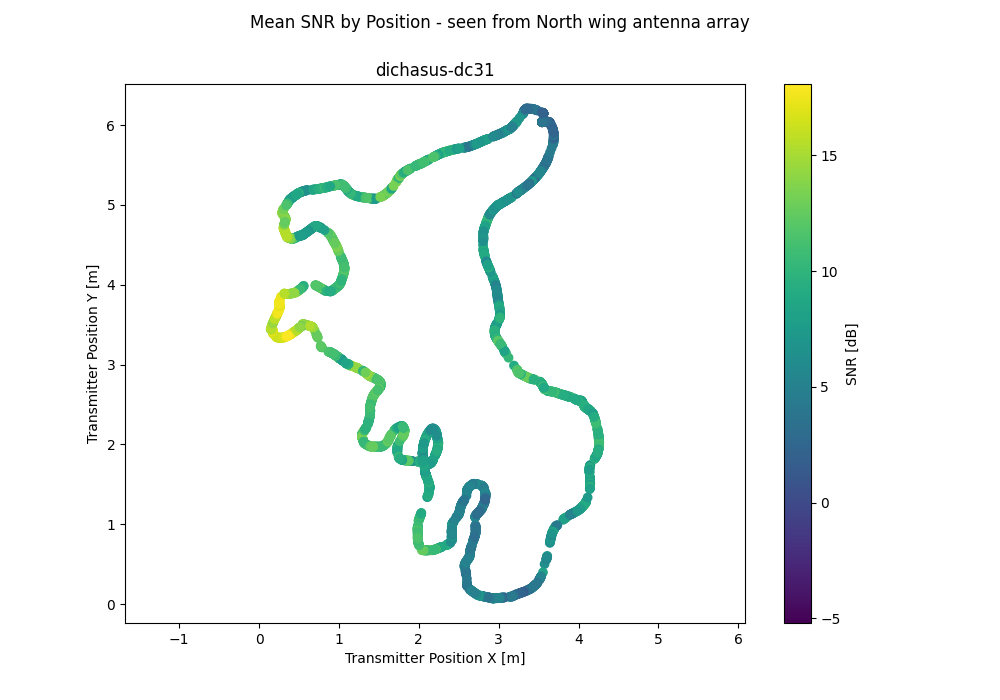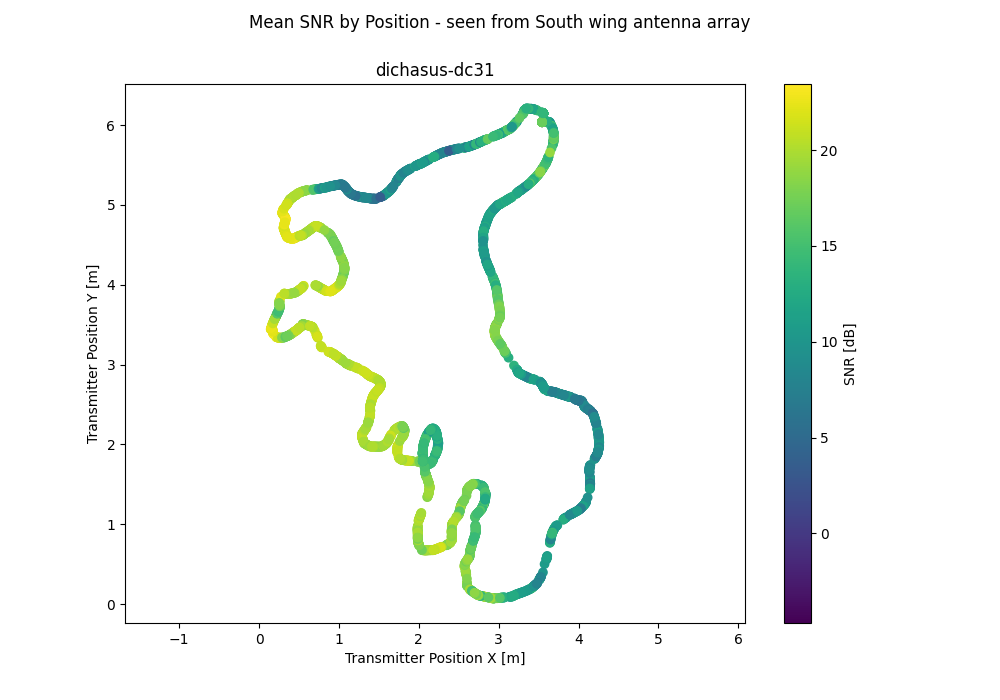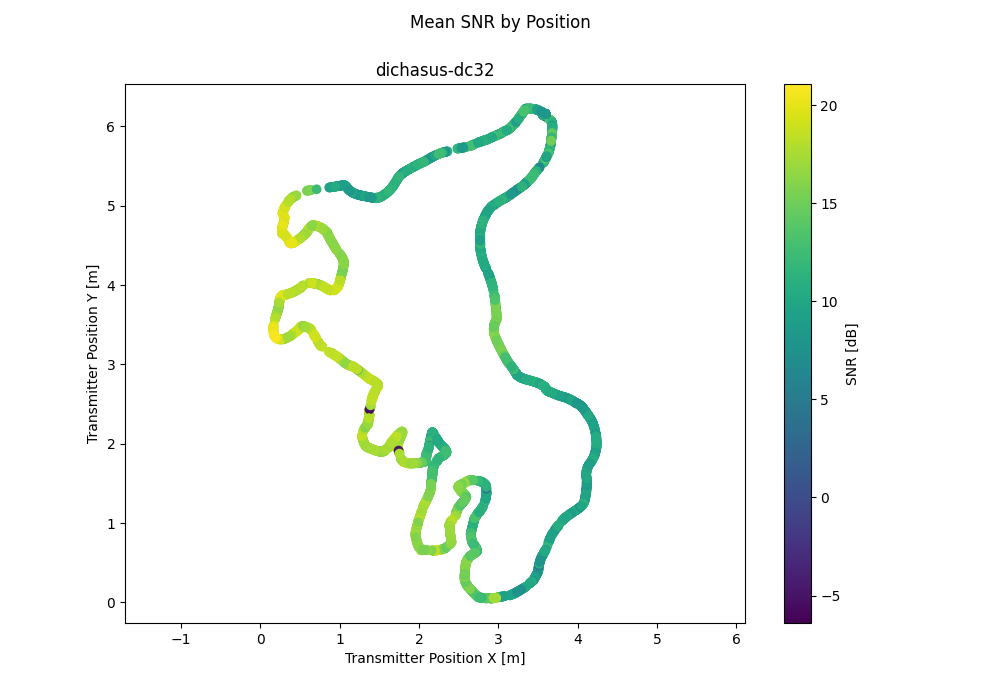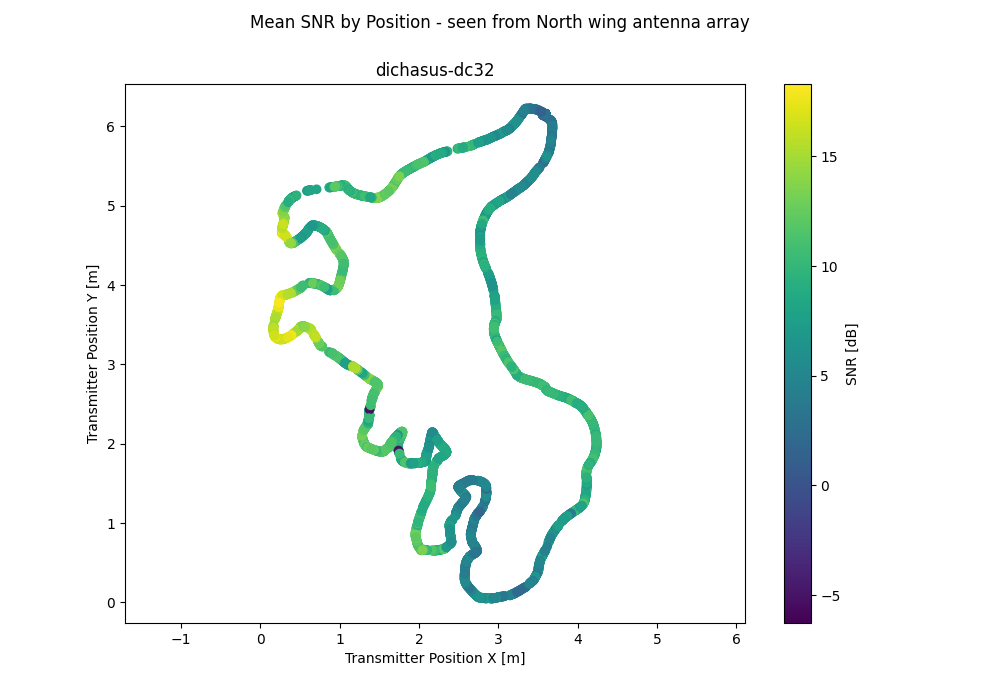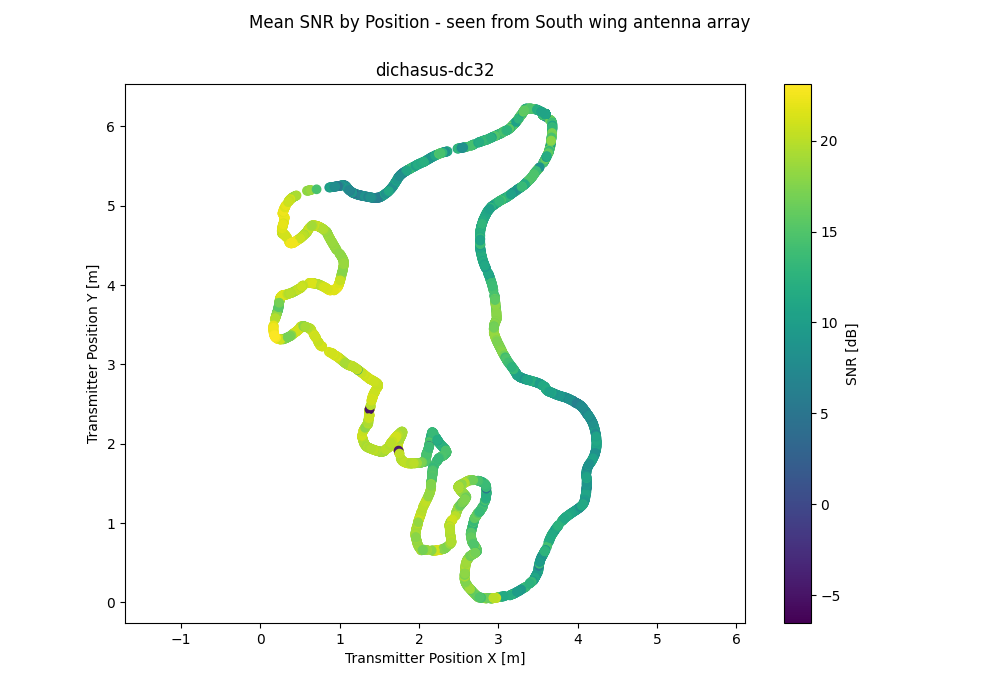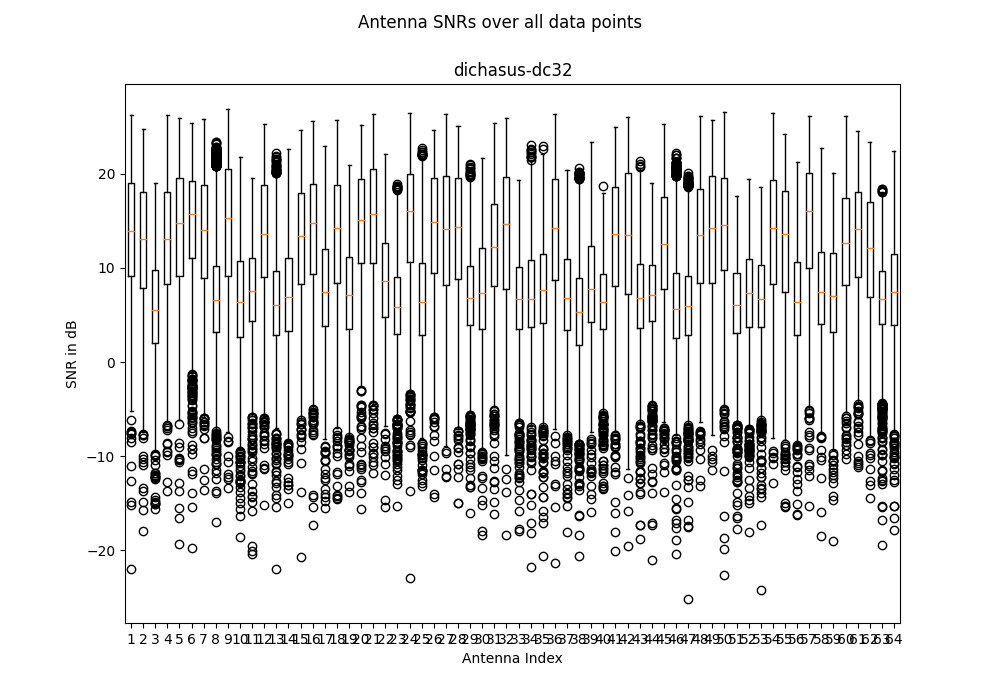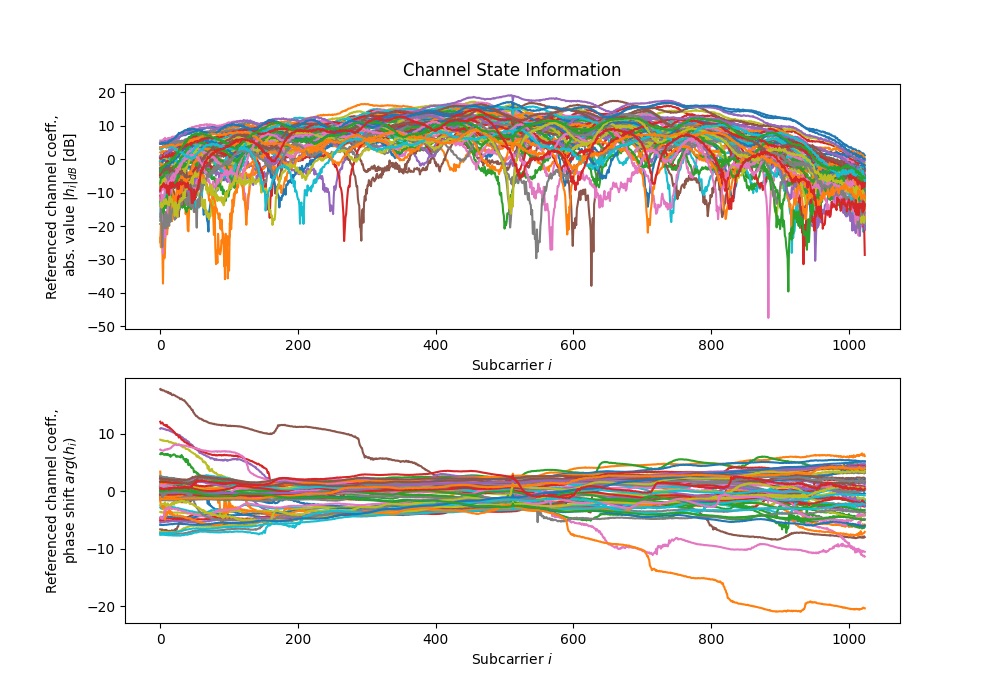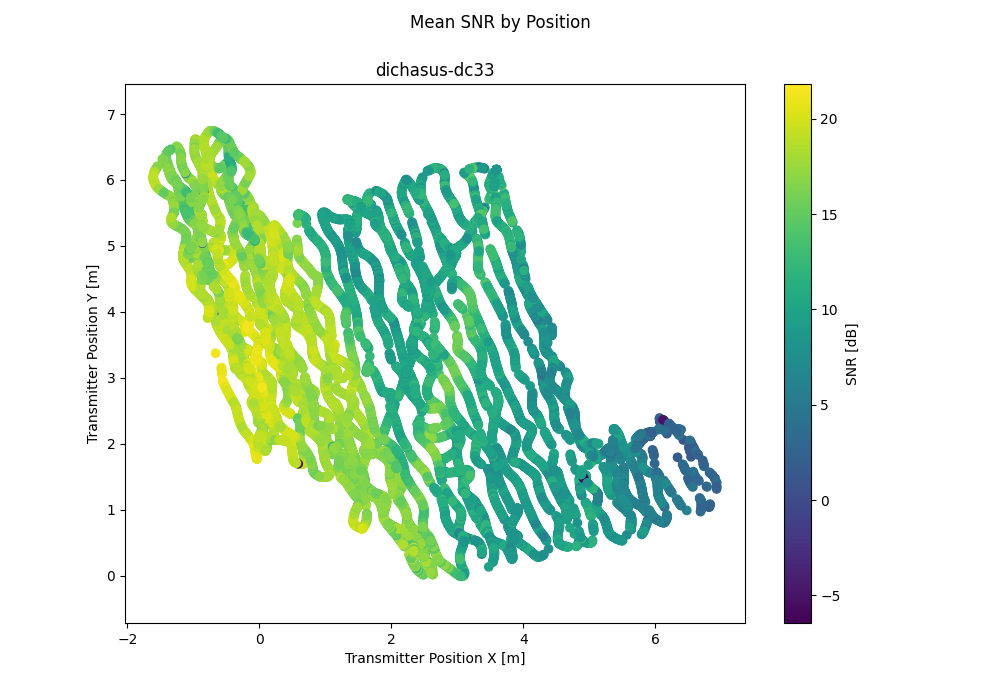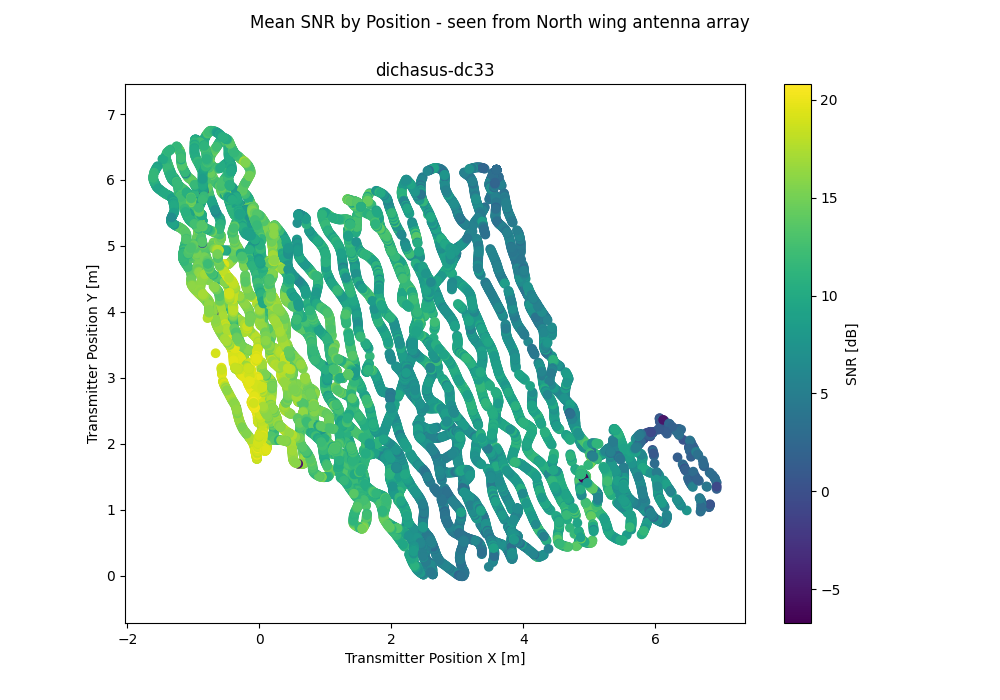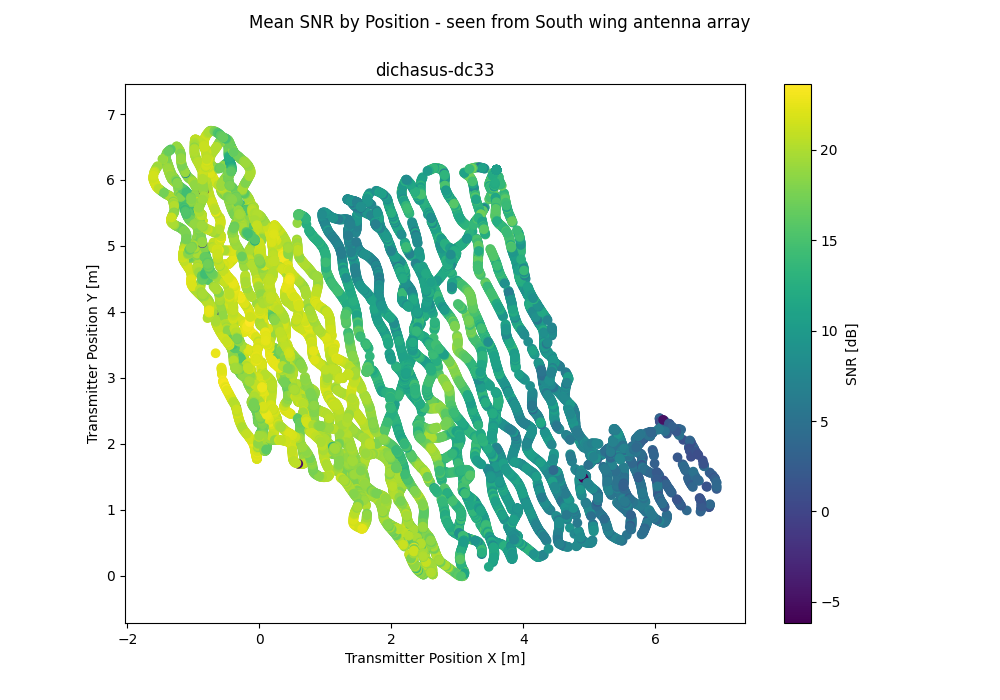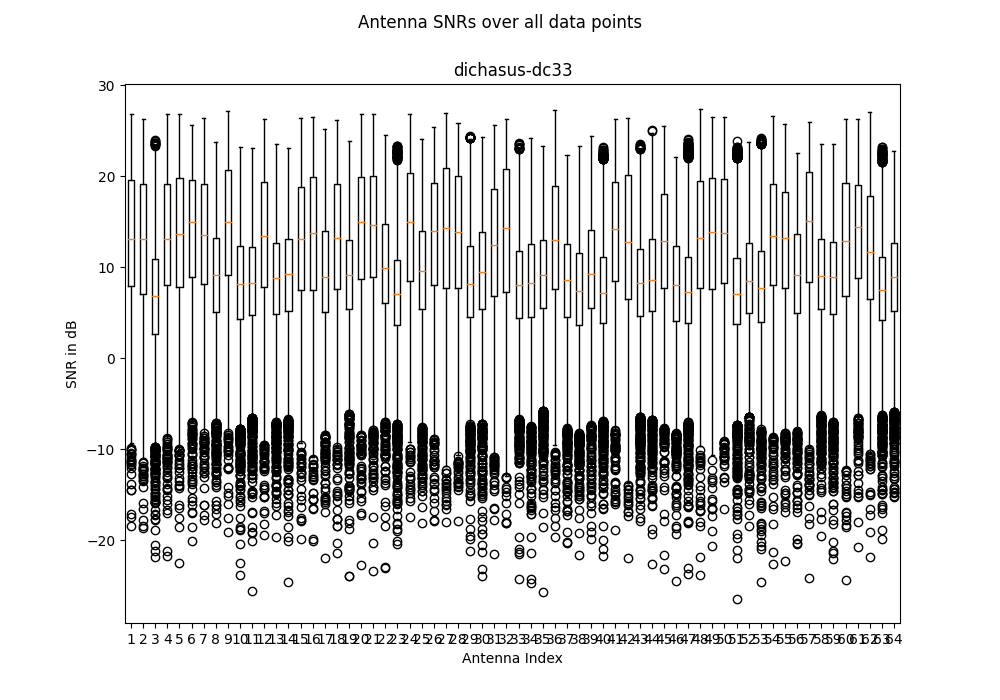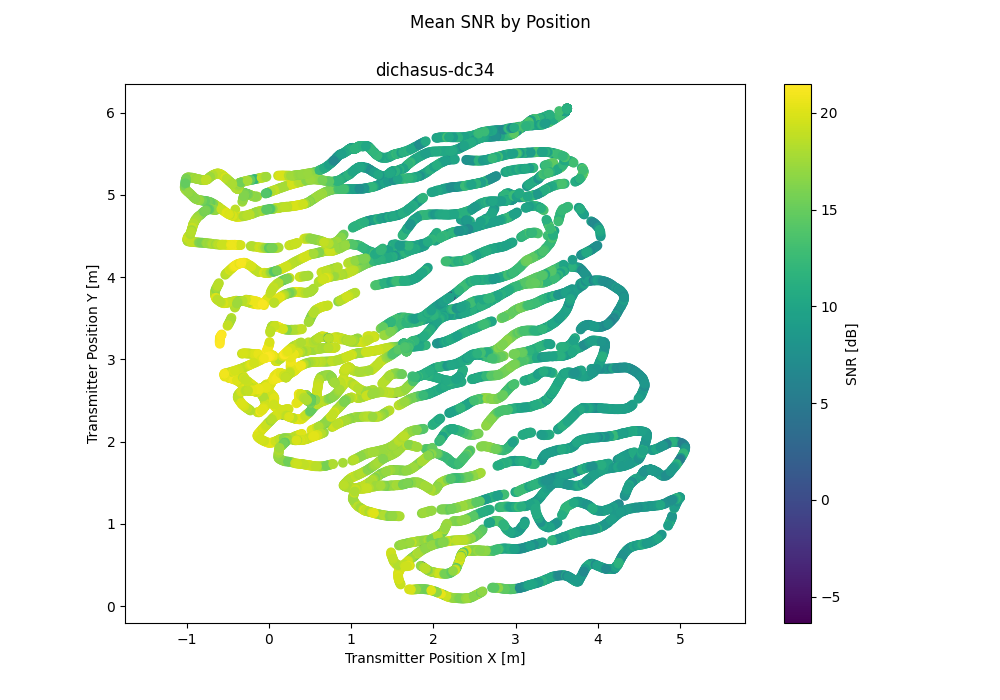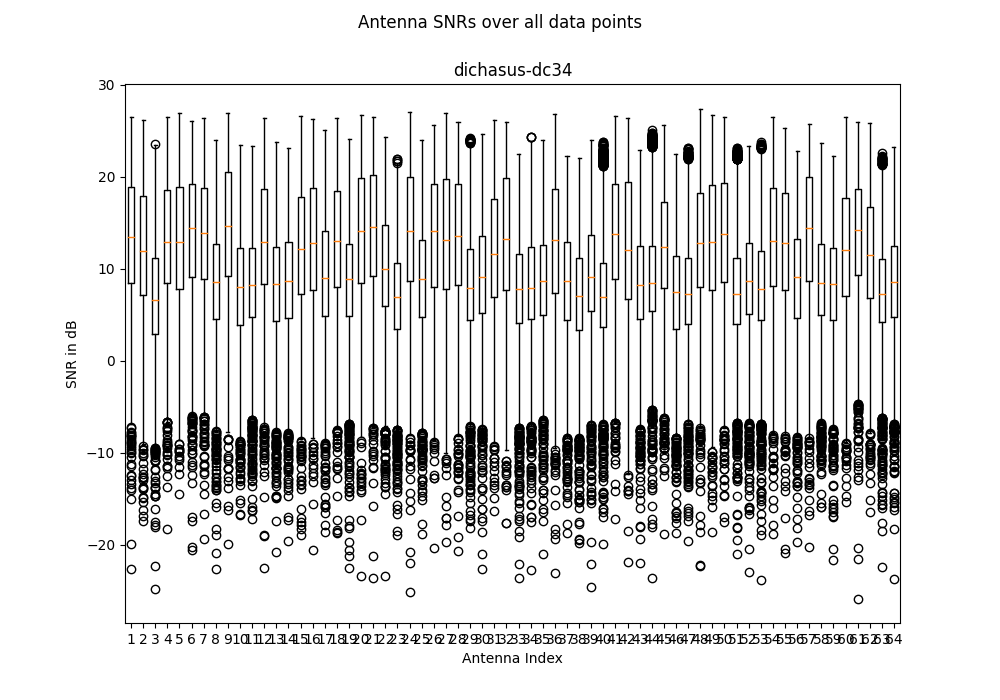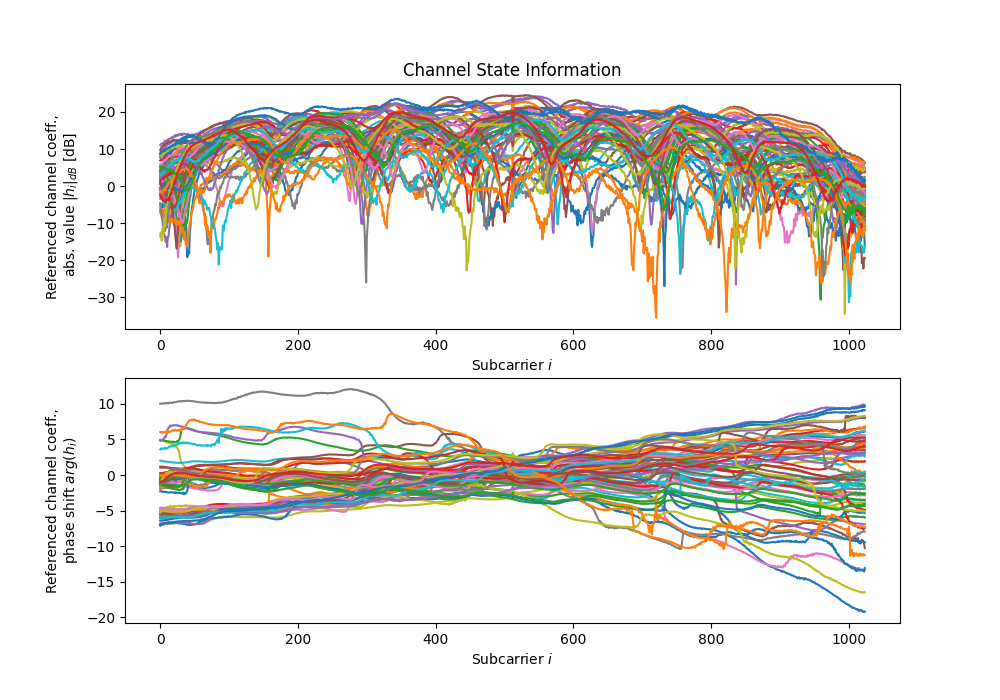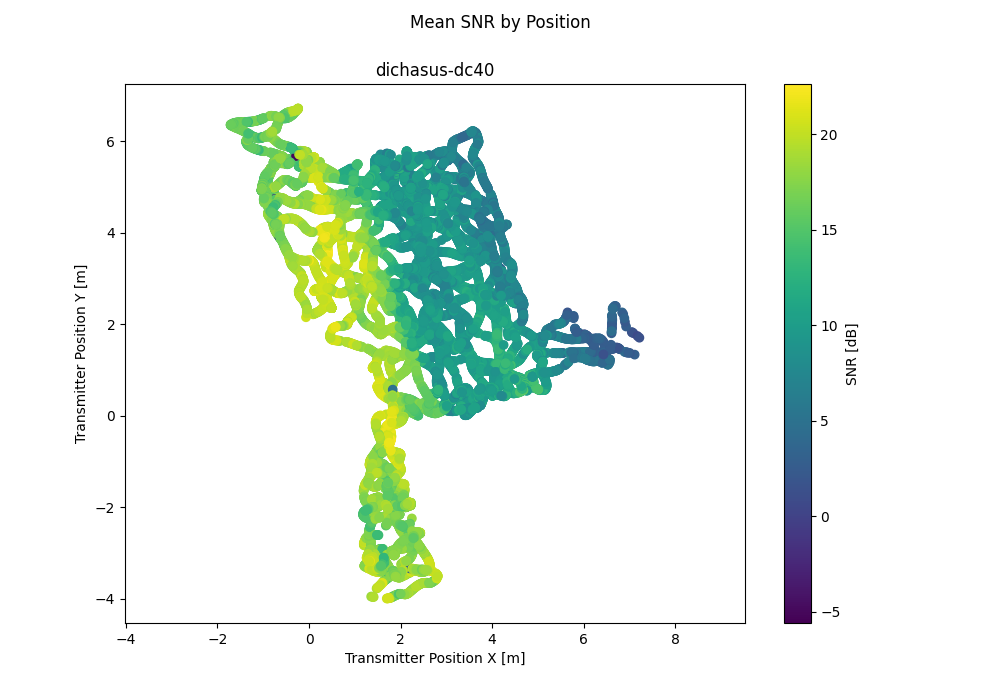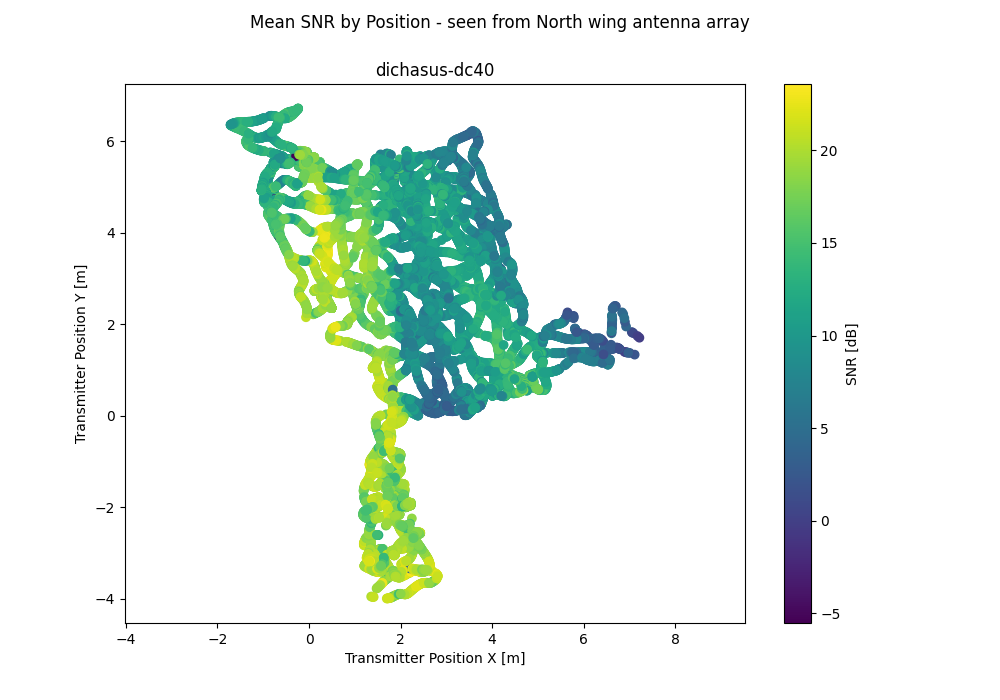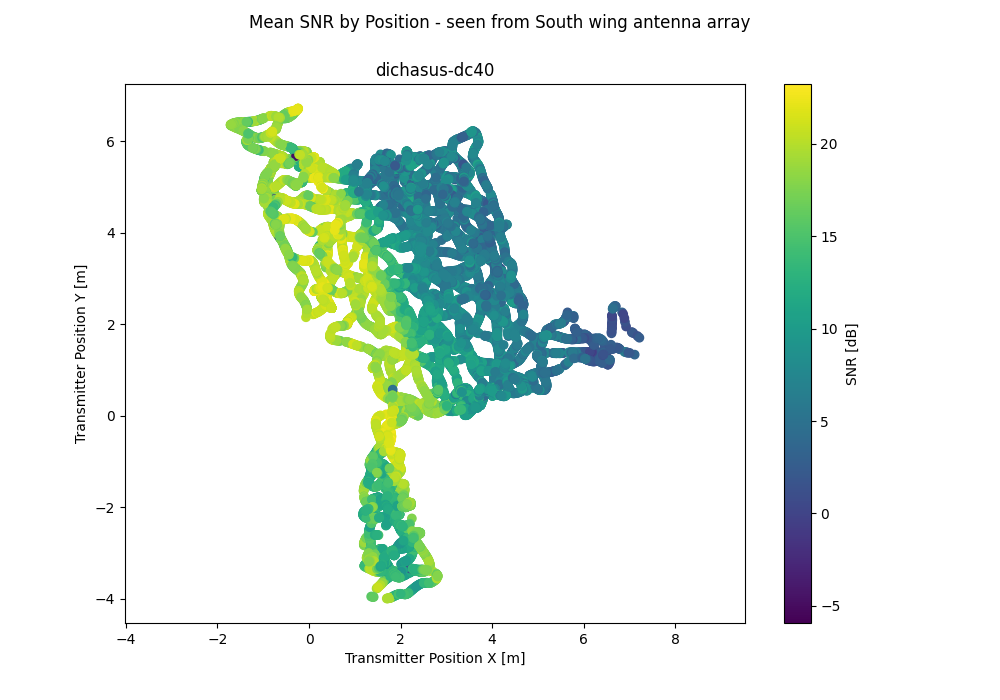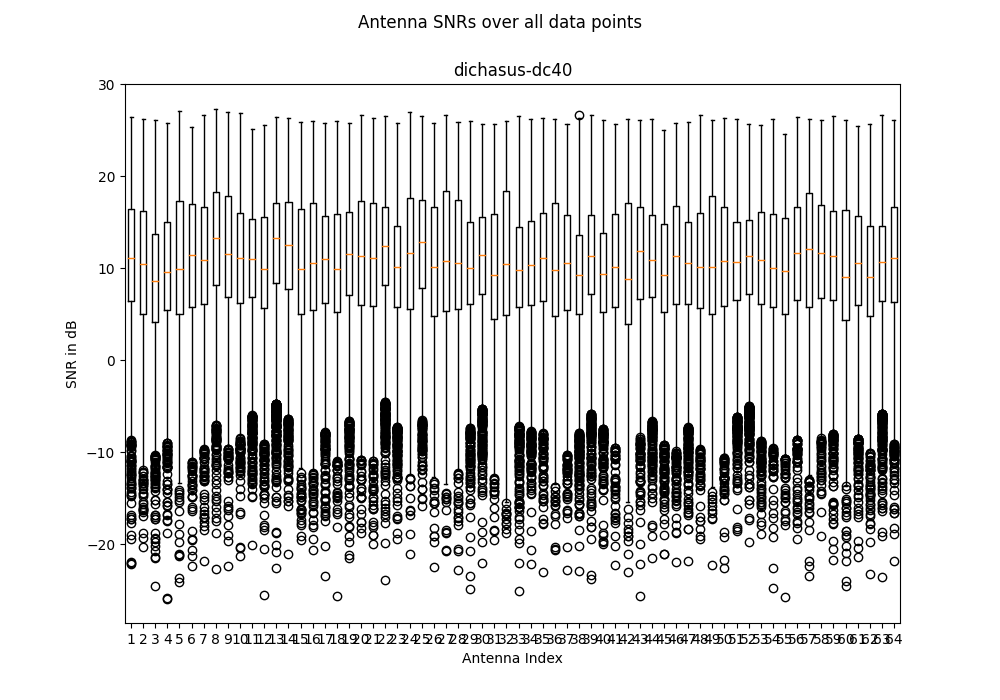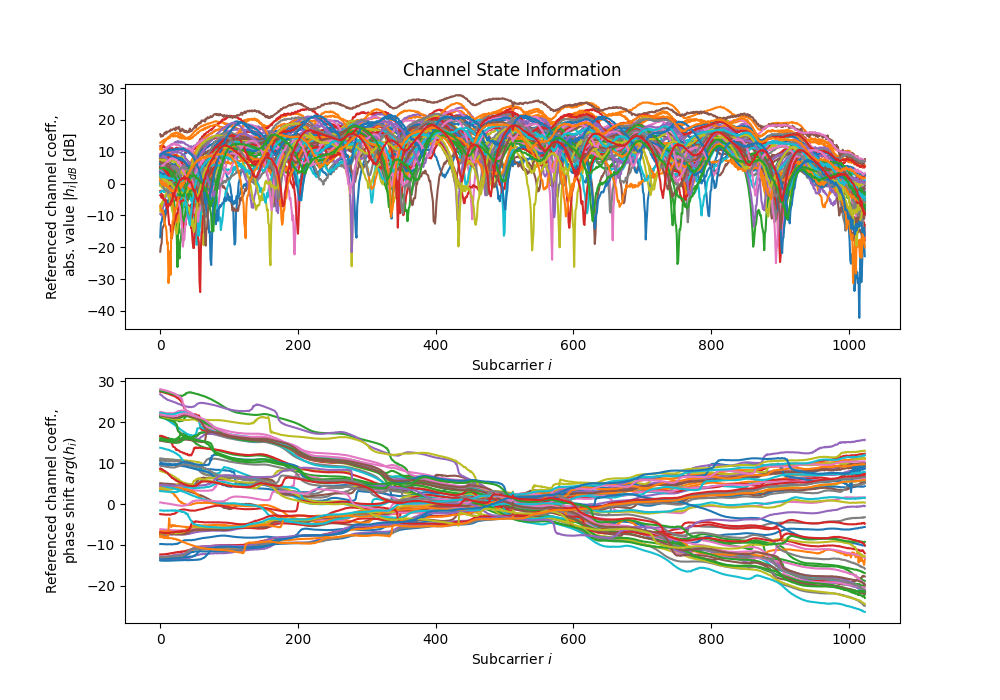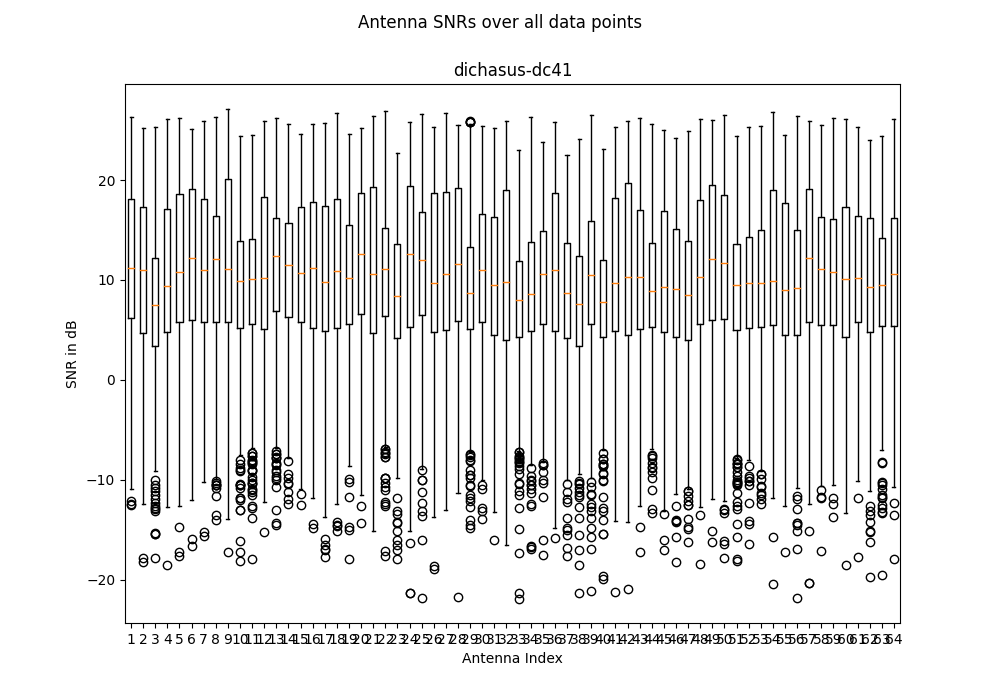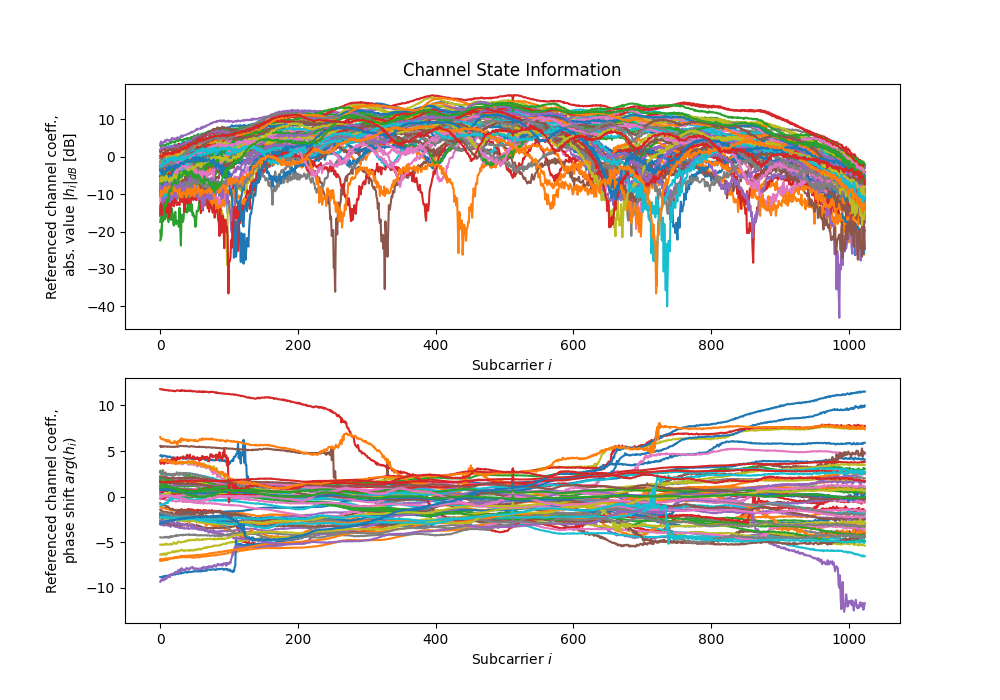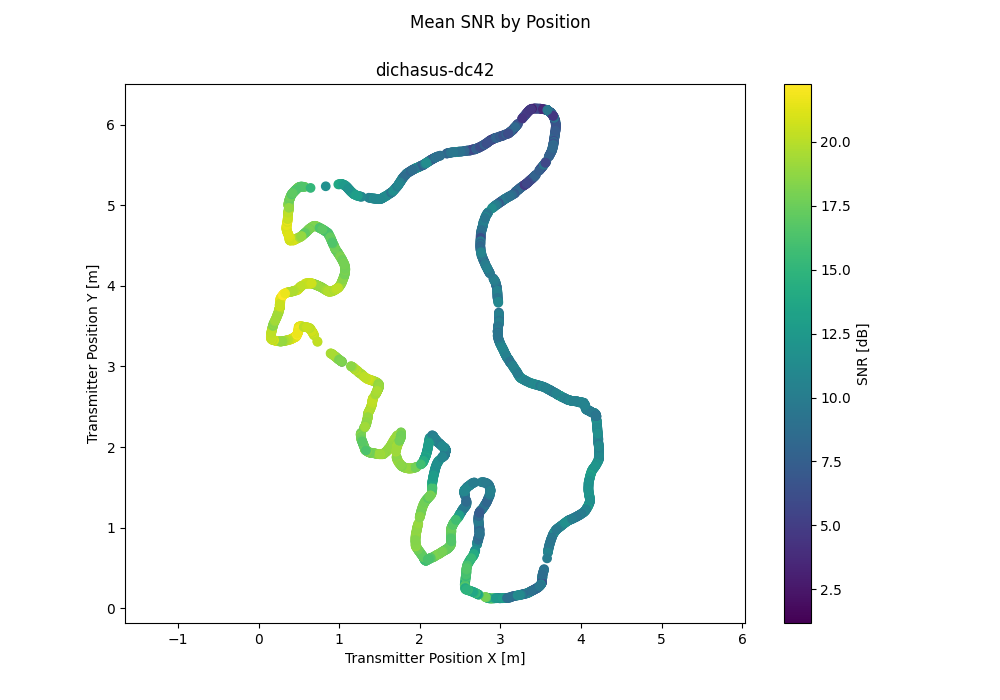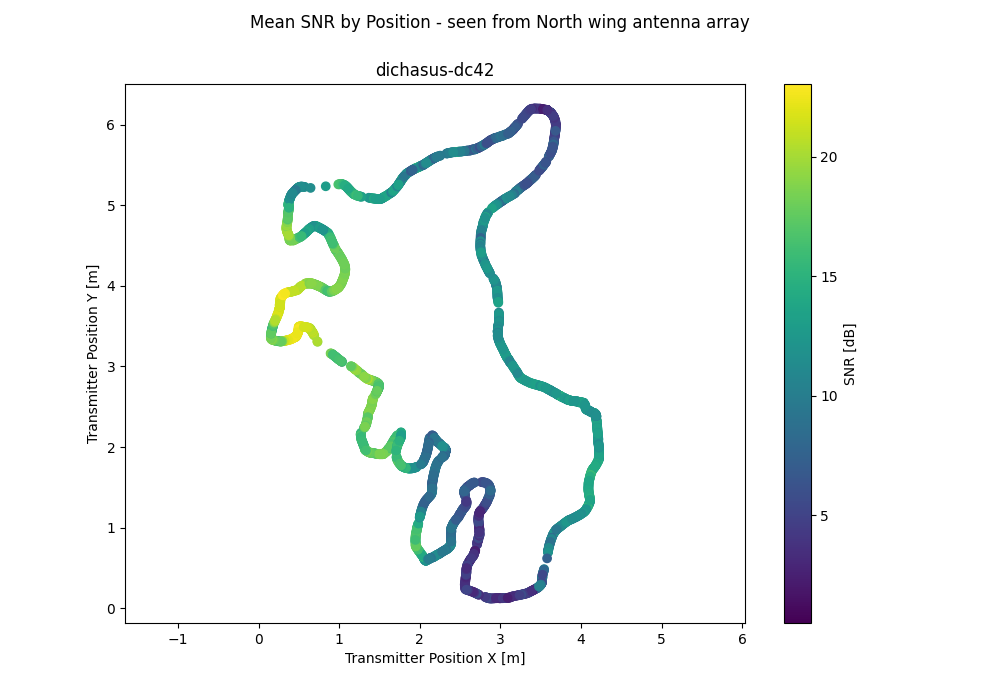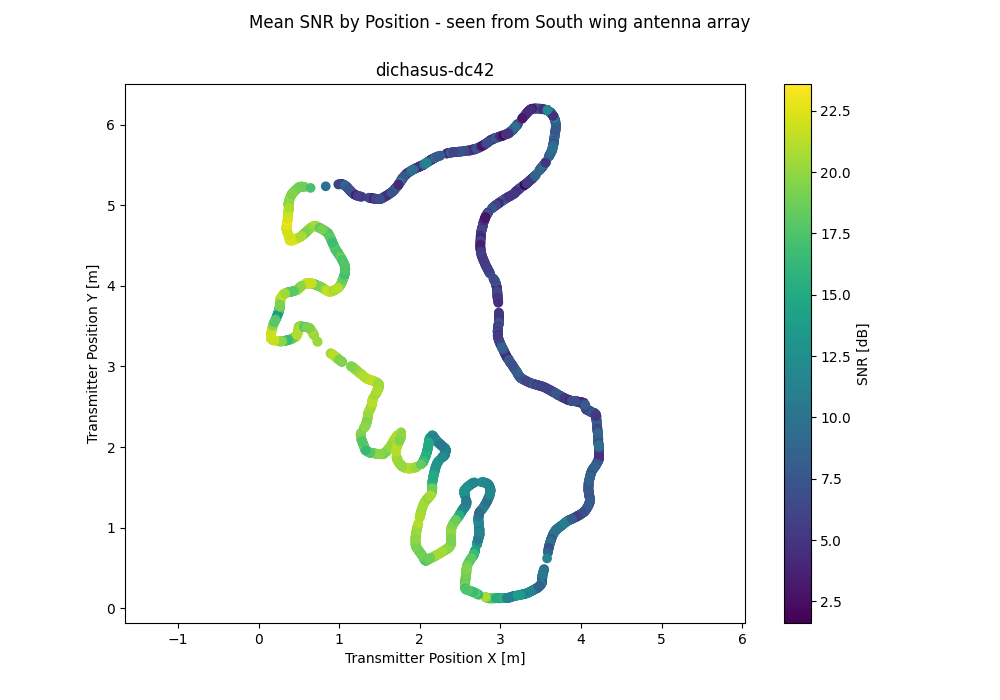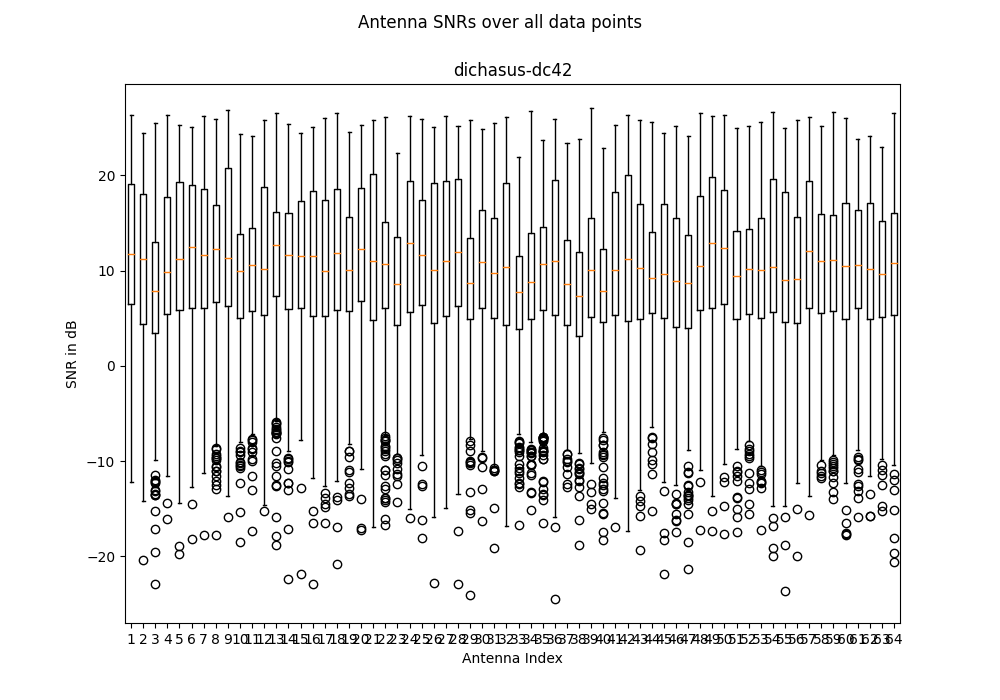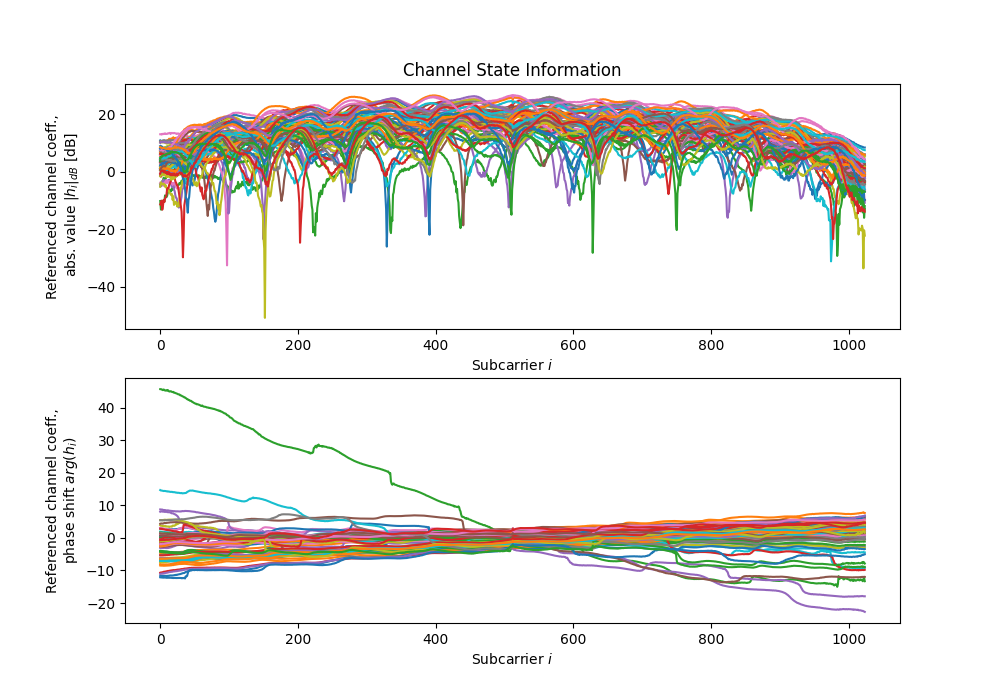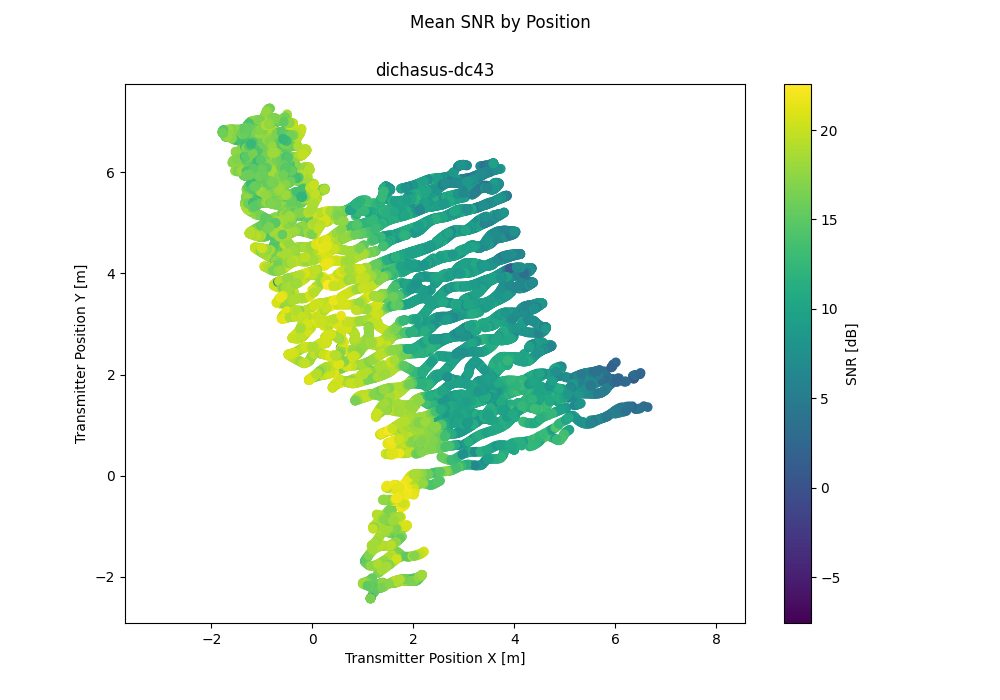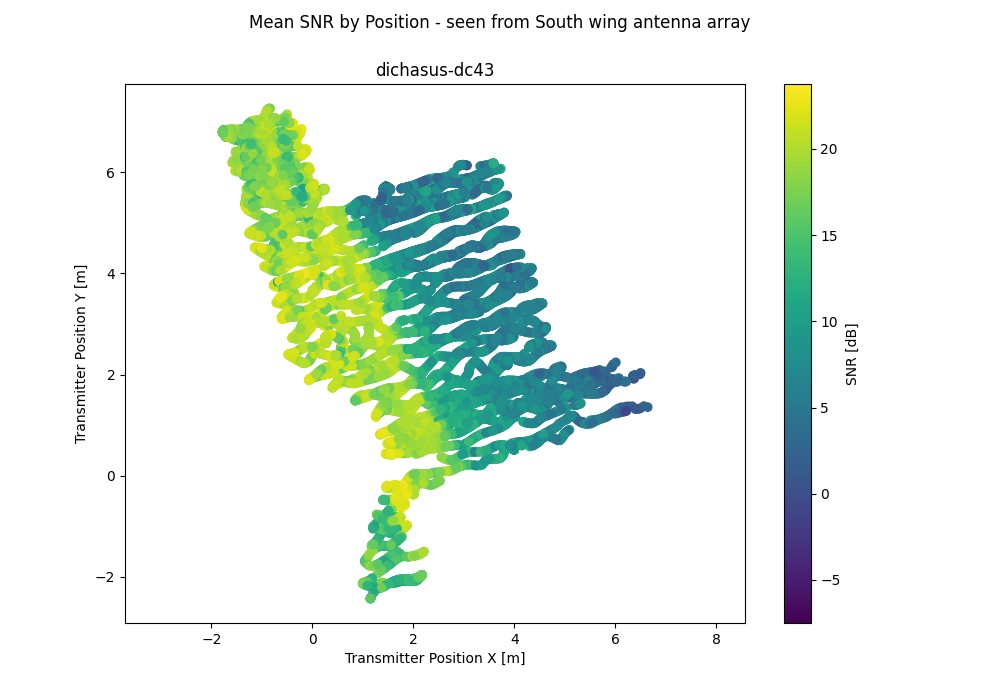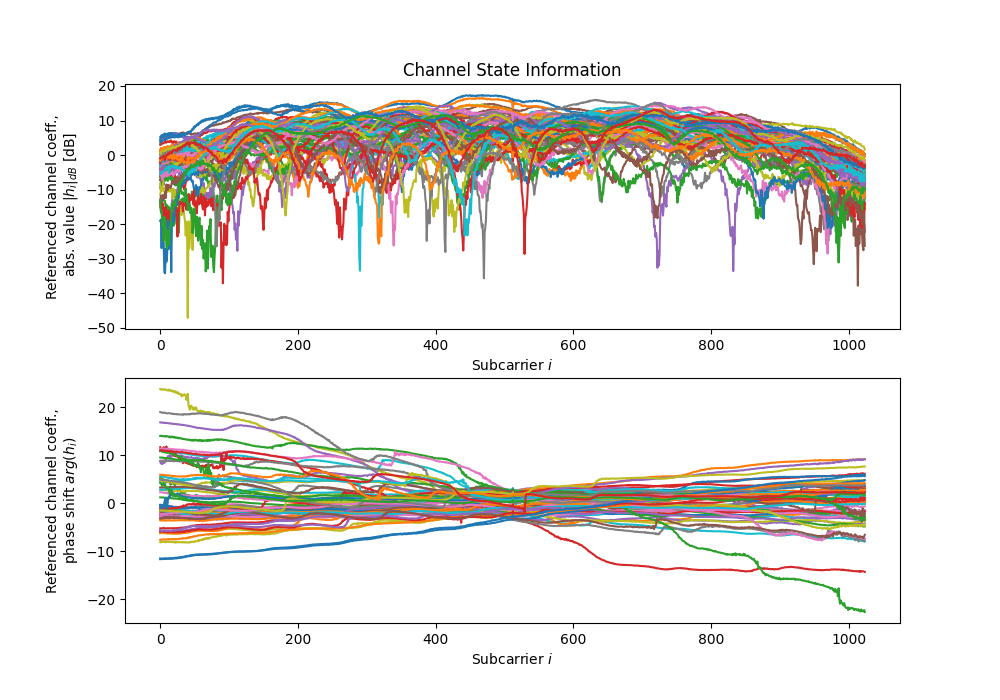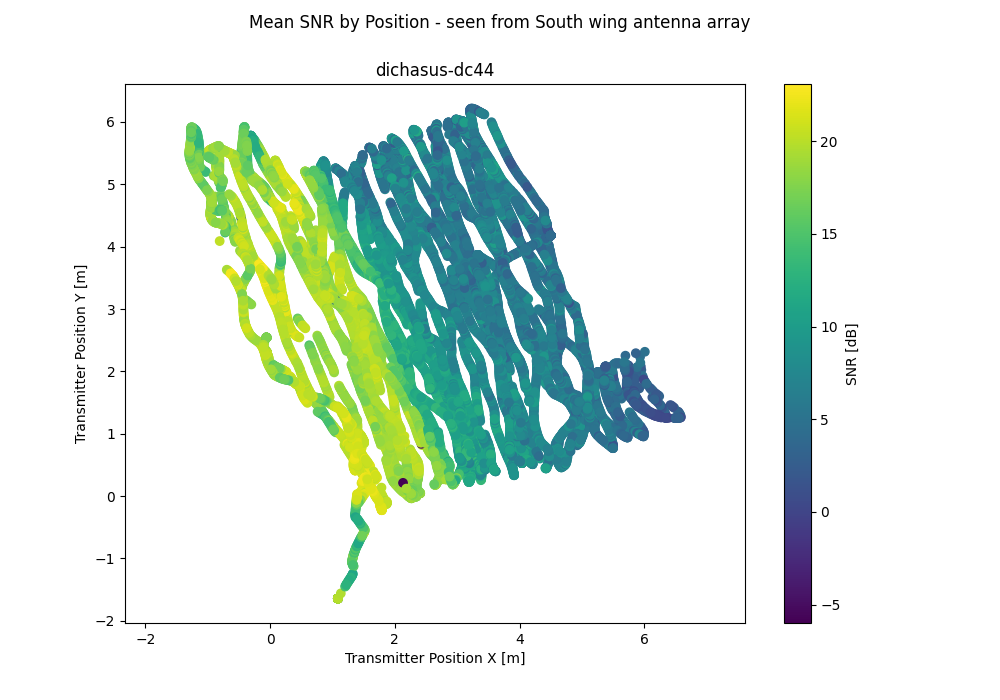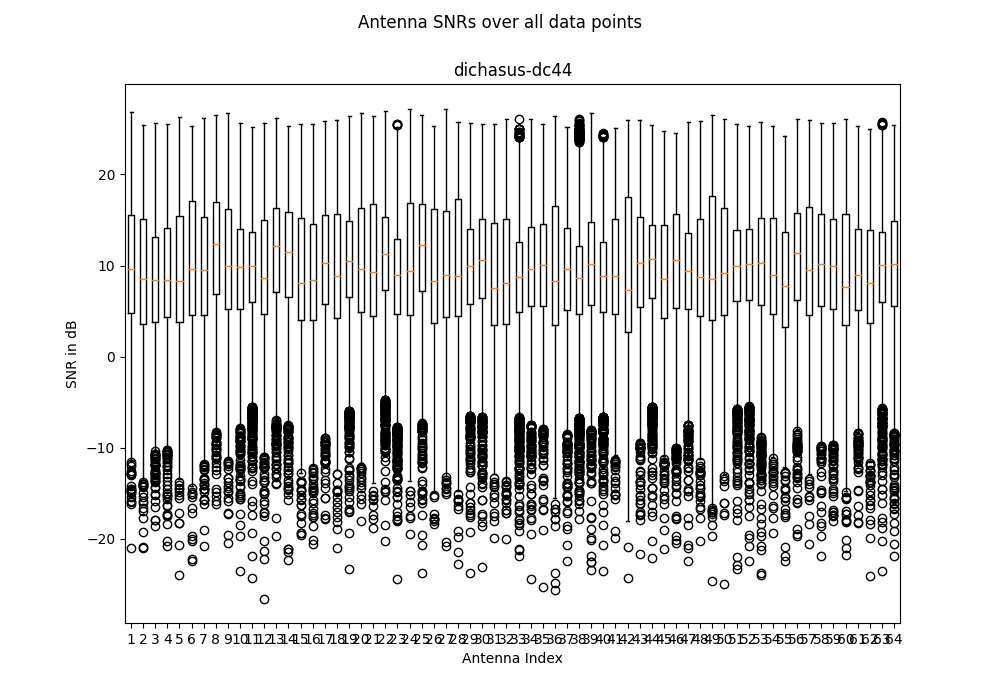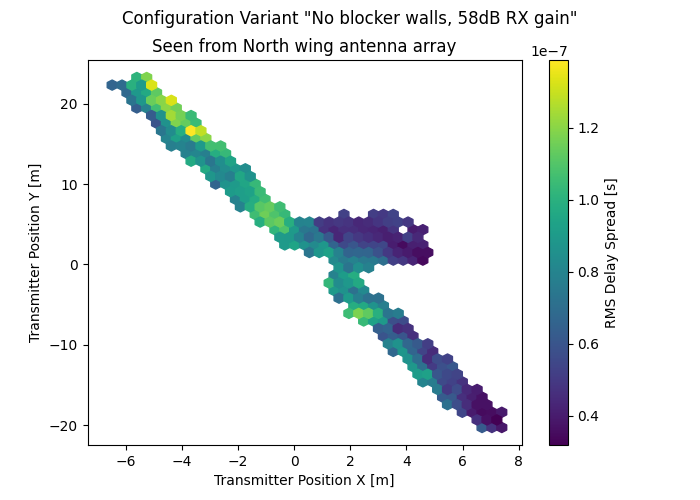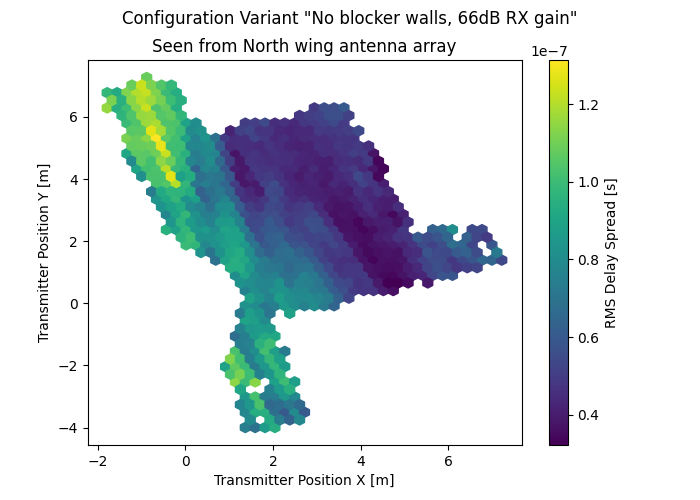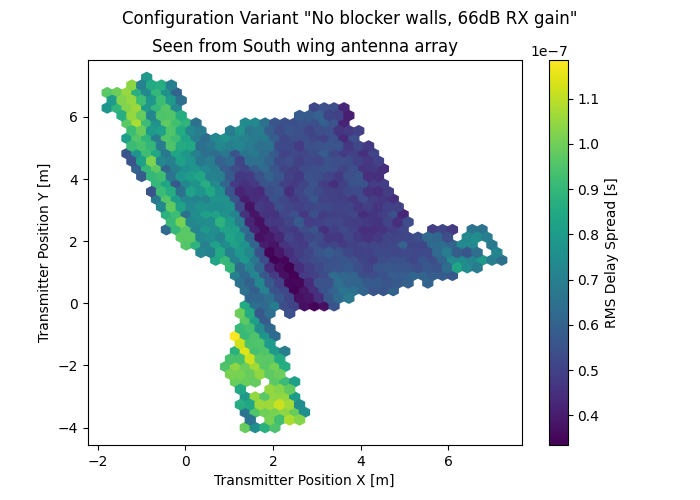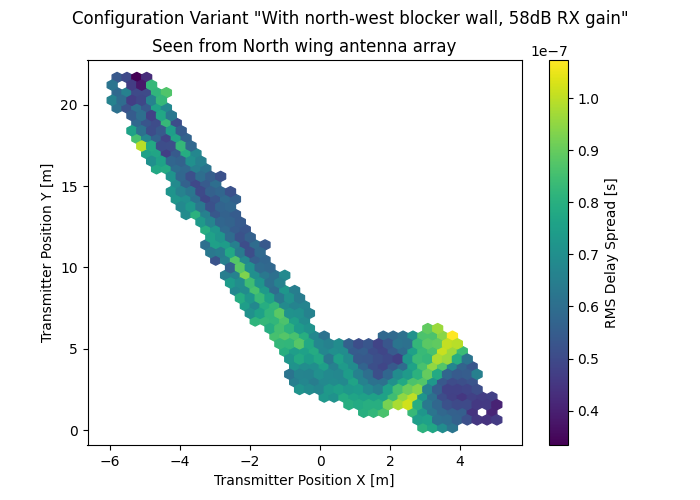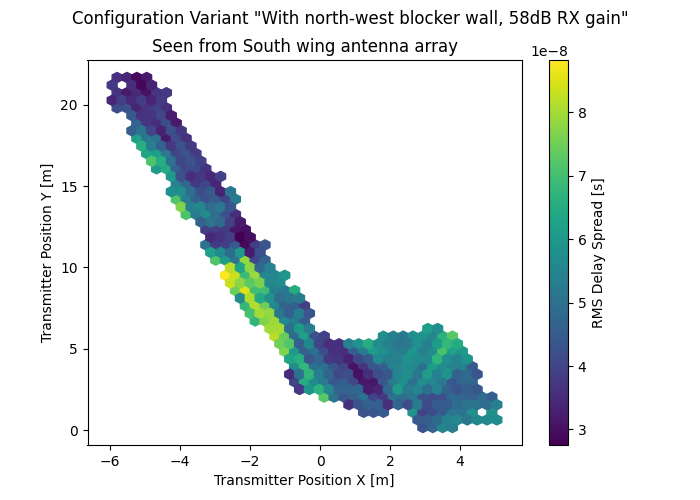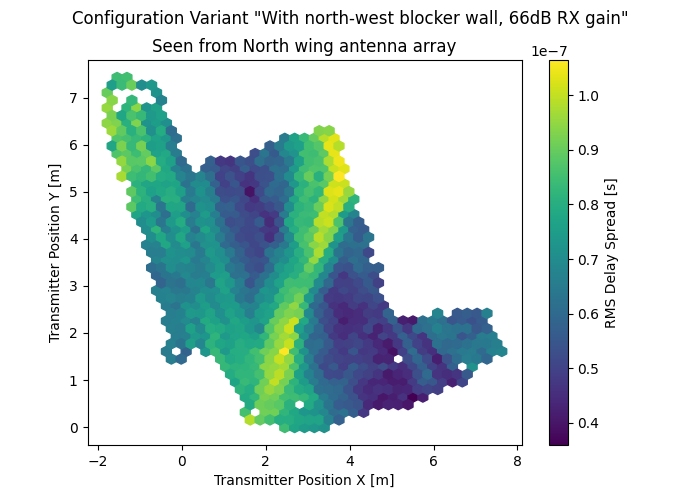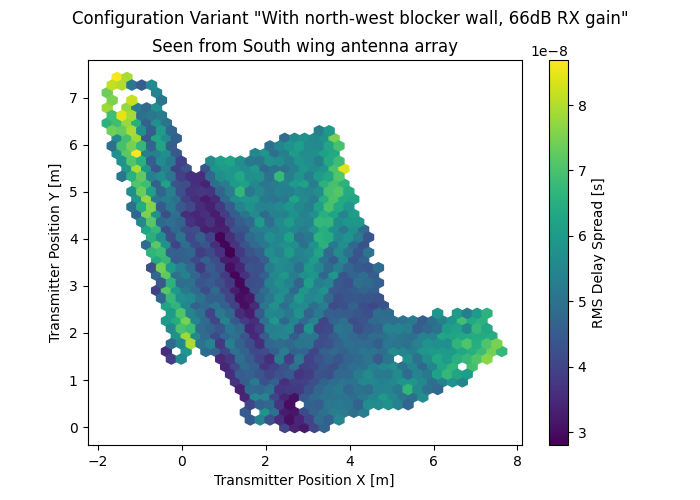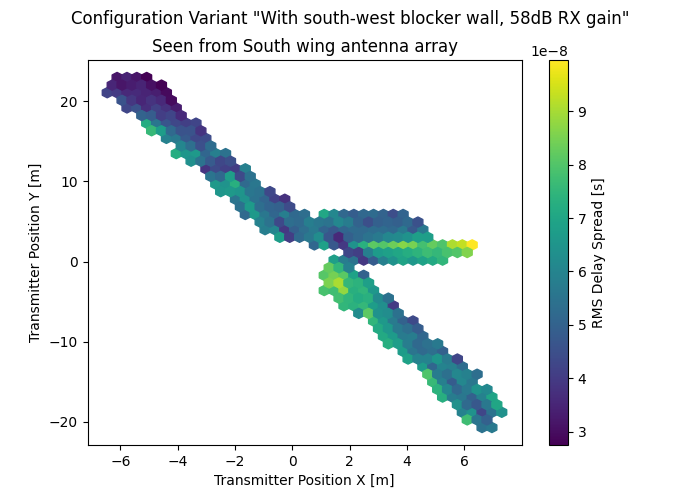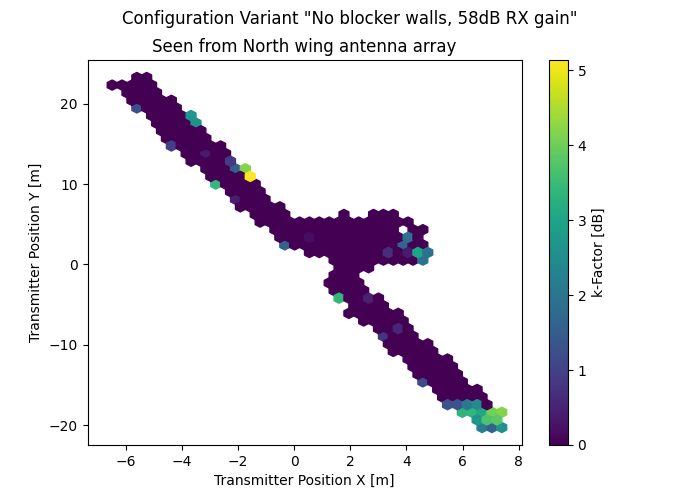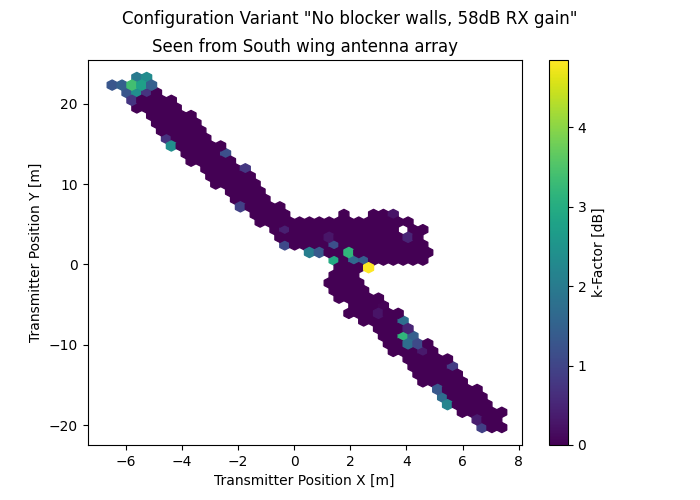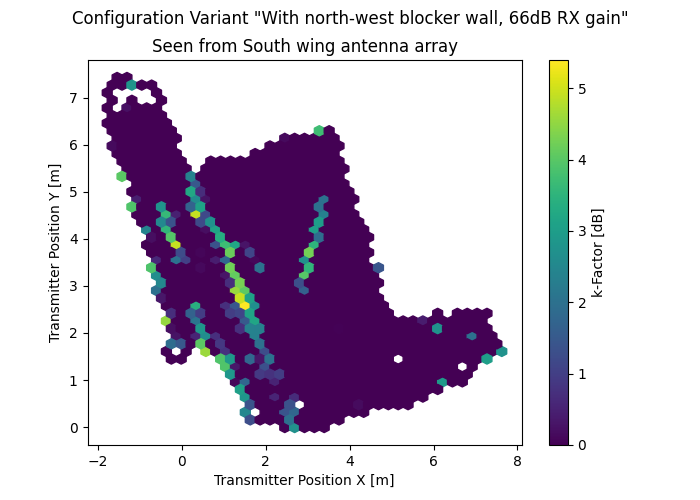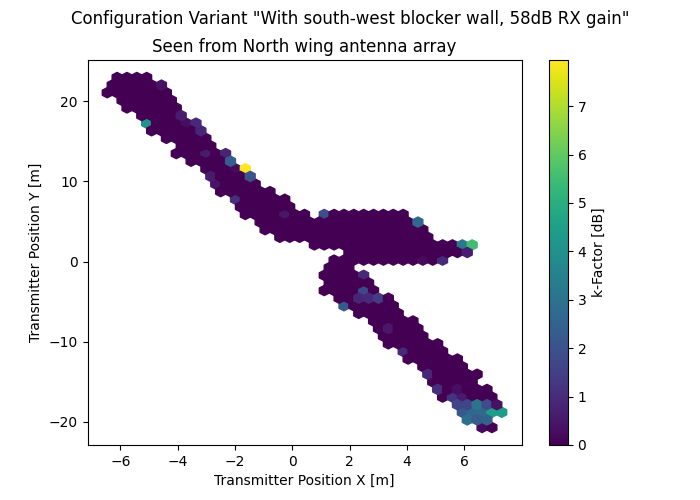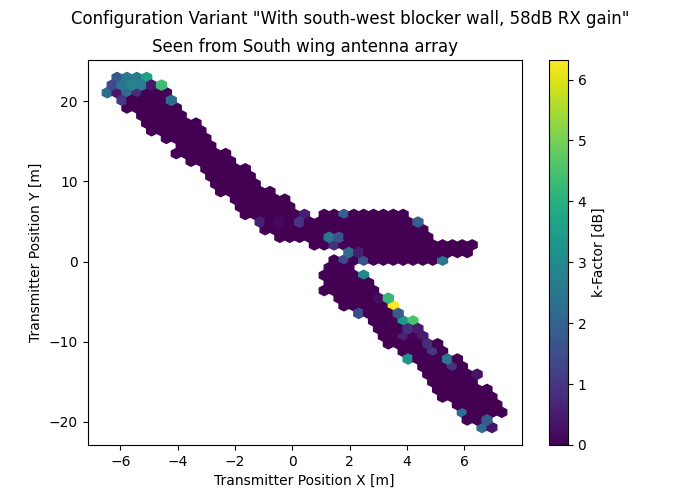dichasus-dcxx Dataset: Institute hallway with known 3D model, distributed antennas
Two separate antenna arrays with 64 antennas in total observe a transmitter in a hallway with known 3D model, ideal for raytracing experiments.
50.000 MHz
Signal Bandwidth
1024
OFDM Subcarriers
426864
Data Points
23917.2 s
Total Duration
224.1 GB
Total Download Size
64
Number of Antennas
Indoor
Type of Environment
3.438000 GHz
Carrier Frequency
Distributed
Antenna Setup
3D Tachymeter
Position-Tagged
Experiment Setup
Data Analysis
Warnings
Antenna Configuration
Antenna 1: North wing antenna array
| 58 | 12 | 24 | 29 | 16 | 2 | 33 | 38 |
| 57 | 7 | 45 | 18 | 42 | 52 | 28 | 21 |
| 63 | 13 | 55 | 37 | 46 | 50 | 43 | 51 |
| 34 | 9 | 36 | 32 | 22 | 62 | 39 | 10 |
Antenna 2: South wing antenna array
| 60 | 54 | 6 | 17 | 49 | 20 | 5 | 19 |
| 40 | 8 | 0 | 27 | 41 | 25 | 23 | 56 |
| 44 | 53 | 61 | 59 | 48 | 35 | 1 | 26 |
| 3 | 11 | 47 | 30 | 14 | 4 | 15 | 31 |
Python: Import with TensorFlow
#!/usr/bin/env python3
import tensorflow as tf
raw_dataset = tf.data.TFRecordDataset(["tfrecords/dichasus-dc01.tfrecords", "tfrecords/dichasus-dc02.tfrecords", "tfrecords/dichasus-dc04.tfrecords", "tfrecords/dichasus-dc10.tfrecords", "tfrecords/dichasus-dc11.tfrecords", "tfrecords/dichasus-dc12.tfrecords", "tfrecords/dichasus-dc13.tfrecords", "tfrecords/dichasus-dc14.tfrecords", "tfrecords/dichasus-dc15.tfrecords", "tfrecords/dichasus-dc20.tfrecords", "tfrecords/dichasus-dc21.tfrecords", "tfrecords/dichasus-dc30.tfrecords", "tfrecords/dichasus-dc31.tfrecords", "tfrecords/dichasus-dc32.tfrecords", "tfrecords/dichasus-dc33.tfrecords", "tfrecords/dichasus-dc34.tfrecords", "tfrecords/dichasus-dc40.tfrecords", "tfrecords/dichasus-dc41.tfrecords", "tfrecords/dichasus-dc42.tfrecords", "tfrecords/dichasus-dc43.tfrecords", "tfrecords/dichasus-dc44.tfrecords"])
feature_description = {
"cfo": tf.io.FixedLenFeature([], tf.string, default_value = ''),
"csi": tf.io.FixedLenFeature([], tf.string, default_value = ''),
"gt-interp-age-tachy": tf.io.FixedLenFeature([], tf.float32, default_value = 0),
"pos-tachy": tf.io.FixedLenFeature([], tf.string, default_value = ''),
"snr": tf.io.FixedLenFeature([], tf.string, default_value = ''),
"time": tf.io.FixedLenFeature([], tf.float32, default_value = 0),
}
def record_parse_function(proto):
record = tf.io.parse_single_example(proto, feature_description)
# Measured carrier frequency offset between MOBTX and each receive antenna.
cfo = tf.ensure_shape(tf.io.parse_tensor(record["cfo"], out_type = tf.float32), (64))
# Channel coefficients for all antennas, over all subcarriers, real and imaginary parts
csi = tf.ensure_shape(tf.io.parse_tensor(record["csi"], out_type = tf.float32), (64, 1024, 2))
# Time in seconds to closest known tachymeter position. Indicates quality of linear interpolation.
gt_interp_age_tachy = tf.ensure_shape(record["gt-interp-age-tachy"], ())
# Position of transmitter determined by a tachymeter pointed at a prism mounted on top of the antenna, in meters (X / Y / Z coordinates)
pos_tachy = tf.ensure_shape(tf.io.parse_tensor(record["pos-tachy"], out_type = tf.float64), (3))
# Signal-to-Noise ratio estimates for all antennas
snr = tf.ensure_shape(tf.io.parse_tensor(record["snr"], out_type = tf.float32), (64))
# Timestamp since start of measurement campaign, in seconds
time = tf.ensure_shape(record["time"], ())
return cfo, csi, gt_interp_age_tachy, pos_tachy, snr, time
dataset = raw_dataset.map(record_parse_function, num_parallel_calls = tf.data.experimental.AUTOTUNE)
# Optional: Cache dataset in RAM for faster training
dataset = dataset.cache()Reference Channel Compensation
For this dataset, we are able to provide estimated antenna-specific carrier phase and sampling time offsets. These offsets occur due to the fact that the reference transmitter channel is not perfectly frequency-flat. To learn more about why these offsets occur and about their compensation, visit our offset calibration tutorial on this topic. Note that the estimates provided here are "best-effort" calculations. The phase and time offsets between antennas in the same array are usually very accurate, but for antennas that are spaced far apart, the results may be less precise. For this dataset, the reference transmitter channel seems to be somewhat unstable, i.e., phase and time offsets fluctuate over time. Therefore, we provide a file containing our phase and time offset estimates for each individual file in the dataset. You can download these estimates from the list of files below.Configuration Variants and Environment 3D Model
:
3D Model Download and Usage Instructions
For this dataset, we provide a 3D model of the environment. If your browser supports 3D rendering, you should see the model next to this text. The model is provided in the same coordinate frame as the dataset. You may find the 3D model useful for raytracing-based radio propagation modeling, or for visualization purposes.
Please note that we cannot capture all the fine details of the environment in the 3D model - too many fine details may be undesirable anyway for raytracing applications.
The 3D model is provided the .blend file format, which is the format natively used by Blender.
For this dataset, there are three different configurations of the 3D model:
- Without any blocker walls (dichasus-dc0* and dichasus-dc4*)
- With a blocker wall in the central lobby area, in south-west orientation (dichasus-dc1*)
- With a blocker wall in the central lobby area, in north-west orientation (dichasus-dc2* and dichasus-dc3*)
The idea here is that we want to provide multiple variants of the dataset which were captured in the same environment, but with completely different propagation characteristics.
The position of the walls are accurate to within a few centimeters, coordinate measurements were made with a total station. The walls are made out of concrete (grey in the model), plasterboard (white in the model) or glass / metal (see-through blue in the model). Doors and other fine details are not modelled. There are some metal panels on the wall, which are modelled in gray (“alumni wall” in lobby area and “poster walls” in north wing) or as a mirror (“kitchen mirror”). These panels are important to model as they have a big impact on the propagation environment, as can be seen in the data. The blocker walls are made up of a metal plate that is pressed against a 3cm thick wooden fixture. The model also indicates the location of the antenna arrays - you might want to remove the corresponding scene collection before raytracing. To get the desired configuration variant of the model, enable / disable the relevant scene collections in Blender.
Check out the source code for the paper “Learning Radio Environments by Differentiable Ray Tracing” on GitHub for an example where a 3D model of the environment is used in conjunction with this dataset. Please keep in mind that the 3D model used in the paper is even more simplified than the models shown here. The model provided here is not the same model as the one used in the paper.
How to Cite
Please refer to the home page for information on how to cite any of our datasets in your research. For this dataset in particular, you may use the following BibTeX:
@data{dataset-dichasus-dcxx,
author = {Euchner, Florian and Stephan, Phillip and Gauger, Marc and ten Brink, Stephan},
publisher = {DaRUS},
title = {{CSI Dataset dichasus-dcxx: Institute hallway with known 3D model, distributed antennas}},
doi = {doi:10.18419/darus-3831},
url = {https://doi.org/doi:10.18419/darus-3831},
year = {2023}
}Download
This dataset consists of 21 files. Descriptions of these files as well as download links are provided below.
dichasus-dc01
Robot follows a pseudorandom trajectory in the hallway and in the central "lobby" area. No obstacles in the hallway. Gain of all receivers is 58dB.
File Size
Points
Duration
dichasus-dc02
Robot follows a trajectory in the hallway and in the central "lobby" area, containing many trajectories where to robot travels directly from southern end to northern end and back. No obstacles in the hallway. Gain of all receivers is 58dB.
File Size
Points
Duration
dichasus-dc04
Robot follows a pseudorandom trajectory in the hallway and in the central "lobby" area. No obstacles in the hallway. Gain of all receivers is 58dB.
File Size
Points
Duration
dichasus-dc10
Robot follows a pseudorandom trajectory in the hallway, in the central "lobby" area and in the adjacent hallway towards the west. A metal wall is placed between south wing and central lobby area in south-west orientation, obstructing the LoS of the south wing antenna array. The north wing antenna array has partly LoS and partly NLoS channels. Gain of all receivers is 58dB.
File Size
Points
Duration
dichasus-dc11
Robot follows trajectories with many direct paths between north wing and adjacent hallway to the west. A metal wall is placed between south wing and central lobby area in south-west orientation, obstructing the LoS of the south wing antenna array. The north wing antenna array has mostly LoS channels, but also NLoS channels in the adjacent hallway to the west. Gain of all receivers is 58dB.
File Size
Points
Duration
dichasus-dc12
Robot follows pseudorandom trajectory in the south wing. A metal wall is placed between south wing and central lobby area in south-west orientation, obstructing the LoS of the north wing antenna array. The south wing antenna array has mostly LoS channels. Gain of all receivers is 58dB.
File Size
Points
Duration
dichasus-dc13
Robot follows straight-line trajectory in the south wing. A metal wall is placed between south wing and central lobby area in south-west orientation, obstructing the LoS of the north wing antenna array. The south wing antenna array has mostly LoS channels. Gain of all receivers is 58dB. Measurement was terminated early when tachymeter (for ground truth reference data) lost position lock.
File Size
Points
Duration
dichasus-dc14
Robot follows straight-line trajectory in the south wing. A metal wall is placed between south wing and central lobby area in south-west orientation, obstructing the LoS of the north wing antenna array. The south wing antenna array has mostly LoS channels. Gain of all receivers is 58dB.
File Size
Points
Duration
dichasus-dc15
Robot follows manually controlled trajectory in the central lobby area. A metal wall is placed between south wing and central lobby area in south-west orientation. Robot is close to the metal wall, so channel conditions vary between LoS / NLoS channels for north wing / south wing antenna arrays. Gain of all receivers is 58dB.
File Size
Points
Duration
dichasus-dc20
Robot follows a pseudorandom forth-and-back trajectory in the south wing and central lobby area. A metal wall is placed between north wing and central lobby area in north-west orientation, obstructing the LoS of the north wing antenna array. The south wing antenna array has partly LoS and partly NLoS channels. Gain of all receivers is 58dB.
File Size
Points
Duration
dichasus-dc21
Robot follows a pseudorandom trajectory in the south wing and central lobby area. A metal wall is placed between north wing and central lobby area in north-west orientation, obstructing the LoS of the north wing antenna array. The south wing antenna array has partly LoS and partly NLoS channels. Gain of all receivers is 58dB.
File Size
Points
Duration
dichasus-dc30
Robot follows a pseudorandom trajectory in the "lobby" area of the hallway. A metal wall is placed between north wing and central lobby area in north-west orientation, obstructing the LoS of the north wing antenna array. The south wing antenna array has partly LoS and partly NLoS channels. Gain of all receivers is 66dB. Tachymeter positions might be slightly less precise (only cm-level) for this file, due to a time synchronization issue (small time lags).
File Size
Points
Duration
dichasus-dc31
Robot follows the "T-Rex" trajectory in the central "lobby" area of the hallway. A metal wall is placed between north wing and central lobby area in north-west orientation, obstructing the LoS of the north wing antenna array. The south wing antenna array has partly LoS and partly NLoS channels. Gain of all receivers is 66dB.
File Size
Points
Duration
dichasus-dc32
Robot follows the "T-Rex" trajectory in the central "lobby" area of the hallway (once again). A metal wall is placed between north wing and central lobby area in north-west orientation, obstructing the LoS of the north wing antenna array. The south wing antenna array has partly LoS and partly NLoS channels. Gain of all receivers is 66dB.
File Size
Points
Duration
dichasus-dc33
Robot follows a trajectory consisting of mostly north-south meanders in the central "lobby" area of the hallway. A metal wall is placed between north wing and central lobby area in north-west orientation, obstructing the LoS of the north wing antenna array. The south wing antenna array has partly LoS and partly NLoS channels. Gain of all receivers is 66dB.
File Size
Points
Duration
dichasus-dc34
Robot follows a trajectory consisting of mostly west-east meanders in the central "lobby" area of the hallway. A metal wall is placed between north wing and central lobby area in north-west orientation, obstructing the LoS of the north wing antenna array. The south wing antenna array has partly LoS and partly NLoS channels. Gain of all receivers is 66dB.
File Size
Points
Duration
dichasus-dc40
Robot follows a pseudorandom trajectory in the central "lobby" area of the hallway, partly LoS and partly NLoS. No obstacles in the hallway. Gain of all receivers is 66dB.
File Size
Points
Duration
dichasus-dc41
Robot follows the "T-Rex" trajectory in the central "lobby" area of the hallway, partly LoS and partly NLoS. No obstacles in the hallway. Gain of all receivers is 66dB.
File Size
Points
Duration
dichasus-dc42
Same configuration as dichasus-dc41: Robot follows the "T-Rex" trajectory in the central "lobby" area of the hallway, partly LoS and partly NLoS. No obstacles in the hallway. Gain of all receivers is 66dB.
File Size
Points
Duration
dichasus-dc43
Robot follows a trajectory consisting of west-east meanders the central "lobby" area of the hallway, partly LoS and partly NLoS. No obstacles in the hallway. Gain of all receivers is 66dB.
File Size
Points
Duration
dichasus-dc44
Robot follows a trajectory consisting of north-south meanders the central "lobby" area of the hallway, very fast robot movement speed, partly LoS and partly NLoS. No obstacles in the hallway. Gain of all receivers is 66dB.
File Size
Points
Duration
Derived Channel Statistics
Channel statistics such as delay spread, k-Factor and path loss exponent are a good way to characterize a wireless channel measurement and to parametrize a channel model. Using estimation algorithms contributed by Janina Sanzi, we automatically extract the following channel statistics from the measured datasets:

